Corning Optical Communication VECELLPCSFB VE CELL PCS FULL BAND DISTRIBUTED ANTENNA SYSTEM User Manual EnCOVER Dual Band
Corning Optical Communication Wireless VE CELL PCS FULL BAND DISTRIBUTED ANTENNA SYSTEM EnCOVER Dual Band
Users Manual

MobileAccessVE Dual-Band
Instant Coverage Solution
User Manual
P/N: 709C004904
REV: A01
Date: JUNE 2011
User Manual

Preface Material
Dual-Band MobileAccessVE Instant Coverage Solution User Manual III
Preface Material
© Copyright 2011, MobileAccess. All Rights Reserved.
This document contains confidential and proprietary information of MobileAccess and may not be copied,
transmitted, stored in a retrieval system or reproduced in any format or media, in whole or in part, without
the prior written consent of MobileAccess. Information contained in this document supersedes any previous
manuals, guides, specifications, data sheets or other information that may have been provided or made
available to the user.
This document is provided for informational purposes only, and MobileAccess does not warrant or guarantee
the accuracy, adequacy, quality, validity, completeness or suitability for any purpose of the information
contained in this document. MobileAccess reserves the right to make updates, improvements and
enhancements to this document and the products to which it relates at any time without prior notice to the
user. MobileAccess makes no warranties, express or implied, including, without limitation, those of
merchantability and fitness for a particular purpose, with respect to this document or any information
contained herein.
Policy for Warrantee and Repair
MobileAccess tests and inspects all its products to verify their quality and reliability. MobileAccess uses every
reasonable precaution to ensure that each unit meets their declared specifications before shipment.
Customers should advise their incoming inspection, assembly, and test personnel about the precautions
required in handling and testing our products. Many of these precautions can be found in this manual.
The products are covered by the following warranties:
General Warranty
MobileAccess warrants to the original purchaser all standard products sold by MobileAccess to be free of
defects in material and workmanship for one (1) year from date of shipment from MobileAccess. During the
warranty period, MobileAccess will repair or replace any product that MobileAccess proves to be defective.
This warranty does not apply to any product that has been subject to alteration, abuse, improper installation
or application, accident, electrical or environmental over-stress, negligence in use, storage, transportation or
handling.
Specific Product Warranty Instructions
All MobileAccess products are warranted against defects in workmanship, materials and construction, and to
no further extent. Any claim for repair or replacement of units found to be defective on incoming inspection
by a customer must be made within (30) days of receipt of shipment, or within (30) days of discovery of a
defect within the warranty period.
This warranty is the only warranty made by MobileAccess and is in lieu of all other warranties, expressed or
implied. MobileAccess sales agents or representatives are not authorized to make commitments on warranty
returns.

Preface Material
Dual-Band MobileAccessVE Instant Coverage Solution User Manual IV
Returns
In the event that it is necessary to return any product against above warranty, the following procedure shall
be followed:
1. Return authorization is to be received from MobileAccess prior to returning any unit. Advise MobileAccess
of the model, serial number, and discrepancy. The unit may then be forwarded to MobileAccess,
transportation prepaid. Devices returned collect or without authorization may not be accepted.
2. Prior to repair, MobileAccess will advise the customer of our test results and any charges for repairing
customer-caused problems or out-of-warranty conditions etc.
3. Repaired products are warranted for the balance of the original warranty period, or at least 90 days from
date of shipment.
Limitations of Liabilities
MobileAccess's liability on any claim, of any kind, including negligence for any loss or damage arising from,
connected with, or resulting from the purchase order, contract, quotation, or from the performance or breach
thereof, or from the design, manufacture, sale, delivery, installation, inspection, operation or use of any
equipment covered by or furnished under this contact, shall in no case exceed the purchase price of the
device which gives rise to the claim.
EXCEPT AS EXPRESSLY PROVIDED HEREIN, MOBILEACCESS MAKES NO WARRANTY, EXPRESSED OR
IMPLIED, WITH RESPECT TO ANY GOODS, PARTS AND SERVICES PROVIDED IN CONNECTION WITH THIS
AGREEMENT INCLUDING, BUT NOT LIMITED TO, THE IMPLIED WARRANTIES OF MERCHANTABILITY AND
FITNESS FOR A PARTICULAR PURPOSE. MOBILEACCESS SHALL NOT BE LIABLE FOR ANY OTHER DAMAGE
INCLUDING, BUT NOT LIMITED TO, INDIRECT, SPECIAL OR CONSEQUENTIAL DAMAGES ARISING OUT OF
OR IN CONNECTION WITH FURNISHING OF GOODS, PARTS AND SERVICE HEREUNDER, OR THE
PERFORMANCE, USE OF, OR INABILITY TO USE THE GOODS, PARTS AND SERVICE.
Reporting Defects
The units were inspected before shipment and found to be free of mechanical and electrical defects.
Examine the units for any damage that may have been caused in transit. If damage is discovered, file a claim
with the freight carrier immediately. Notify MobileAccess as soon as possible.
Note: Keep all packing material until you have completed the inspection
Safety Warnings
To comply with FCC RF exposure compliance requirement, adhere to the following warnings:
Warning! The Access Pod with its built-in antenna must be installed with a separation distance of at least
20cm from all persons and must not be located in conjunction with any other antenna.
Warning! The outside antenna must be installed with a separation of at least 20cm from all persons and
must not be located in conjunction with any other antenna.
Warning! Use of this Access Pod with antennas other than those illustrated could be hazardous. Before
using other antennas, contact MobileAccess Support.
Caution: Double pole/neutral fusing (two fuses in the appliance inlet)
Approved Antennas for use with the MobileAccessVE Solution
The gain of external antennas connected to the VAPs should not exceed 10 dBi.

Preface Material
Dual-Band MobileAccessVE Instant Coverage Solution User Manual V
Compliance with RF Safety Requirements
MobileAccess products have no inherent significant RF radiation.
The RF level on the down link is very low at the downlink ports. Therefore, there is no dangerous RF radiation
when the antenna is not connected.
Certification and Compliance to Standards
Category Standards
Safety: IEC 60950-1: 2003; UL-60950-1:2003; CAN/CSA – C22.2 No 60950-1-03
EMC: EN 301489-8 V1.2.1:2002; EN 301489-1 V1.5.1:2004; EN 61000 V4.6:2005
EN 55022 V4.2:2001 / FCC Part 15; VCCI Class A for VCU and Class B for VAP
Radio:
GSM/DCS EN-301502 V8.1.2: 2001; EN-301908 v3.2.1:2006; EN 300 609-4 V8.02:2000
CELL/PCS FCC Part 24
UMTS EN 301 908-11
SAR Body Testing EN 50385 & FCC OET65C:2001

Preface Material
Dual-Band MobileAccessVE Instant Coverage Solution User Manual VI
About This Guide
This guide provides essential product functionality with all the information necessary for proper installation
and configuration of the MobileAccessVE system.
List of Acronyms
Abbreviation Description
DB Dual-Band
PoE Power Over Ethernet
STP Shielded Twisted Pair
UTP Unshielded Twisted Pair
VAP VE Access Pod
VCU VE Control Unit
UMTS Universal Mobile Telecommunications System
EGSM Extended Global System for Mobile Communications
PCS Personal Communications Service
DCS Digital Cellular System

Dual-Band MobileAccessVE Instant Coverage Solution User Manual VII
Table of Contents
1 Overview ............................................................................................................................. 1
1.1 Key Features and Capabilities ....................................................................................................... 2
1.2 System Architecture ..................................................................................................................... 3
1.3 System Elements ......................................................................................................................... 4
1.3.1 VE Control Unit (VCU) ......................................................................................................... 4
1.3.1.1 VCU Front Panel ..................................................................................................... 4
1.3.1.2 VCU Rear Panel ...................................................................................................... 6
1.3.2 VE Access Pod (VAP) .......................................................................................................... 6
1.4 System Monitoring and Management............................................................................................. 8
1.4.1 Integration with an External Fault Management System ........................................................ 8
2 Installation Workflow ......................................................................................................... 9
3 Infrastructure Requirements and Layout Planning ........................................................ 10
3.1 General Information on Location and Connections ....................................................................... 10
3.2 Infrastructure Requirements ....................................................................................................... 11
3.3 Coverage and Installation Planning ............................................................................................. 12
3.3.1 Types of Environments ..................................................................................................... 12
3.3.1.1 Standard Environment .......................................................................................... 13
3.3.1.2 Open Environment ............................................................................................... 13
3.3.1.3 Dense Environment: ............................................................................................. 13
3.3.1.4 Combination of Environments ............................................................................... 14
3.4 Planning VAP Layout .................................................................................................................. 14
3.4.1 RF Coverage Factors ......................................................................................................... 14
3.4.2 Mapping Locations ............................................................................................................ 14
3.4.3 Optional Directional Antennas ........................................................................................... 15
3.4.4 Installation Plan Example .................................................................................................. 15
4 VCU Unit Installation and Provisioning .......................................................................... 17
4.1 VCU Kit Contents ....................................................................................................................... 17
4.2 VCU Physical Installation ............................................................................................................ 18
4.2.1 Master VCU Installation ..................................................................................................... 18
4.2.1.1 Master VCU Alarm Output Connections .................................................................. 19
4.2.2 Slave VCUs Installation ..................................................................................................... 20

Table of Contents
Dual-Band MobileAccessVE Instant Coverage Solution User Manual VIII
4.3 Ethernet Cable Connections to VAPS ........................................................................................... 22
4.3.1 Shifting Relevant Ethernet LAN Connections ....................................................................... 22
4.3.2 Operation with LAN Utilizing Power over Ethernet (PoE) ..................................................... 23
4.4 Provisioning the VE Control Unit.................................................................................................. 24
4.4.1 Configure the Computer IP Parameters .............................................................................. 24
4.4.2 Provisioning the Master VCU Unit ...................................................................................... 25
4.4.3 Provisioning the Slave VCUs .............................................................................................. 32
5 VAP Installation and Provisioning .................................................................................. 34
5.1 VAP Installation ......................................................................................................................... 34
5.2 Desk and Wall Mount VAP Installations ....................................................................................... 35
5.2.1.1 VAP Kit Contents .................................................................................................. 35
5.2.1.2 Desk Mount Installation ........................................................................................ 36
5.2.1.3 Wall Mount Installation ......................................................................................... 37
5.2.2 Horizontal Ceiling Mount VAP Installations ......................................................................... 38
5.2.2.1 VAP Kit Contents .................................................................................................. 38
5.2.2.2 Lowered Ceiling Installation .................................................................................. 39
5.2.2.3 Concrete/Wood Ceiling Installation ........................................................................ 40
5.2.3 Vertical Ceiling Mount VAP Installations ............................................................................. 42
5.2.3.1 VAP Kit Contents .................................................................................................. 42
5.2.3.2 Lowered Ceiling Installation .................................................................................. 43
5.2.3.3 Concrete/Wood Ceiling Installation ........................................................................ 44
5.3 Verifying Coverage ..................................................................................................................... 45
5.4 Naming the VAPs, Verifying Connections, and Monitoring ............................................................. 46
6 Navigating the Web Access Application ........................................................................ 49
6.1 Opening a Session and Authentication Levels .............................................................................. 49
6.2 About the MobileAccessVE Web Access Window........................................................................... 50
6.3 Configuration Tab ...................................................................................................................... 51
6.3.1 Network Topology Tree .................................................................................................... 52
6.3.1.1 Removing Network Element from Baseline ............................................................. 53
6.3.2 Configuration Display Area ................................................................................................ 54
6.4 Management Tab ....................................................................................................................... 55
7 VCU Monitoring and Configuration ................................................................................. 56
7.1 Viewing VCU General Information ............................................................................................... 56
7.2 Viewing VCU Alarms ................................................................................................................... 57
7.3 Master VCU RF Parameters ......................................................................................................... 58

Table of Contents
Dual-Band MobileAccessVE Instant Coverage Solution User Manual IX
8 VAP Monitoring and Configuration ................................................................................. 60
8.1 Viewing VAP General Information ............................................................................................... 60
8.2 Viewing VAP Alarms ................................................................................................................... 61
8.3 VAP RF Parameters .................................................................................................................... 62
9 Administrative Operations............................................................................................... 64
9.1 Changing Password .................................................................................................................... 64
9.2 Retrieving VCU IP Address .......................................................................................................... 65
9.3 IP Settings ................................................................................................................................ 67
9.4 SNMP Configuration Parameters ................................................................................................. 68
9.5 Upgrading (or Downgrading) VCU and VAP Software ................................................................... 69
9.5.1 Upgrading the VAP SW ..................................................................................................... 70
9.5.2 Upgrading the VCU SW ..................................................................................................... 72
10 Troubleshooting ............................................................................................................... 73
10.1 Finding a Specific VAP in the Building .......................................................................................... 73
10.2 Wireless Service is Not Available ................................................................................................. 75
10.3 PoE is Not Working .................................................................................................................... 75
10.4 Ethernet Service is Degraded ...................................................................................................... 76
10.5 No Service from Connected Access Pod ....................................................................................... 76
10.6 VCU Cannot be Monitored via SNMP ............................................................................................ 78
Appendix A - Traps ................................................................................................................. 79
VE Control Unit (VCU) Traps .............................................................................................................. 79
VE Access Pod (VAP) Traps ................................................................................................................ 79
Appendix B – MobileAccess VE Dual Band MIB Tree Structure (Version 1.8) .................... 80
MobileAccess Version 1.8 MIBs/OID Descriptions ................................................................................ 83
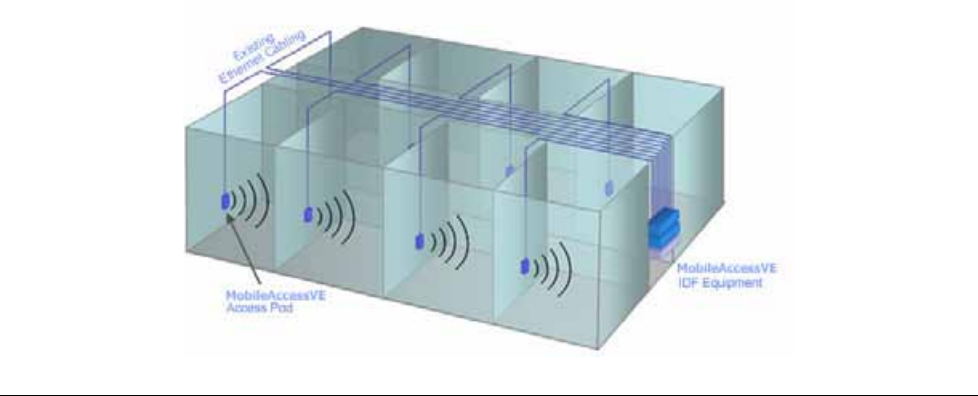
Dual-Band MobileAccessVE Instant Coverage Solution User Manual 1
1 Overview
The MobileAccessVE Dual-Band solution provides enhanced, cost effective, in-building coverage
of two services (from a range of available service combinations) for any (small-to-large) sized
enterprise environment. This solution is quickly and easily deployed using the existing Ethernet
cabling infrastructure, without affecting existing LAN services or performance.
The VE solution converges wireless services from the service provider’s equipment and Ethernet
services from the corporate LAN, via a VE Control Unit located in the communication closet. The
converged services are routed to VE Access Pods (VAPs) installed throughout the enterprise. The
VAPs are distributed on each floor and plug into existing standard Ethernet jacks.
The VAPs provide wireless services coverage via integrated internal antennas (or optional
external antennas). The VAPs also provide Ethernet connectivity to the LAN terminals (that were
previously connected to the jacks).
They are powered via Power over Ethernet (PoE) technology and managed via the VCU located
in the floor’s IDF/Telco closet. For site coverage that requires more than one VCU, several VCUs
can be aggregated under a single Master VCU. The Master VCU provides the interface to the
carrier’s capacity sources and management.
MobileAccessVE seamlessly coexists with the Enterprise LAN and does not consume LAN
capacity. This enhanced Dual-Band coverage solution can be quickly and easily installed with
minimal disturbance to the enterprise. In less than a few hours and with no additional cables
being required, a scalable and flexible solution is provided at a significantly lower total
installation cost.
Currently, the VE Dual-Band system is available for the following band combinations:
· EGSM-UMTS
· CELL-PCS Full Band
· DCS-UMTS
The following figures illustrate
single-tier
and
multi-tier
VE installations.
In a single-tier installation the VCU is connected to both the service provider’s equipment and
the Ethernet switch, and distributes Ethernet and mobile services to up to 12 VAPs distributed
over one more adjacent floors.
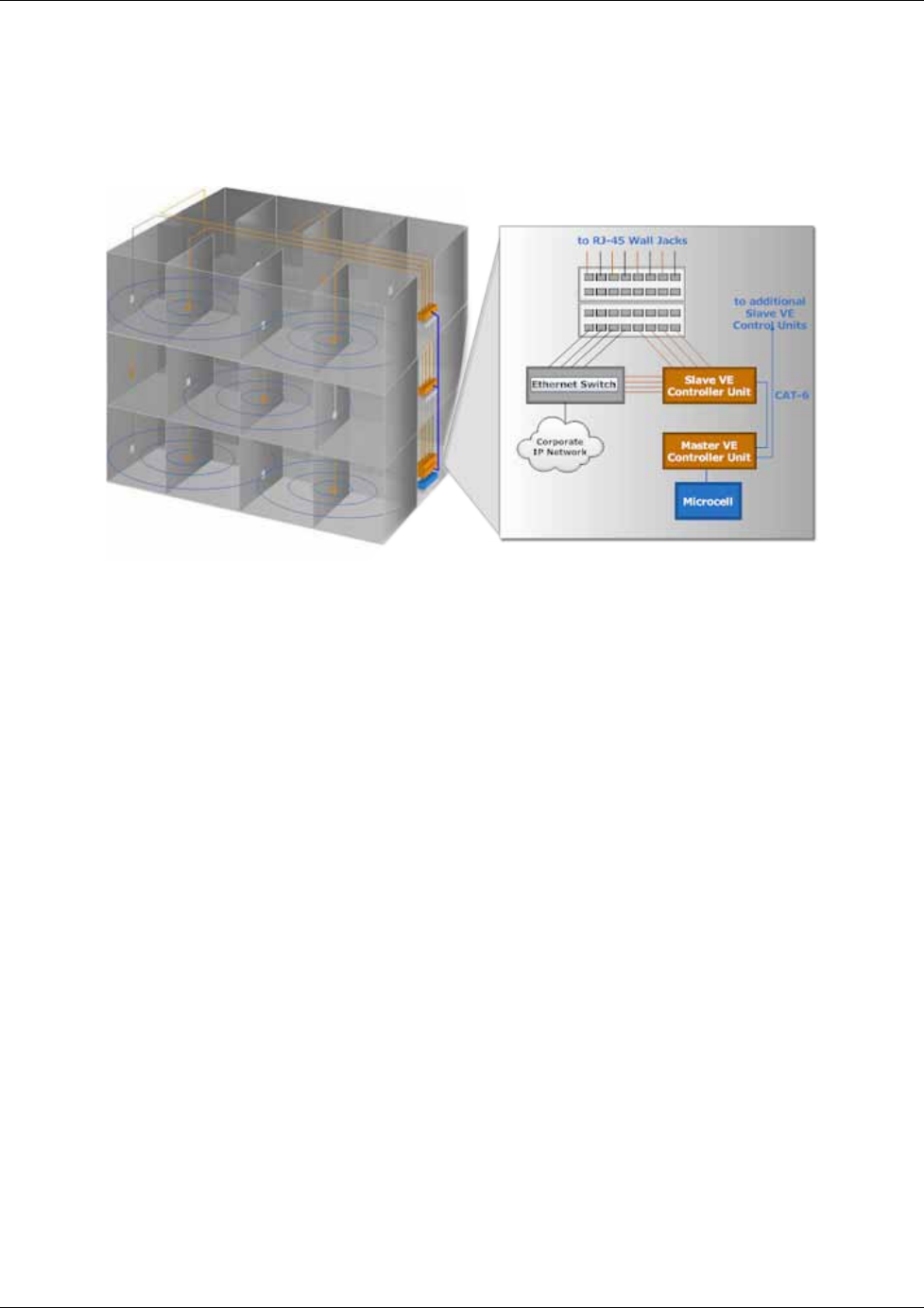
Overview
Dual-Band MobileAccessVE Instant Coverage Solution User Manual 2
Figure
1-1. Single-Tier VE Installation
Multi-tier installation includes the Master VCU that supports up to 12 Slave VCUs. In this type of
installation the provider’s services are fed to the Master VCU through which the Slave VCUs are
controlled and managed.
Figure
1-2. Multi-Tier VE Installation
1.1 Key Features and Capabilities
· Supports the following frequency ranges:
· EGSM: 925 – 960; UMTS: 2110 - 2170
· DCS: 1805 – 1880; UMTS: 2110 - 2170
· Full Band CELL: 869 – 894; Full Band PCS: 1930 - 1990
· Simple installation - Deployed in only a few hours, with minimum disturbance to the
enterprise.
· VAPs connect over existing CAT-5e/6 cabling infrastructure and utilize existing Ethernet
jacks.
· VAPs are remotely powered using Power-over-Ethernet (PoE). Local power is not required.
· Minimum macro-network impact with low power distributed coverage.
· Seamlessly coexists with the Enterprise LAN and does not consume LAN capacity.
· Connects to all types of capacity sources: BTS, Picocells, Femtocells and BDAs.
· VAPs can be easily relocated for coverage modifications as needed.
· Ease of expansion provides “pay as you grow” scalability.
· Support of connected IP devices (Wi-Fi APs, IP Phones, etc) with Ethernet/IP pass through
and PoE maximizes placement flexibility.
· Baseline feature that clearly shows VAPs and VCUs in which communication has been lost
and generates corresponding alarms.
· Remote end-to-end system monitoring, management, and configuration via a single
connection to the master VCU using a standard web browser and SNMP.
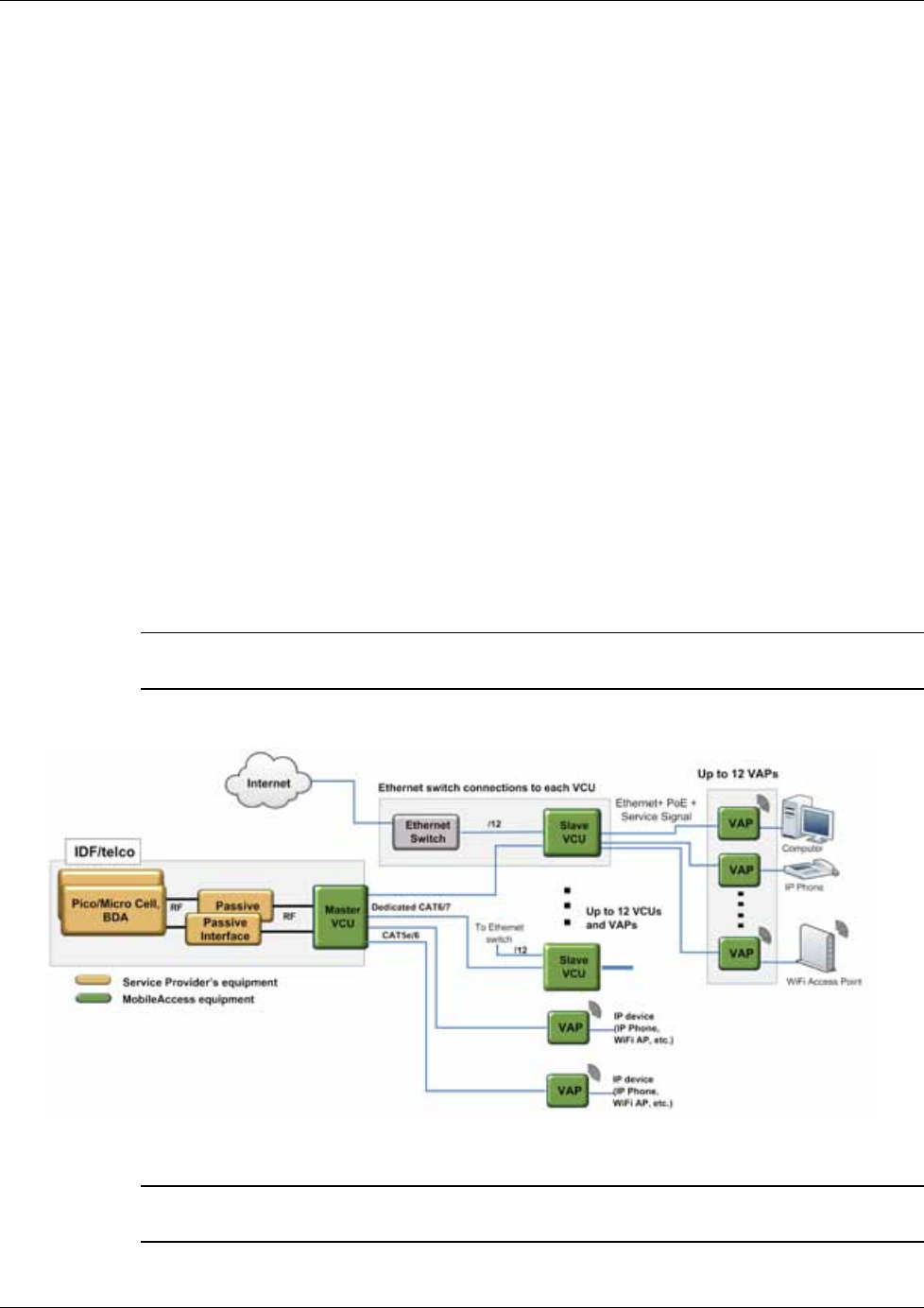
Overview
Dual-Band MobileAccessVE Instant Coverage Solution User Manual 3
1.2 System Architecture
Main Elements - The MobileAccessVE solution is based on the following main elements:
· VE Control Unit (VCU) – installed in the communication room or shaft. Converges the
Ethernet and RF signals and provides secure, central management to up to 12 VAPs or
(Slave) VCUs in any combination. The same unit model can be configured either as Master
or Slave depending on the installation topology:
· Master VE Control Unit (Master VCU) – Installed in the main communication
IDF/Telco closet, interfaces to the service provider’s RF equipment, and provides secure,
central management to up to twelve VCUs and VAP devices in any combination.
· Slave VE Control Unit (Slave VCU) – Used to expand coverage to additional floors.
Installed in the IDF/Telco closet of the relevant floor. Each Slave VCU interfaces the
Master VCU and up to twelve VAPs and twelve Ethernet connections.
The Master and Slave VCUs are connected using
dedicated
CAT-6/7 cables. VCUs distribute
wireless service signals to each VAP along with PoE and where relevant Ethernet signals
from the Ethernet switch, throughout the
existing
CAT-5e/6 infrastructure.
· VE Access Pod (VAP) – These are pluggable antennas distributed at strategic locations
on the floor to provide Ethernet connection to an IP device and wireless coverage of the
service via integrated internal (or external) antennas. Power to VAPs is provided via PoE
from the VCU.
Up to twelve VAPs can be connected to a single VCU using LAN cables (CAT-5e or higher).
Note: If the total number of VAPs in the deployment exceeds 72, consult with MobileAccess
support.
The following figure shows the Multi-tier Dual-Band VE solution architecture.
Figure 1-3. VE Multi-Tier Basic Architecture
Note: Connecting both VAPs and slave VCUs to the master VCU simultaneously is supported
only with VE network elements running SW version 2.6 and above
N
ote: If the Master VCU supports VAPs (in
addition to VCUs), the relevant Ethernet
ports are also connected to an Ethernet
switch.
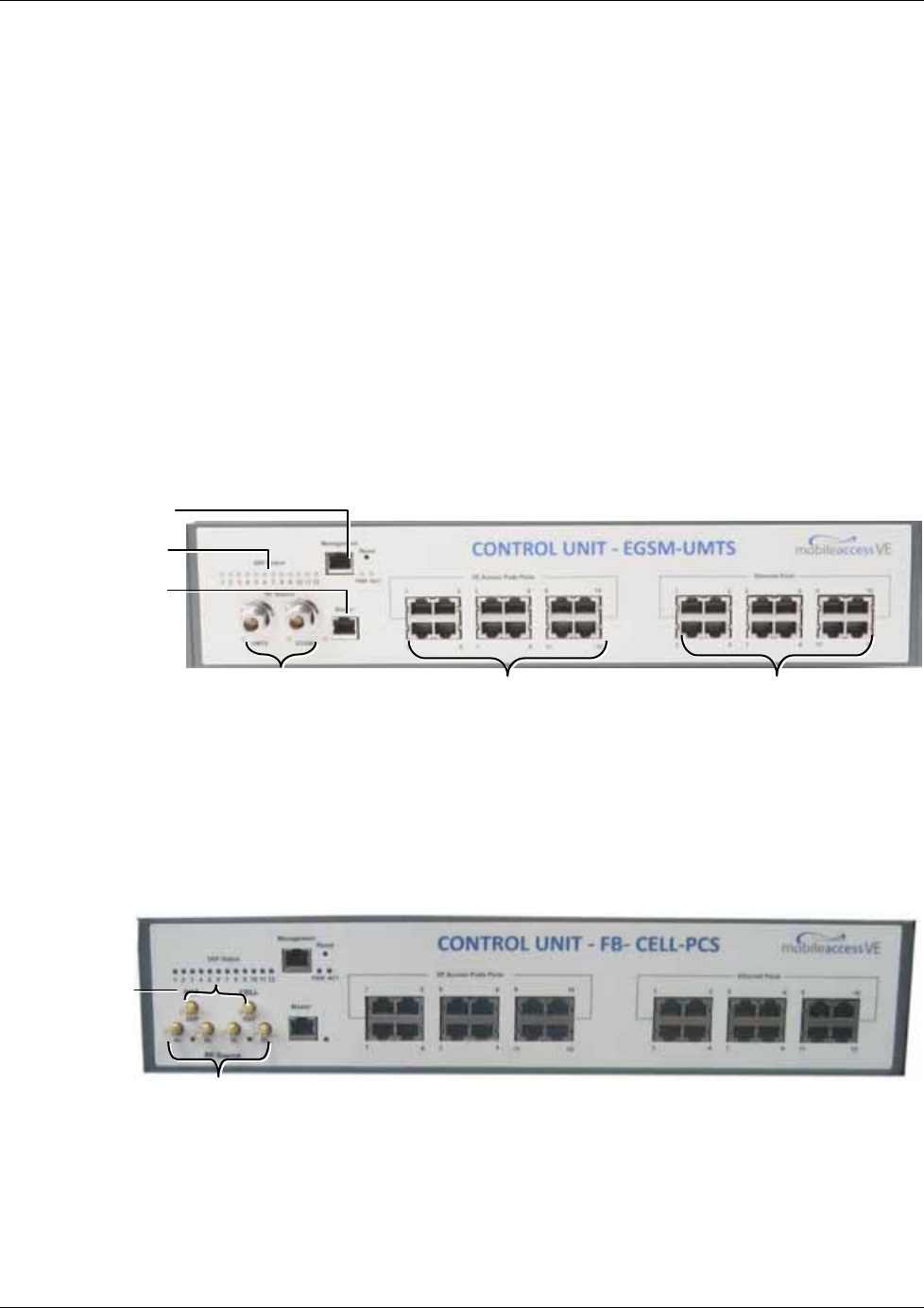
Overview
Dual-Band MobileAccessVE Instant Coverage Solution User Manual 4
1.3 System Elements
This section describes the interfaces of the VE Control Units and Access Pods.
1.3.1 VE Control Unit (VCU)
The VCU can operate as either Master/Standalone or Slave. The front panel supports all the RF,
control and optic interfaces, while the rear panel contains the power and alarms interfaces.
1.3.1.1
VCU Front Panel
The VCU front panel provides interfaces to RF, management VAP, and VCU interfaces. The type
of RF interfaces may vary depending on the VCU model. Below are two models: the top model
supports only Duplex N-type interface, while the bottom model supports both Simplex and
Duplex QMA connections.
Figure 1-4. Example of VCU with Duplex RF Connectors
Figure 1-5: Example of VCU with both Simplex and Duplex RF Connectors
Device
Set the VAP
Ethernet Ports VAP Ports
Web
Management
Master Port
Duplex
QMA
connectors
Simplex QMA connectors
(2 per service)
VAPs status
Duplex connectors
(N-type) 1 per service

Overview
Dual-Band MobileAccessVE Instant Coverage Solution User Manual 5
Interfaces Description
RF Source RF connections to the RF source: simplex or duplex, N-type or QMA depending
on the model.
Management Relevant only for Master or Standalone VCU. RJ45 WEB management
connection to Master or Standalone VCU.
VE Access Pod
Ports 1-12
VAP and or VCU connections (in any combination):
Master VCU – Connections to Slave VCUs or VAPs.
Slave VCU – Connections to VAPs.
Ethernet Ports 1-12 Ethernet switch connections. Relevant for VCUs with connected VAPs. Connect
according to corresponding VAP connections.
Master Relevant for Slave VCUs. Connection towards Master VCU VE Access Pod Ports.
Reset N/A in current version.
Interfaces Description
PWR and ACT LEDs
PWR - VCU power source:
Green - Power OK
Disabled - No power received by VCU
ACT VCU activity LED:
Solid Green – During initialization
Blinking Green – Normal operation
Fast Blinking Green – User activated
VCU Identify
on this VCU
VAP Status
(One LED per Port)
Status of the
corresponding
unit (VAP or VCU)
Blinking Green – Unit is initializing
Solid Green – Normal operation of unit
Solid Orange – Unit is faulty, or unmanaged. This can be due to
mismatch type, VoIP phone, etc.
Fast Blinking Green – User selected “Identify” command on the unit
Off – No VAP or VCU connected to this port.
RF
(One LED per
Service)
Status of connected RF capacity source:
Green – Master VCU only. Normal RF level
Orange – Master VCU only. RF level is either too low, too high,
or service has been turned off by the user.
Off – VCU is Slave.
Master
Status of the connection to the Master VCU:
Off – Master mode (not connected to VCU)
Blinking Green – During attachment process with Master VCU
Solid green – Slave (IF-IF) mode and connected to Master
Table 1-1: VCU Ports Description
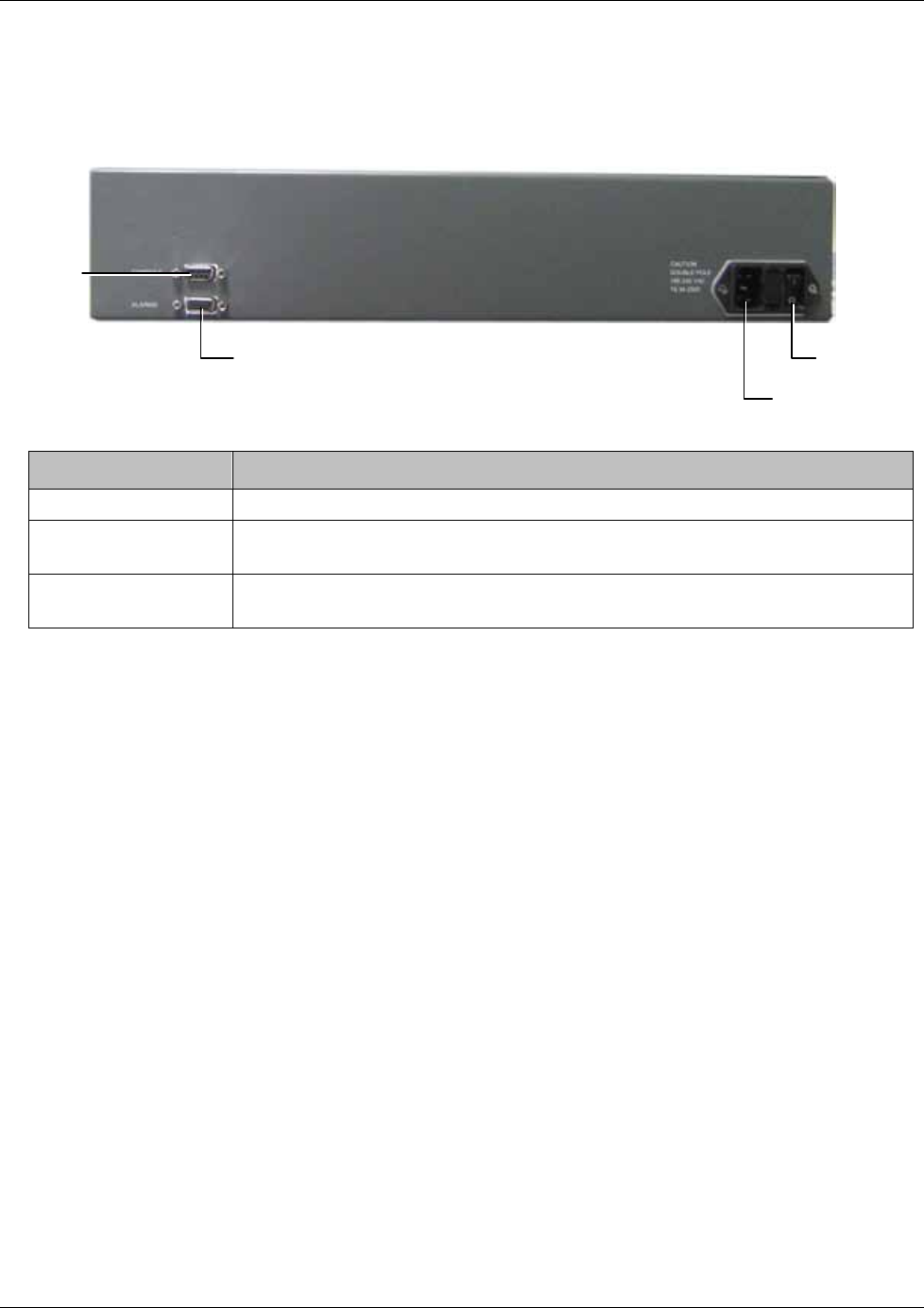
Overview
Dual-Band MobileAccessVE Instant Coverage Solution User Manual 6
1.3.1.2
VCU Rear Panel
The rear panel includes the following: power switch, AC input, AUX alarms, and service
personnel connections.
Figure 1-6. VCU Rear Panel
Table
1-2: VCU Rear Panel Description
Connector Description
Console RS232 local connection for service personnel (D-Type 9)
Alarms AUX Alarms Connections – (See section 4.2.1.1).
In Master/Slave configuration
- relevant only for Master VCU.
Power Input Standard 3-pins AC power connector equipped with an ON/OFF switch. 90-
264V AC, 47-63 Hz AC; 350W power consumption maximum.
1.3.2 VE Access Pod (VAP)
Each VAP supports:
· Internal antennas and two interfaces for external antennas. By default, the VAP is set to
transmit through the integrated internal antennas. To use the external antennas
connectors, select the “External Antenna” option in VAP Config-Service RF tab of the VE
Web GUI application (See section 8.3).
· An Ethernet port for physical Ethernet connection to devices such as a computer, IP phone
or Wi-Fi Access Point.
· Two LED status indictors.
The VAP can be mounted on the wall or placed on a flat surface. Brackets are provided for each
type of installation.
PWR On/Off
Switch
AC Connector
AUX
Alarms
Console
Connector
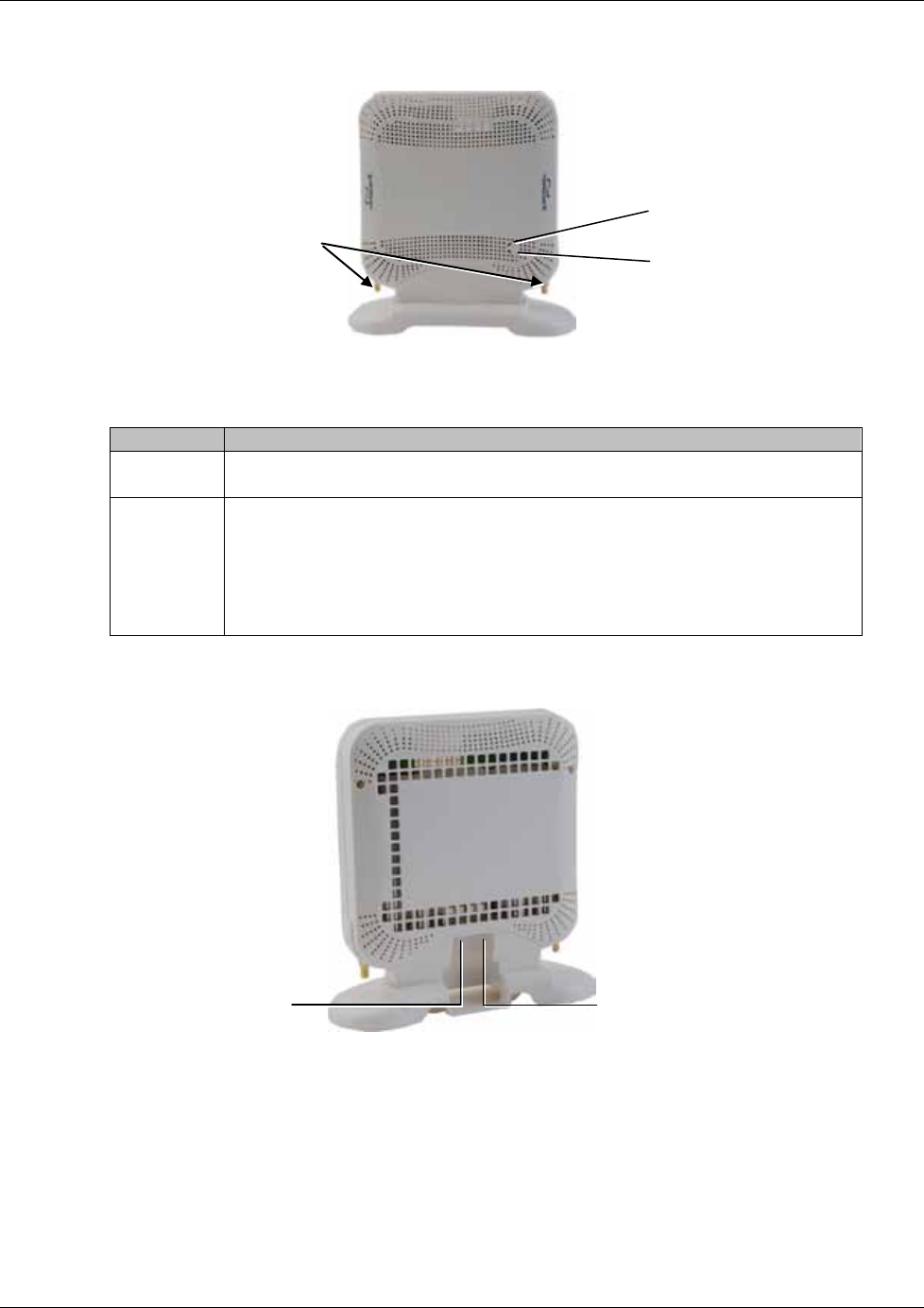
Overview
Dual-Band MobileAccessVE Instant Coverage Solution User Manual 7
The following figure shows the desktop VAP.
Figure 1-7. VE Access Pod-Front
Table 1-3: VAP LEDs
LED
Description
Power Solid Green - Power supplied to VAP
Off - No power supplied to VAP
Activity
Off - No power supplied to VAP or Overall Status of VAP is
faulty
Blinking Blue - Power on, VAP is initializing (connecting to VCU)
Solid Blue - Power on, unit operating normally
Fast Blinking Blue - User invoked “Identify” command on corresponding
VAP
The following figure shows the desktop VAP rear side and the underside view with the CAT-5e/6
patch-cord cable.
Front View
Blue LED (Activity
and Identify)
Green LED (Power)
Rear View
External A
ntenna
Connectors
Figure 1-8. VE Access Pod
RJ-
45
Connector to
RJ-45
Connector to
LAN Terminal
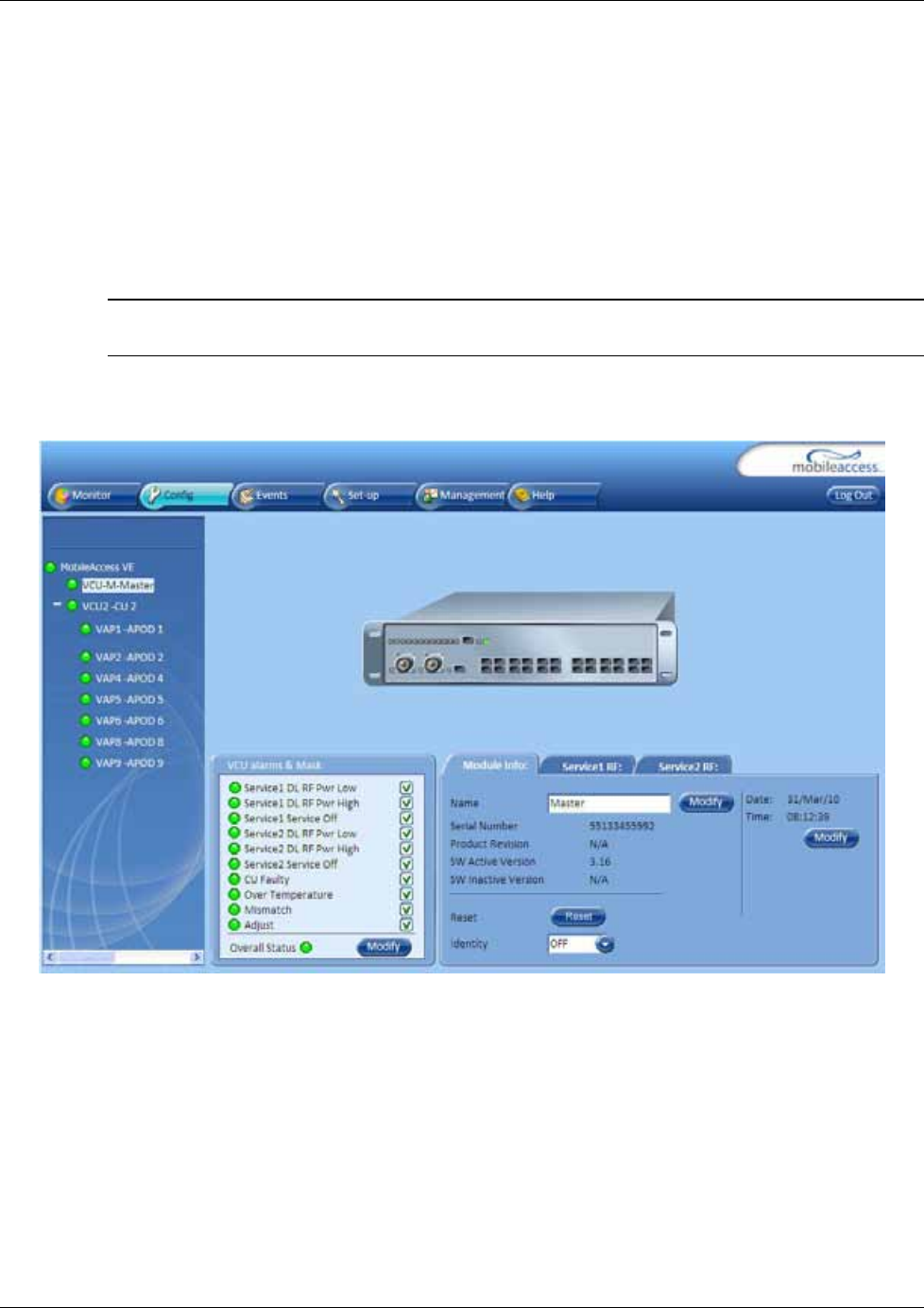
Overview
Dual-Band MobileAccessVE Instant Coverage Solution User Manual 8
1.4 System Monitoring and Management
The MobileAccessVE system (Master VCU, Slave VCUs, and VAPs) is centrally managed via a
single Web connection to the Master VCU. The basic screen in the GUI is the Config tab, which
enables the user to view the system topology and setup parameters, control units, and all Access
Pods connected to the control units.
Note: When locally connecting to a specific Slave VCU, only the VAPs connected to this VCU can
be monitored. When connected to the Master, the entire deployment can be monitored.
The following figure shows the Master VCU with a single Slave VCU and its nine VAPs. The
session is opened by a connection to the Master VCU.
1.4.1 Integration with an External Fault Management System
The MobileAccessVE system can be seamlessly integrated into any existing Fault Management
(FM) system that supports SNMP events. The Master VCU generates a SNMP event for each
relevant system alarm and forwards this trap to the pre-configured IP address of the external
Fault Management system.
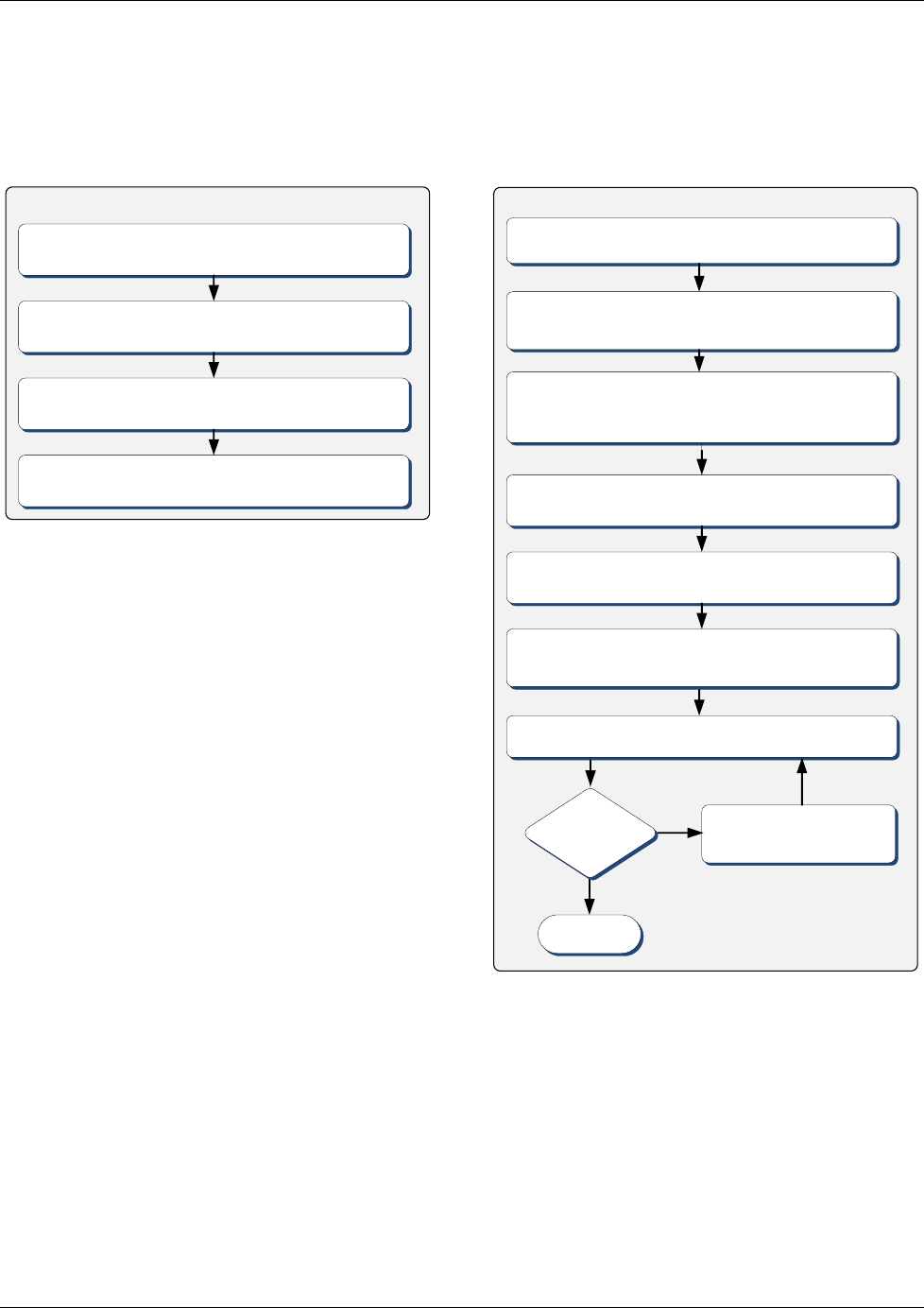
Installation Workflow
Dual-Band MobileAccessVE Instant Coverage Solution User Manual 9
2 Installation Workflow
The following figure summarizes the main steps of the installation procedure:
Verify that all infrastructure requirements are met (includes
verifying that the jacks are wired to the patch panel in the
communication rooms).
Check that Ethernet jacks are available
in all planned VAP locations.
Plan the floor coverage and VAP locations
according to the type/density of the site.
Installation Workflow
Determine the communication rooms to which the VAP
infrastructure is connected (locations for the Slave VCUs).
Install the Master VCU in the IDF/telco shaft.
Complete
Open a local session to the Master VCU and configure the system
parameters (IP, and service parameters: Central Frequency , Max
expected Pin).
Perform a “walk test” and verify coverage around the floor.
Change VAPs locations or
add VAPs
Met
Coverage? No
Install the Slave VCUs and connect them to the Master VCU (verify
that the VCU/VCH LED is green, and RF LEDs turned OFF).
Install the VAPs and connect them to the Ethernet jacks. Connect
the Ethernet appliance (if exists) to the VAP. Check that the VAP is
operational (Blue LED lit). Check that Ethernet connection is OK.
Yes
Install the RF signal sources, connect them to the master VCU
(through passive interfaces) and check that the RF signals are
received by the VCU (i.e. that the RF LEDs are green).
Connect the VCU
VAP
ports to the patch panel, and
the Ethernet Switch to the VCU
Ethernet
ports.
1. Infrastructure Preparation 2. Installation Procedure
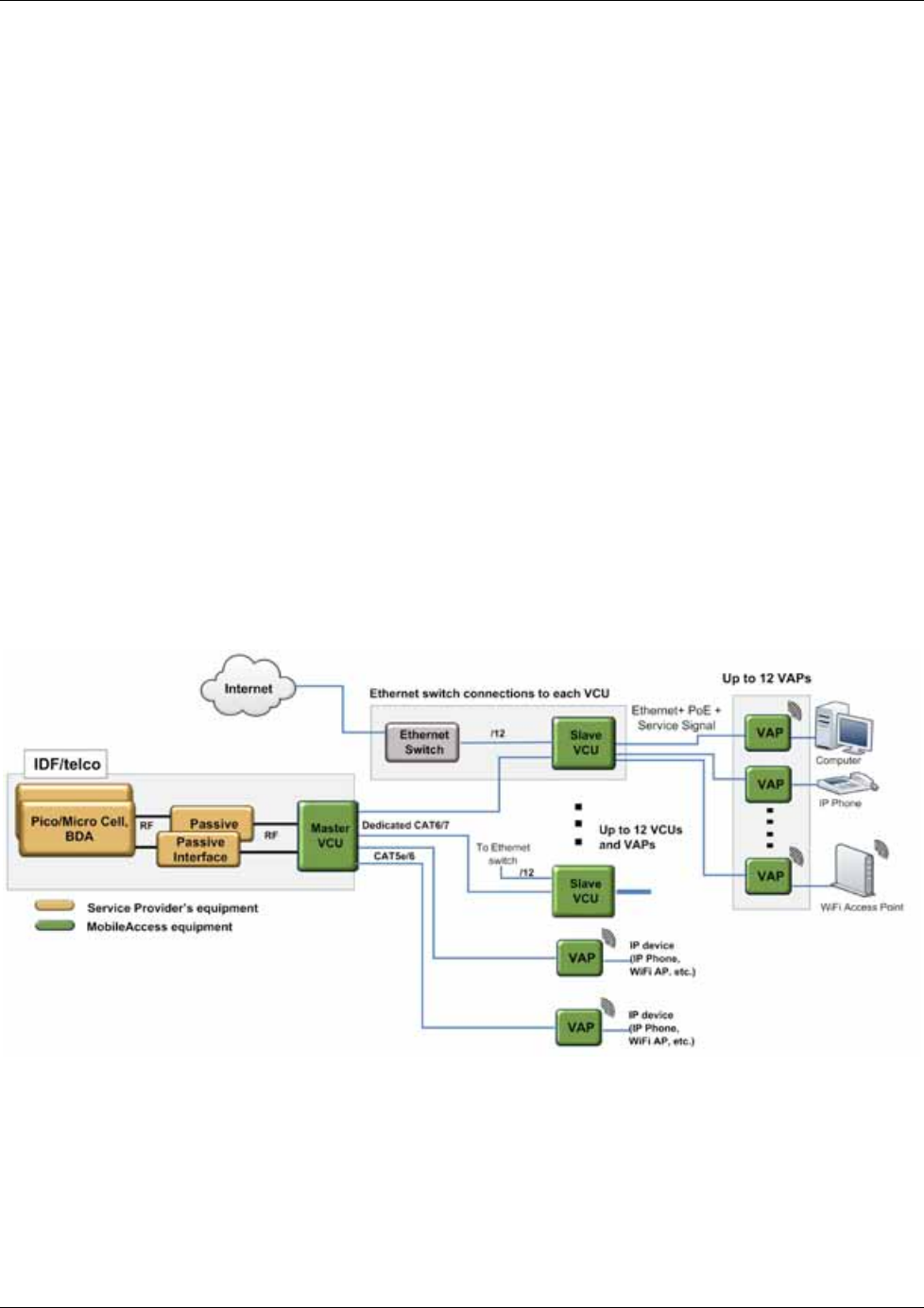
Infrastructure Requirements and Layout Planning
Dual-Band MobileAccessVE Instant Coverage Solution User Manual 10
3 Infrastructure Requirements and Layout
Planning
3.1 General Information on Location and Connections
· Service provider’s RF equipment (Macrocell, Microcell, Picocell, Femtocell, BDA, etc.)
connects to the VCU through a passive interface.
· VCUs:
· Master VCU installed at the main IDF/Telco cabinet and connected to all VCUs.
· Slave VCUs installed at the IDF/Telco cabinet of each covered floor and connected to the
Master VCU, the Ethernet switch, and the VAPs through the cabling patch panel.
· Wireless service signals from Master VCU to VCUs – Routed through dedicated Ethernet
CAT-6/7 cabling.
· Wireless service signals from VCUs to the VAPs – Routed through existing Ethernet CAT-
5e/6 cabling infrastructure.
· VAP location and mounting – Wall or desk mounting. Connection to existing Ethernet jack
and external antenna if required.
· VAP power source - No power connections required. VAPs are power fed from VCU using
PoE (Power over Ethernet) technology.
Figure 3-1. VE Multi-Tier Basic Architecture
N
ote: If the Master VCU supports VAPs in
addition to VCUs, the relevant Ethernet ports
are also connected to an Ethernet switch.

Infrastructure Requirements and Layout Planning
Dual-Band MobileAccessVE Instant Coverage Solution User Manual 11
3.2 Infrastructure Requirements
Ethernet standards specify that the maximum distance between an Ethernet switch and an
appliance (computer, WLAN AP etc) should not exceed 100m (300ft). Therefore, when VE shares
the IT LAN, the maximum distance for a given cable run cannot be longer than 100m (300ft)
between the Ethernet switch and appliance, including all patch cords (from switch to VCU, from
VCU to patch panel, from RJ-45 outlet to VAP, and from VAP to appliance).
Typically the horizontal cabling system will be connected to patch-panels in the communication
rooms. The entire cabling system, including the patch panels and patch cords, should adhere to
the CAT-5e/6 standard. Specifically all pairs of the CAT-5e cable should be wired in the patch
panels (and patch cords).
1. IDF/Telco closet space for one or more VCUs depending on the number and locations of the
installed VCUs: (48.3cm x 51.3cm x 8.88cm) per VCU.
Note: When planning the IDF/Telco shaft, take the RF equipment (picocell/microcell or BDA)
and the VCU into consideration.
2. 350 Watts of AC power to the VCU IDF/Telco closet.
3. Building infrastructure:
· CAT-5e/6 cabling, Shielded Twisted Pair (STP)
· 24 AWG minimum diameter for CAT-5e cabling
· Dedicated CAT-6/7 STP cable from Master VCU to Slave VCUs with run lengths NOT
exceeding 100m (300ft) and no shorter than 10m (33ft).
· CAT-5e/6 STP cable from VCU to each VAP with run lengths NOT exceeding 100m
(300ft) and no shorter than 10m (33ft). VAPs can be connected over existing CAT-5e/6
cabling infrastructure and existing Ethernet jacks without affecting the LAN.
Note: Verify with IT department that the existing cables can support the VE installation. If
available, review the infrastructure documentation to determine cable types and lengths. If
documentation is not available, attempt to visually identify the cable type. Depending on the
cable vendor, the cable type may be listed on the cable sheath. Its’ recommended to use a
Fluke cable tester to measure the cable length of the most remote VAPs.
4. Master VCU Cable Connections:
· (2) N-type female, 50 ohm interfaces to carrier equipment or
· (6) QMA connectors for MIMO1 and MIMO2 Simplex and Duplex connections to carrier equipment
– CELL/PCS Full-Band VCUs only
· Up to (12) RJ-45 interfaces to Slave VCUs and/or VAPs
· (1) RJ-45 interface to Management
· (1) D-Type 9 pins RS-232 interface for local craft
· (1) D-Type 15 pins interface for External Alarms (dry contacts)
5. Slave VCU Cable Connections
· (1) RJ-45 interface to Master VCU (not used in small single-tier deployments)
· (12) RJ-45 interfaces to VAPs

Infrastructure Requirements and Layout Planning
Dual-Band MobileAccessVE Instant Coverage Solution User Manual 12
· (12) RJ-45 interfaces to Ethernet Switch for LAN service
· (1) D-Type 9 pins RS-232 interface for local craft
3.3 Coverage and Installation Planning
Note: The following section provides information required for planning the VAP installation on a
single floor. In a multi-tier installation, this procedure is performed for each individual floor.
The maximal coverage area of each VAP is affected by the density and type of environment
being covered. Therefore, it is recommended to determine the location in two phases:
· Plan the
ideal
location of each VAP in order to achieve complete coverage of the floor.
· Select the
exact
location according to the location feasibility, where each VAP unit may be
wall or desk mounted and an option for an external antenna is available.
The supplied services (wireless only or Ethernet and wireless) depend on the jack to which the
VAP is connected:
· If the jack supports an active Ethernet connection, the VAP will distribute LAN traffic along
with the wireless service. (See section 4.3).
· If the jack is not currently active (not connected to an Ethernet switch), the VAP will
distribute only the wireless services.
This section provides information on coverage criteria in various types of environments (Open,
Standard, Dense, and Merged) and provides rules-of-thumb for various installations of the VAPs.
Note: See section
3.4, which provides a detailed example of installation planning in various types
of environment. It is recommended to review this example after reading this section.
3.3.1 Types of Environments
This section describes the different types of installation environments and provides guidelines for
best coverage of each type of space.
The coverage guidelines in this section are conservative “rule of thumb” estimates of RF
coverage per VAP, meant to be used in scenarios in which detailed designs are not performed.
When the coverage layout is designed, the coverage per VAP is expected to increase by up to
33%. Coverage estimates in this section assume 25% overlap between the coverage areas of
neighboring VAPs to ensure robust, full coverage throughout the enterprise with no “dead
zones”.
The coverage guidelines in the following tables are provided for the
higher
frequency bands
(UMTS & PCS). The lower frequency bands (DCS, EGSM & CELL) are omitted from the tables
since coverage in these bands will be better than that of the higher frequency bands. The
coverage of a dual-band system will be determined by the higher frequency band (i.e. PCS for
CELL/PCS and UMTS for EGSM/UMTS and DCS/UMTS).

Infrastructure Requirements and Layout Planning
Dual-Band MobileAccessVE Instant Coverage Solution User Manual 13
3.3.1.1
Standard Environment
A standard environment is a traditional office environment with offices, hallways, and scattered
cubicles.
Table 3-1: Standard Environment Installation Distances
Band PCS PCS UMTS
Technology CDMA or GSM WCDMA WCDMA
Downlink Frequency 1900 MHz 1900 MHz 2100 MHz
Signal Propagation from VAP 67 feet (20.5 m) 64 feet (19.5 m) 57.5 feet (17.5 m)
Recommend Spacing Between VAPs 134 feet (41 m) 128 feet (39 m) 115 feet (35 m)
Recommended Maximum Distance
of VAPs from Outer Walls 67 feet (20.5 m) 64 feet (19.5 m) 57.5 feet (17.5 m)
Coverage Area per VAP 14,250 sqft (1,324 sqm)
12,750 sqft (1,185 sqm)
10,425 sqft (969 sqm)
3.3.1.2
Open Environment
An open environment is an environment with minimal obstacles (e.g. walls). This type of space
can be a large conference or meeting room, cubical areas, lobby, or an atrium.
Table 3-2: Open Environment Installation Distances
Band PCS PCS UMTS
Technology CDMA or GSM WCDMA WCDMA
Downlink Frequency 1900 MHz 1900 MHz 2100 MHz
Signal Propagation from VAP 90 feet (27 m) 82.5 feet (25 m) 67 feet (20.5 m)
Recommend Spacing Between
VAPs 180 feet (55 m) 165 feet (50 m) 134 feet (41 m)
Recommended Maximum
Distance of VAPs from Outer
Walls 90 feet (27.5 m) 83 feet (25 m) 67 feet (20.5 m)
Coverage Area per VAP 25,425 sqft (2,362 sqm) 21,350 sqft (1,983.5 sqm)
14,250 sqft (1,324 sqm)
3.3.1.3
Dense Environment:
A dense environment consists of a relatively large amount of walls, offices, equipment, tall file
cabinets, bookshelves, and other items that could potentially impact the wireless signal.
Examples include dense offices, hospitals, and manufacturing spaces.
Table 3-3: Dense Environment Installation Distances
Band PCS PCS UMTS
Technology CDMA or GSM WCDMA WCDMA
Downlink Frequency 1900 MHz 1900 MHz 2100 MHz
Signal Propagation from VAP 64 feet (19.5 m) 60 feet (18 m) 45 feet (13.5 m)
Recommend Spacing Between VAPs 128 feet (39 m) 120 feet (36 m) 90 feet (27.5 m)
Recommended Maximum Distance
of VAPs from Outer Walls 64 feet (19.5 m) 60 feet (18 m) 45 feet (13.5 m)
Coverage Area per VAP 12,750 sqft (1,185 sqm)
11,250 sqft (1,045 sqm)
6,300 sqft (585 sqm)

Infrastructure Requirements and Layout Planning
Dual-Band MobileAccessVE Instant Coverage Solution User Manual 14
3.3.1.4
Combination of Environments
In areas with a combination of environments, place VAPs on the border between the different
environment types slightly closer to the denser area.
For example, in a cubical area with the outside wall having offices, simply locate the VAPs a little
closer
to the outside offices
to provide coverage through the office walls. (See VAPs 11 and 13 in
the floor plan map in section 3.4.3.). To ensure maximal coverage, VAPs can be re-located or
added until coverage gaps are filled.
3.4 Planning VAP Layout
The following section describes the steps of planning VAPs along the covered floor. At the end of
this section an example of a planning map is provided.
Note: It is highly recommended to use a floor plan when planning the VAPs locations.
3.4.1 RF Coverage Factors
It is important to note the type of factors that can severely impact RF coverage, and should be
avoided:
· Metallic Structures such as elevators, high file cabinets, and some moveable metallic
partitions severely degrade RF signals. All efforts should be made to locate VAPs in front
of, or above metallic objects (desks, filing cabinets) to allow the signal to propagate.
· Wall Materials such as concrete, tile, and cinderblock, as well as bathroom fixtures
typically have fairly high signal attenuation and should be considered as dense spaces.
· Types of Glass that have metallic coatings can affect RF coverage, typically exterior or
mirrored. However this issue is not normally encountered inside a building.
3.4.2 Mapping Locations
To Map the VAP Locations
1. Map out the available Ethernet jack locations and mark all CAT-5e/6 drop locations on the
floor plan map.
TIP: The size and number of the ceiling tiles can be used to measure distances.
2. Using the floor plan and the VAPs coverage guidelines (Provided in section 3.4.3), mark
approximately where you would like to place each VAP in the facility.
VAPs may be added or removed at anytime for optimal coverage.
3. For each jack being used to connect a VAP, check if the jack is already connected to the
Ethernet switch. .
4. Connect the Ethernet cables corresponding to the selected jacks according to section 4.3.
5. It is also recommended to check the area where each VAP will be installed to ensure that the
installation is feasible.
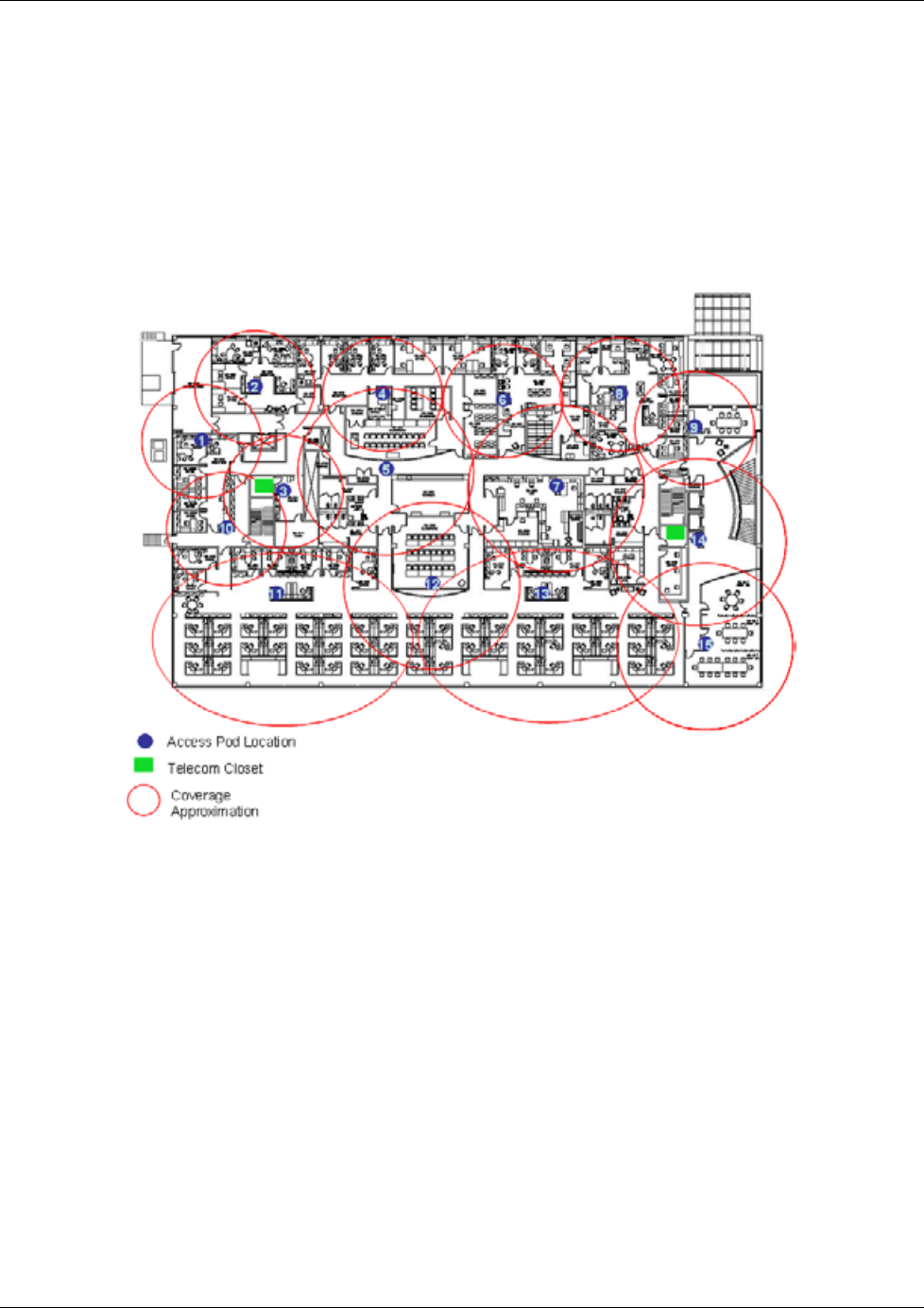
Infrastructure Requirements and Layout Planning
Dual-Band MobileAccessVE Instant Coverage Solution User Manual 15
3.4.3 Optional Directional Antennas
Each VAP has an integrated internal antenna that provides isotropic radiation. To prevent
interference and improve coverage, connect directional antennas to VAPs installed near outer
walls. The VAP antenna parameter must be set accordingly via the Web GUI. (See section 8.3).
3.4.4 Installation Plan Example
The Following figure shows a floor plan map with all required marks:
Figure 3-2. Floor Plan Example
Notes:
· The red VAP coverage circles have an approximate radius of 45, 60 and 70 foot (14, 18
and 21 meters) for the small, medium and large circles respectively. Diagram is drawn
according to the guidelines for UMTS service, given in section 3.3.1.
· VAP 3 is surrounded by the bathroom and stairwell, which are considered dense objects
and would reduce coverage in that area by the other VAPs.
· VAP 5 is an example of a unit that provides good coverage down the hallways in an Open
Environment.
· VAPs 11 and 13 are placed closer to the offices to provide better coverage to them, but on
the open side will actually cover a much greater area. This is why the coverage is larger
and shown here more as an oval than a circle.
· The area between VAPs 7 and 14 would probably be the lowest coverage spot in the
building because of the bathrooms and stairwell on either side. If after the system is
installed, this area is still a little low on coverage, a VAP can be added, but it may also be
covered by VAP 14.
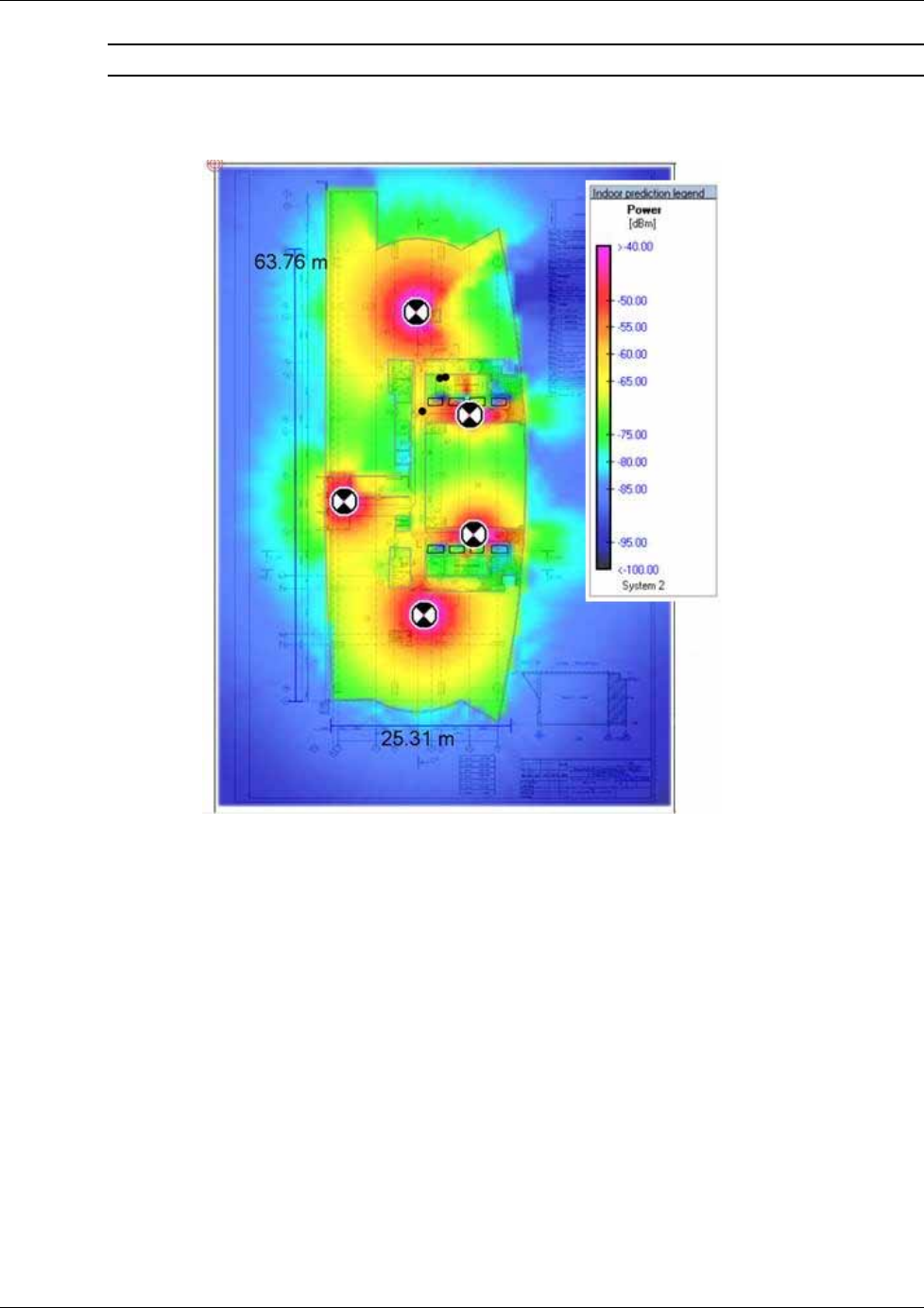
Infrastructure Requirements and Layout Planning
Dual-Band MobileAccessVE Instant Coverage Solution User Manual 16
Note: The plan can be modified at any time by moving the units around or by adding units.
The following figure depicts an actual measured quantified coverage of a floor area planned
according to the above rules.
Figure 3-3. Distributed VAPs propagation, 12dBm output power @ 1.8 GHz
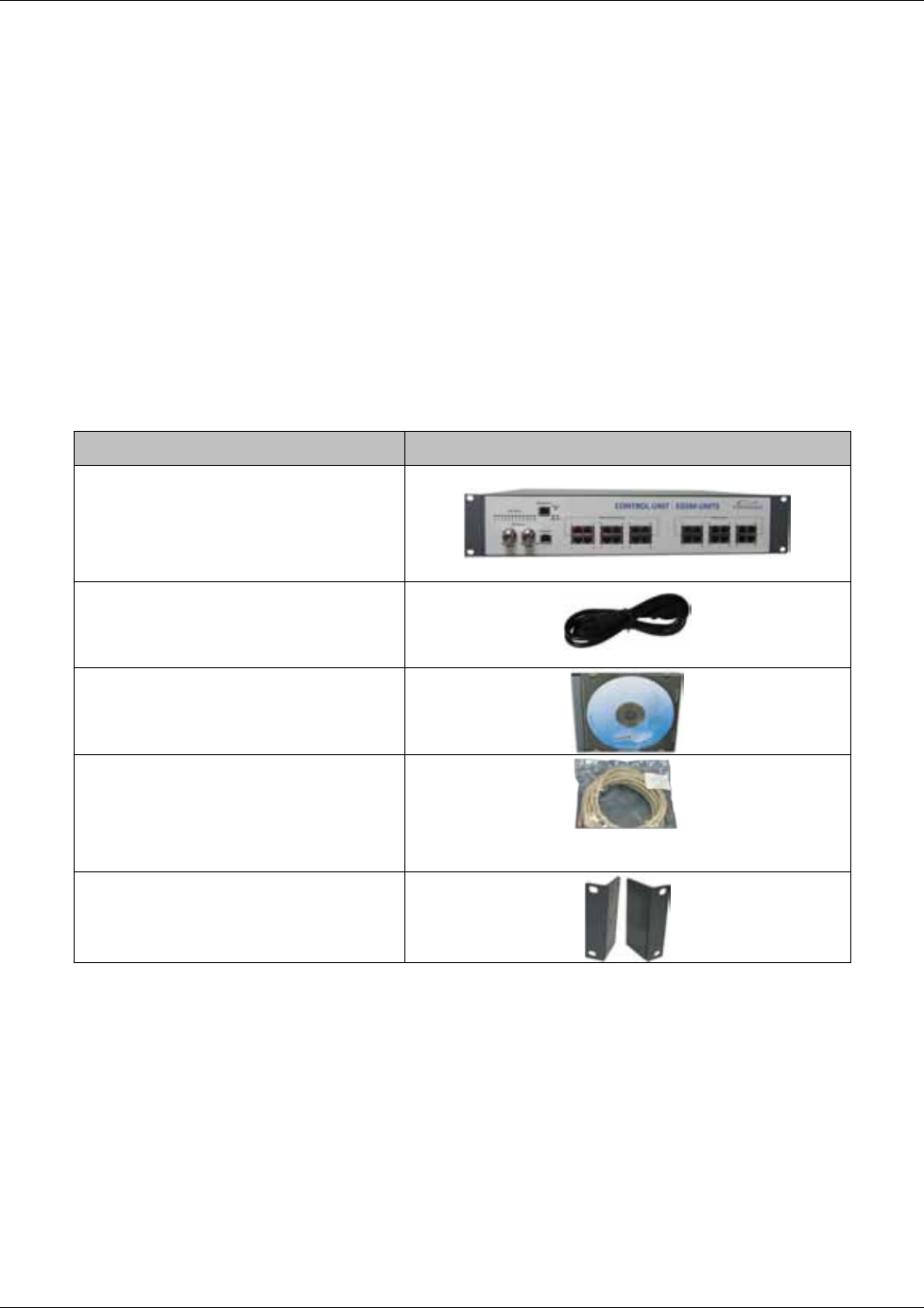
VCU Unit Installation and Provisioning
Dual-Band MobileAccessVE Instant Coverage Solution User Manual 17
4 VCU Unit Installation and Provisioning
This chapter describes the installation and basic configuration procedures for VE Control Units
(VCU) located on each floor.
In addition, this chapter describes the how to shift the relevant Ethernet connections required
for the VAPs.
These should be performed only after planning the floor coverage and installation locations, as
described in the previous sections.
4.1 VCU Kit Contents
The VE VCU Kit includes:
Item Description Image
Dual-Band VE Control Unit (VCU) Kit
Note: The image shown here is only an
example. The supplied unit may differ in
connectors.
Power Cord
VE SW CD
Local Configuration Cable (Crossed
RJ-45 cable)
Brackets for securing the VCU to a
19” rack (Shipped assembled to the
VCU)
Table 4-1: VCU Kit
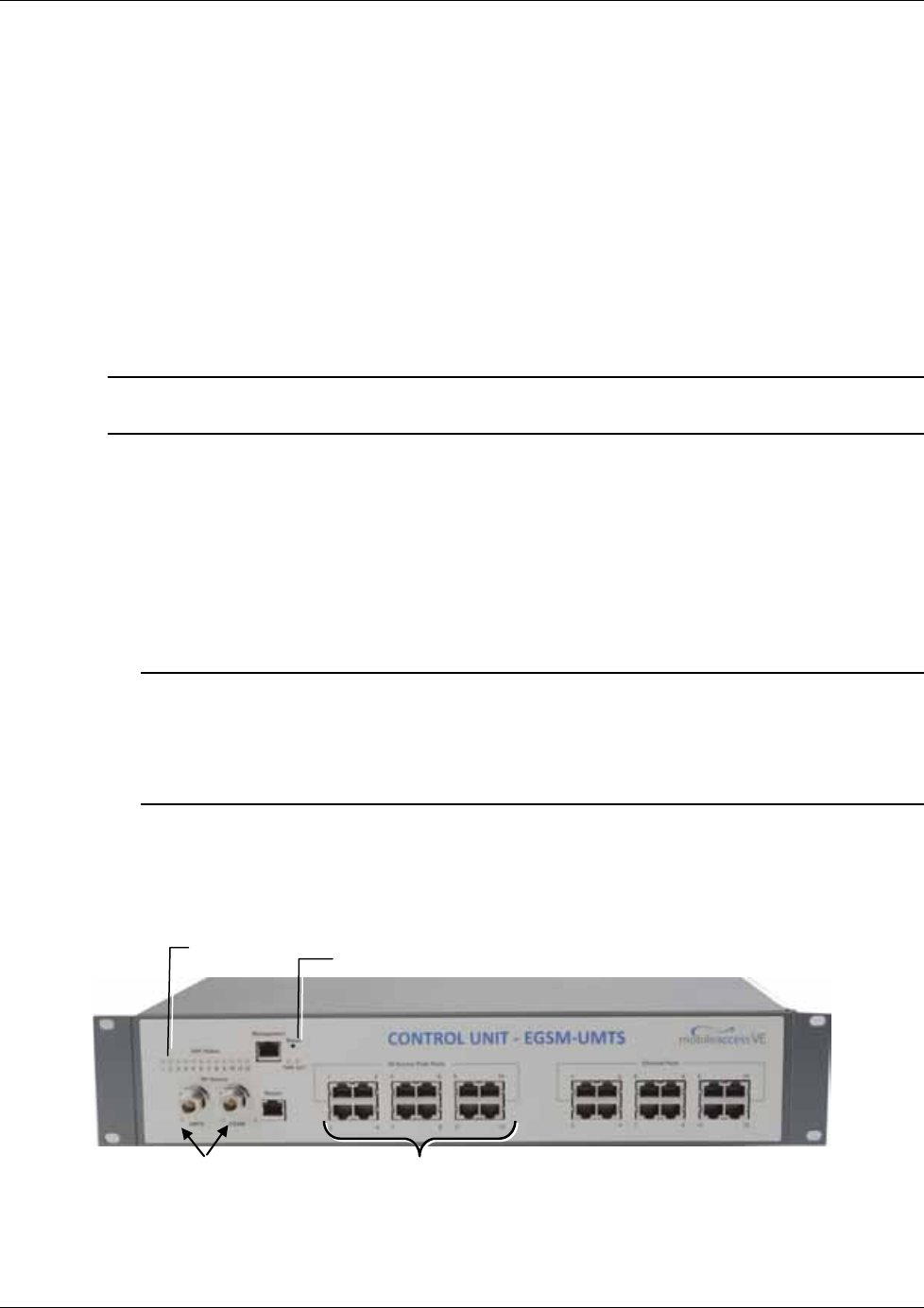
VCU Unit Installation and Provisioning
Dual-Band MobileAccessVE Instant Coverage Solution User Manual 18
4.2 VCU Physical Installation
This section describes the physical installation and connections of the Master VCU, Slave VCUs,
and the VAP Ethernet connections to the relevant VCUs.
4.2.1 Master VCU Installation
The VE Control Unit can be installed as a Master VCU and control up to (12) Slave VCUs and/or
VAPs and is installed in the main IDF/Telco closet. This section describes the Master VCU
installation procedures.
Note: When Master VCU only supports Slaves (no VAPs), the control units’ Ethernet Ports are
not relevant and are not in use.
1. Install the Master VCU in the main IDF/Telco closet. The Master VCU can be installed in a
rack, placed on a shelf, or secured using the supplied bracket.
2. Apply power to the Master VCU and verify that the PWR LED is lit. Also verify that the unit
ACT LED completes initialization (blinking light) and shows a solid green light.
3. Connect (or request the service provider’s service personnel to connect) the provider’s
signal source (Macrocell, Microcell, Picocell, or BDA etc.) to the Master VCU front panel
RF ports (through passive interface). Power on the signal sources.
Note 1: CELL/PCS Full-Band VCUs can be connected to the RF source through simplex or
duplex connections.
Note 2: Verify that the Master VCU source LED (See following figure) is GREEN, indicating an
RF signal according to Max Expected Pin. If after connecting the capacity source, the LED
remains RED, verify that the Max Expected Pin is configured properly and service is enabled.
4. To connect VCU Slaves to the Master VCU, connect the Master VCU VAP ports to the
Slave VCUs VCU/VCH ports via the patch-panel that feeds the dedicated CAT-6/7 cabling
system.
Figure 4-1. Master VCU Connections
RF Ports*
VAP Ports 1-12
ACT LED
VAP Status
LEDs
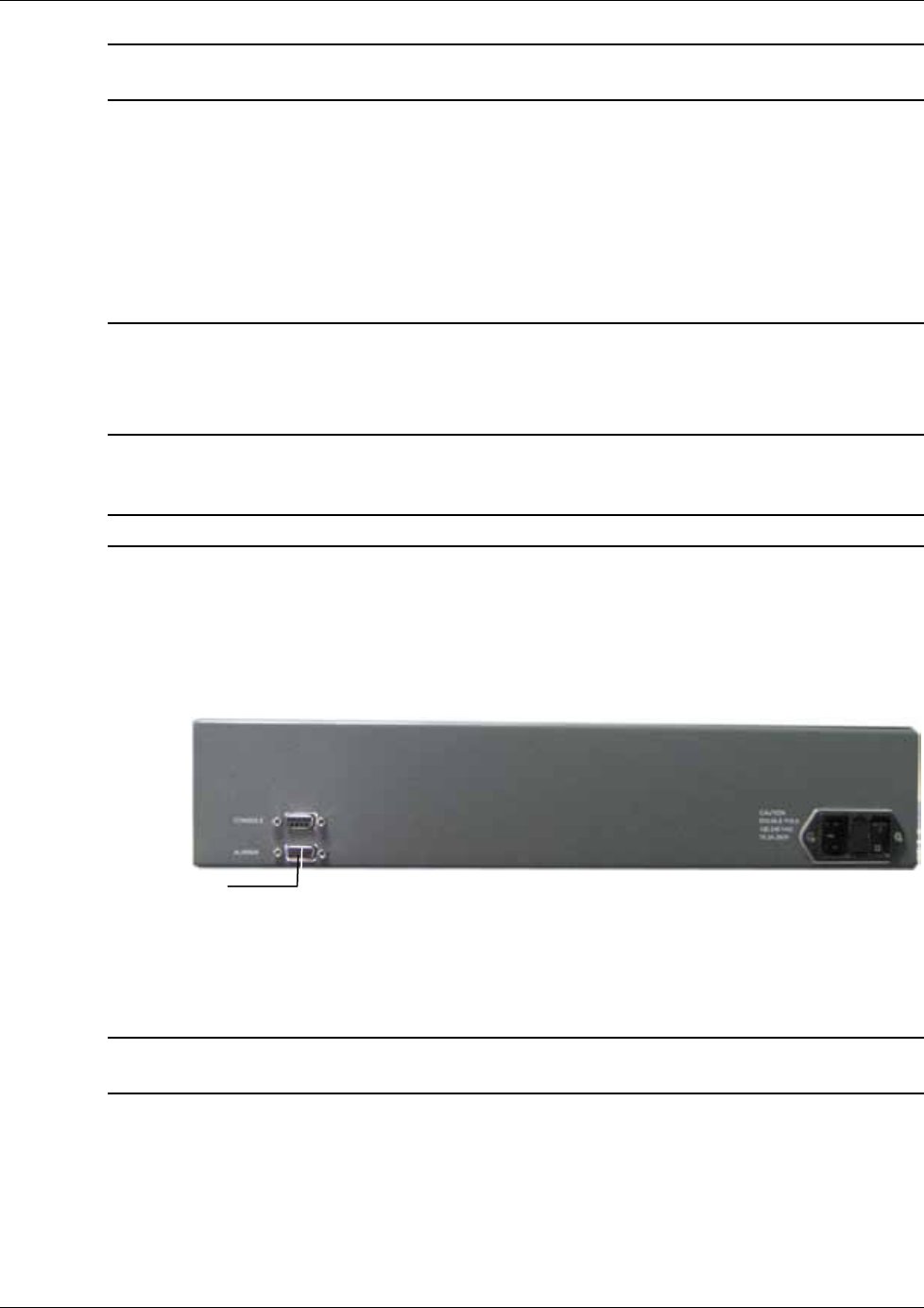
VCU Unit Installation and Provisioning
Dual-Band MobileAccessVE Instant Coverage Solution User Manual 19
*NOTE: RF ports differ depending on the VCU model. For example, Full-Band CELL/PCS VCU
models include QMA RF connectors supporting both simplex and duplex connections.
5. To connect Auxiliary alarms refer to section 4.2.1.1.
Note: The connector is located on the
controller rear panel.
6. According to VAPs layout plan (as explained in section 3.4.2) connect the Ethernet switch
cables (See section 4.3 for a more detailed explanation).
· If the requested jack is already in use, disconnect it from the Ethernet switch and re-
connect it to the corresponding Ethernet port in the Slave VCU front panel.
Note: After the Slave VCUs are connected (according to section
4.2.2) and the VAPs (according
to chapter
5 ), verify that that the Master VCU VAP Status LEDs which correspond to the
connected Slave VCUs and VAPs, complete initialization (blinking light) and show a solid green
light.
4.2.1.1
Master VCU Alarm Output Connections
Note: For Master/Slave VCU configuration, the Alarms are relevant only for the Master VCU.
The controller can provide Major and Minor Output Alarms. These alarms can be connected
directly to either the auxiliary input of the Base Station, or to any additional dry-contact
application.
The auxiliary connections are performed through the Master VCU rear panel Alarms port as
shown below.
Figure 4-2. Master VCU Alarms Connections
A Major Alarm is generated when there is an alarm condition in one or more VCUs, while a Minor
Alarm is generated when there is an alarm condition in one or more of the VAPs.
Note: If only one alarm is required (Minor or Major) an external connection of a wire jumper
between pins 8 and 13 is necessary (normally closed).
Alarms Port for
Auxiliary Connections
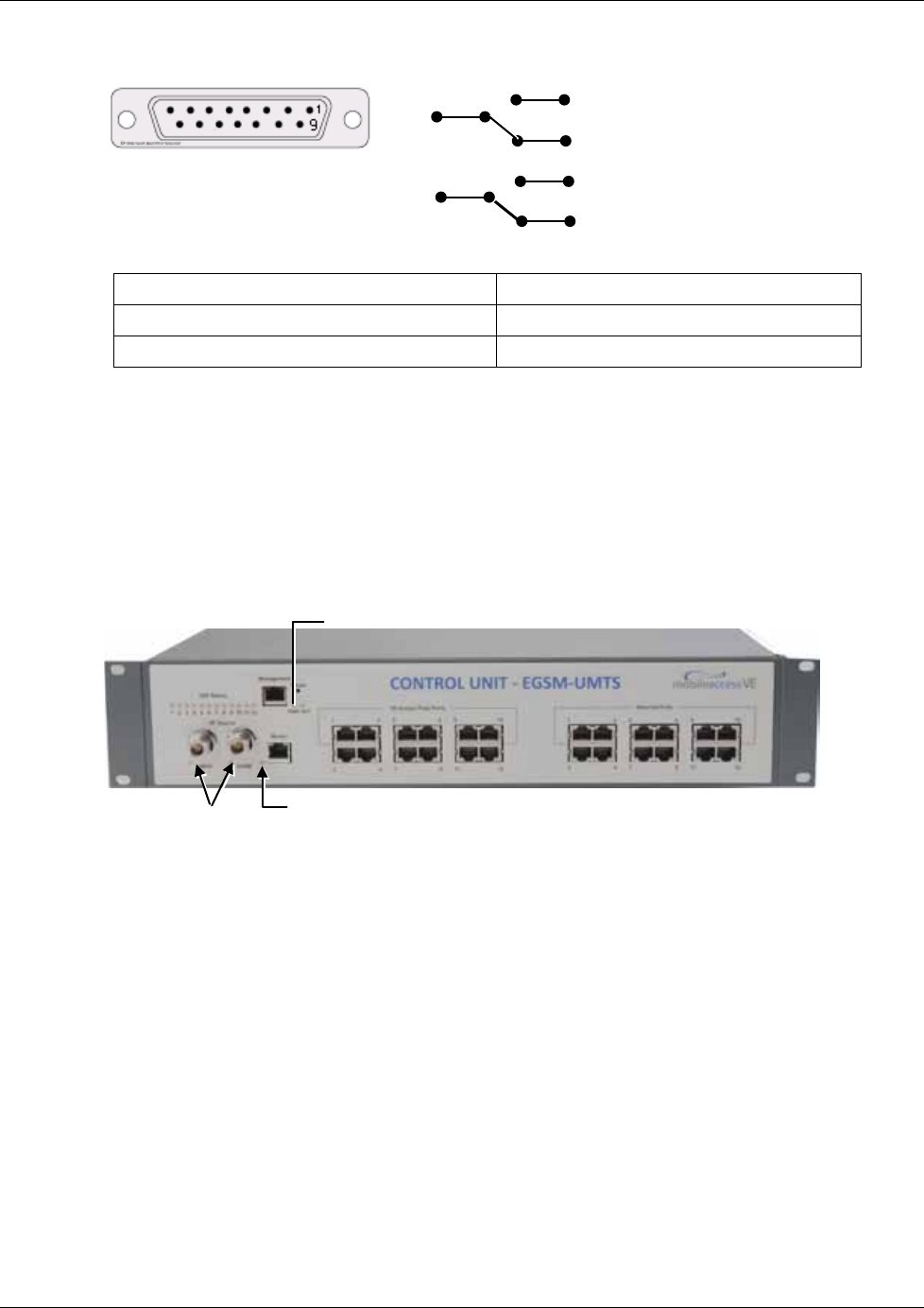
VCU Unit Installation and Provisioning
Dual-Band MobileAccessVE Instant Coverage Solution User Manual 20
Connect the relevant alarms according to the connector pinout:
Table 4-2. Alarms Connector – used pins
8 – Major Error Signal (Normally closed) 7 – Minor Error Signal (Normally open)
11 – Major COM 12 – Minor COM
15 –Major Error Signal (Normally open) 13 – Minor Error Signal (Normally closed)
4.2.2 Slave VCUs Installation
1. Install the Slave VE Control Unit (VCU) in the IDF/Telco closet corresponding to the floor
being covered. The Slave VCU can be installed in the rack using the supplied bracket in the
IDF/Telco closet. Apply power to the Slave VCUs and note that the VCU PWR LED is lit. Note
that the unit ACT LED completes initialization (solid light) and shows a blinking green light.
(See Figure 4-3).
Figure 4-3. VCU PWR, RF and Master LEDs (Example above shows EGSM-UMTS unit)
2. Connect the Slave VCU front panel Master port to the Master VCU VAP port via the patch
panel using dedicated CAT-6 cables. Verify that the Master LED completes initialization
(blinking light) and shows a solid green light. The RF LEDs (of both services) should turn
OFF.
PWR LED
Master LED
RF Source LEDs
(One per Service)
1
1
8 Major Alarm
1
7
1
Minor Alarm
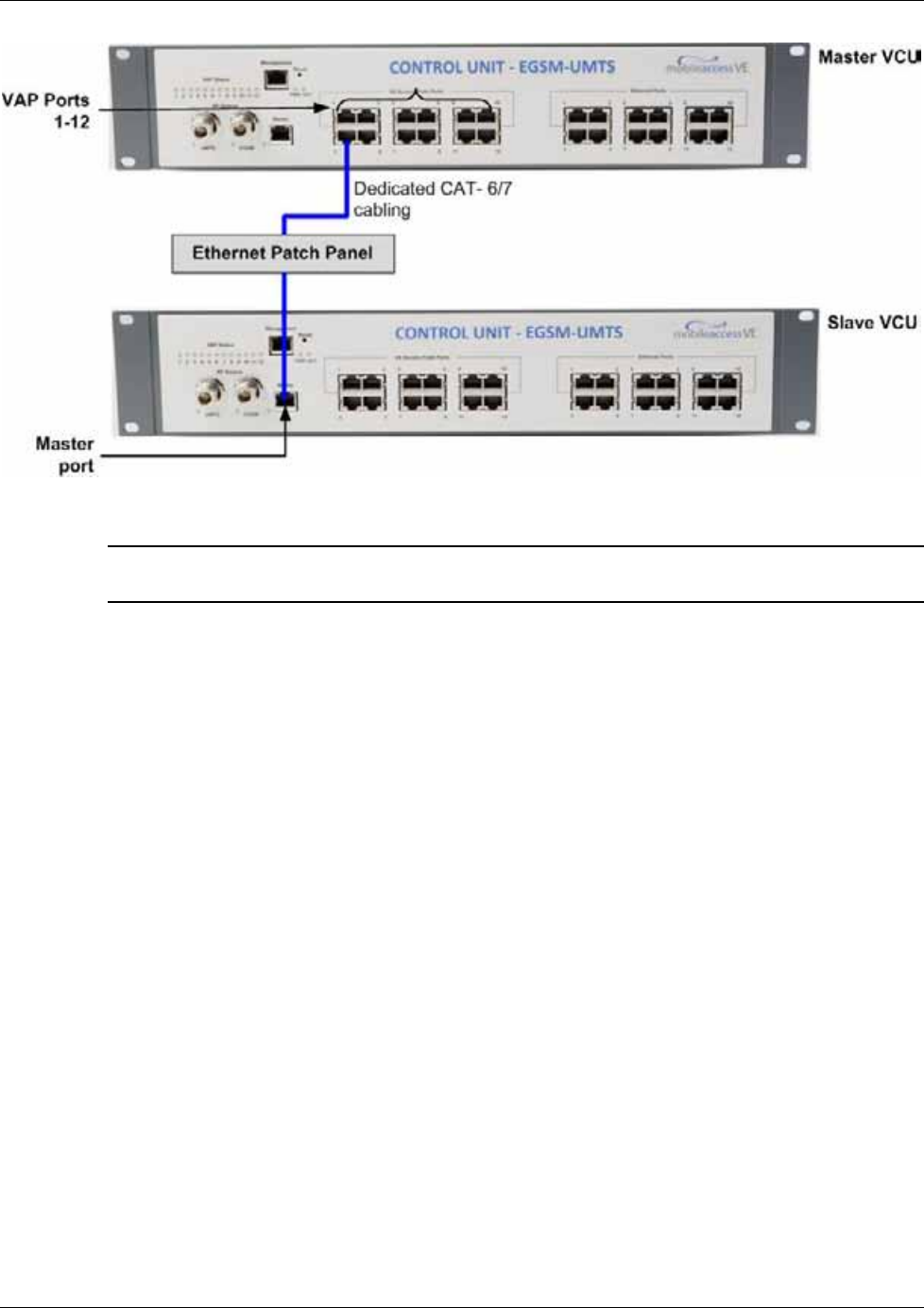
VCU Unit Installation and Provisioning
Dual-Band MobileAccessVE Instant Coverage Solution User Manual 21
Figure 4-4. Master and Slave VCU Connections
NOTE: When control unit functions as Master VCU the VCU VAP ports also serve as Slave VCU
connection ports.
3. Connect the Slave VCU VAP ports to the patch-panel that feeds the existing structured CAT-
5e/6 cabling system.
4. According to VAPs layout plan (as explained in section 3.4.2), connect the Ethernet switch
cables (See section 4.3 for more detailed explanation).
· If the requested jack is already in use, disconnect it from the Ethernet switch and re-
connect it to the corresponding Ethernet port in the Slave VCU front panel.
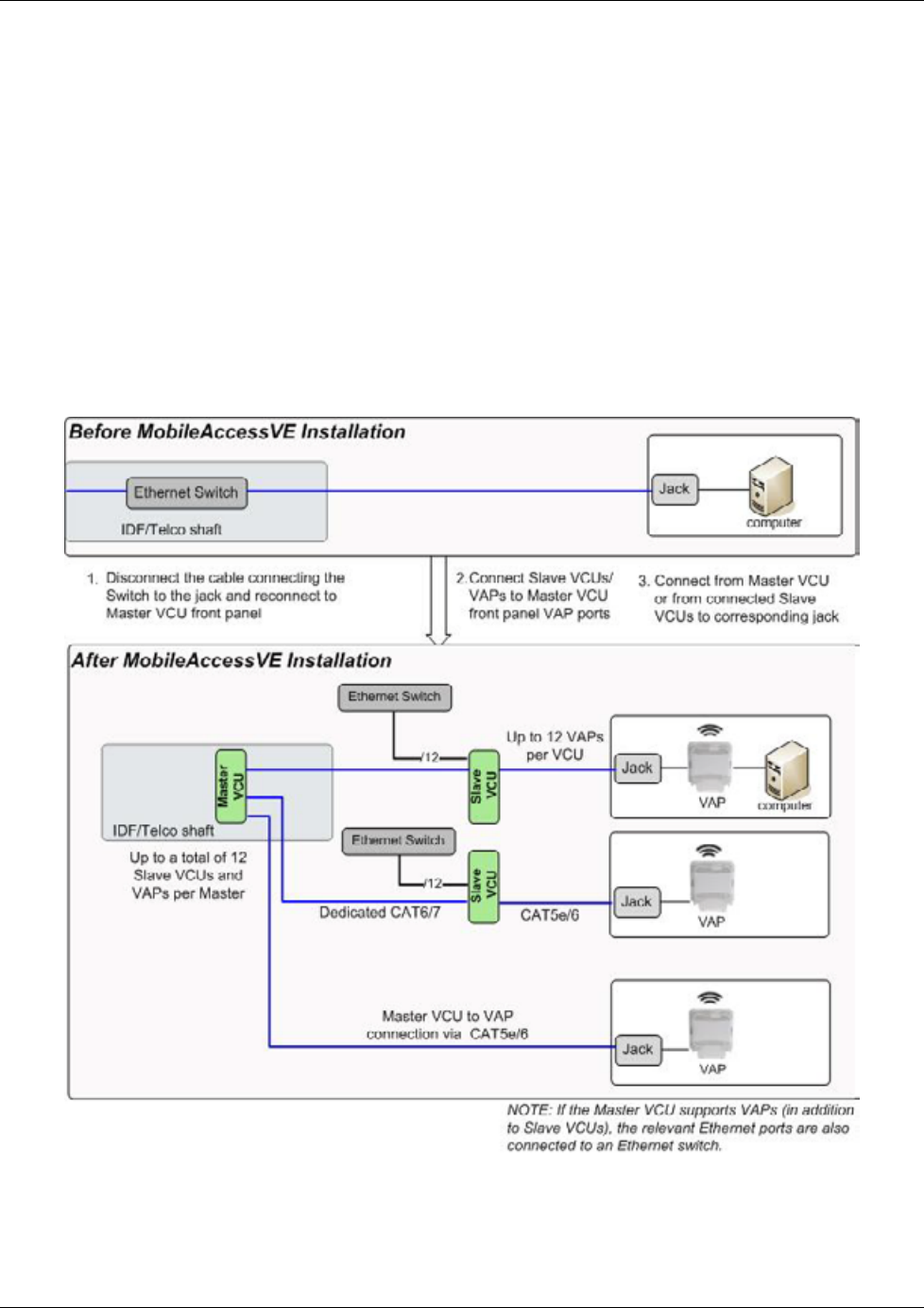
VCU Unit Installation and Provisioning
Dual-Band MobileAccessVE Instant Coverage Solution User Manual 22
4.3 Ethernet Cable Connections to VAPS
This section describes the how to perform the relevant Ethernet LAN connections to the VAPs
from the VCUs via the Ethernet switch (See section 4.3.1) and provides a description of the PoE
transferred between the VCU and the VAPs (See section 4.3.2).
4.3.1 Shifting Relevant Ethernet LAN Connections
For VAPs installed on currently ACTIVE Ethernet ports, shift the relevant Ethernet LAN
connections to the Ethernet ports on the Master or Slave VCU.
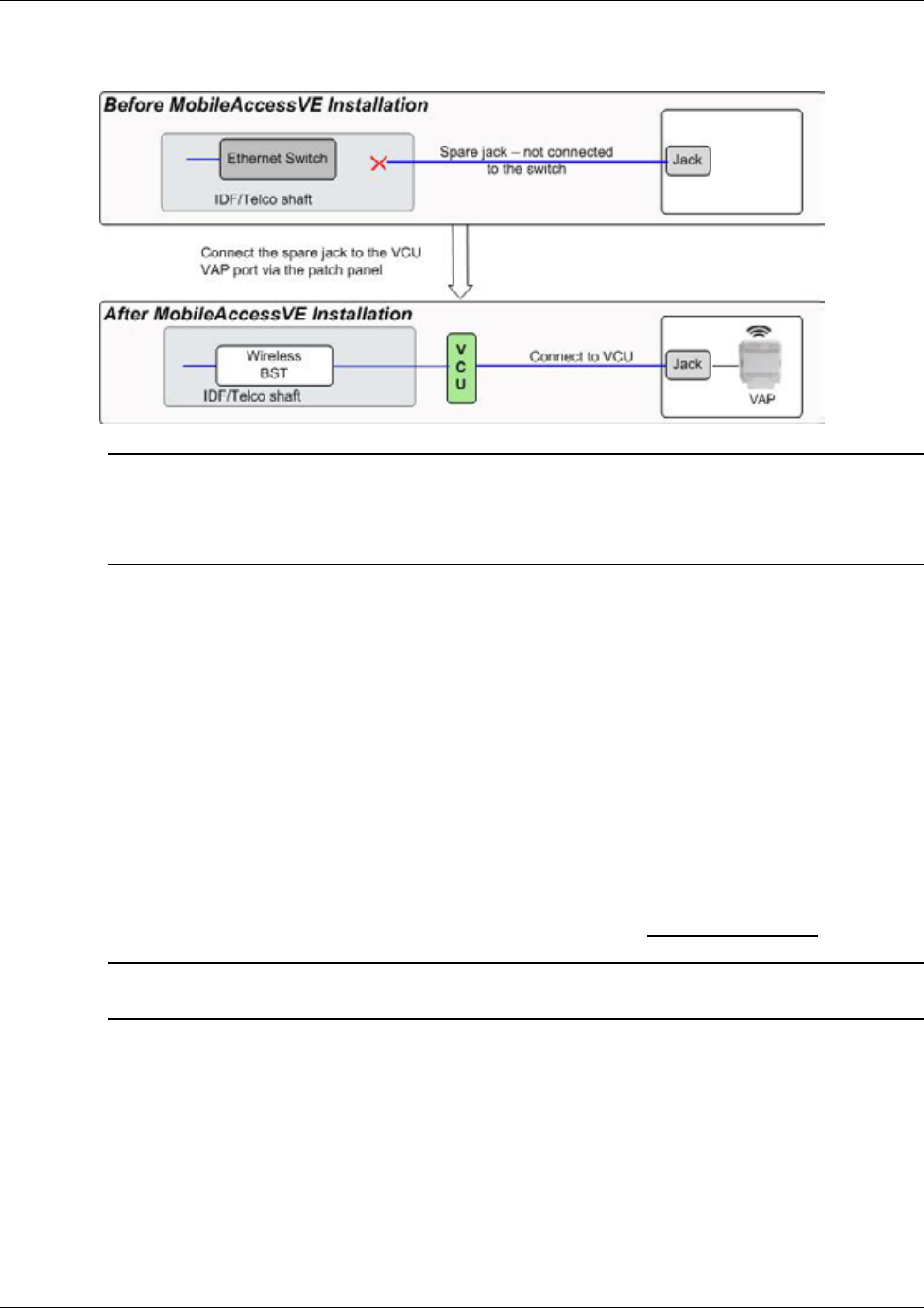
VCU Unit Installation and Provisioning
Dual-Band MobileAccessVE Instant Coverage Solution User Manual 23
For VAPs installed on currently INACTIVE Ethernet ports, connect as follows.
Note: After the Slave VCUs are installed and connected to the correct ports in the patch panels,
please proceed with the VAP installation as described in chapter
5 . However, it is recommended
to complete the VCU provisioning first (See section
4.4) because when installing the VAPs they
will instantly provide the wireless service (and the installer will be able to check the coverage).
4.3.2 Operation with LAN Utilizing Power over Ethernet (PoE)
Power over Ethernet (PoE) is a technology that enables passing electrical power over the
Ethernet cabling. Power can either come from a PoE-enabled Ethernet device (e.g. switch) or
from a “mid-span” device built specifically for "injecting" power into the Ethernet cabling.
PoE can operate over two different pairs in a CAT-5e/6 cable. These two methods are referred to
as “alternative a” and ”alternative b”. All PoE compatible appliances, such as WLAN APs and IP
Phones, support both alternatives and automatically detect and use the power on the
appropriate pairs (alternative a or b).
MobileAccessVE supports sharing LAN infrastructures that use either 802.3af PoE or 802.3at
PoE.
In the current release MobileAccessVE supports operation with “alternative a” PoE
Note: Future enhancements will support coexistence with “alternative b” PoE. If this is currently
required, consult MobileAccess.
.

VCU Unit Installation and Provisioning
Dual-Band MobileAccessVE Instant Coverage Solution User Manual 24
4.4 Provisioning the VE Control Unit
This section describes how to set the basic parameters required for operation and remote
management of the Master VCU using the Web GUI. The configuration dialogs are fully
described in Chapter 6 .
The Master or Slave mode is automatically detected according to the VCU's physical connection.
If a connection to another VCU is detected, the VCU will be identified as a Slave, otherwise it will
assume the role of a Master.
Notes:
1. The initial configuration of the Master VCU is performed via local connection using a cross-
cable and connecting to VCUs default IP address. After performing the initial configuration
and assigning the Master VCU an IP address, the system can be connected, monitored, and
configured via a remote management connection.
2. The configuration and management of all of the system units (VCUs and VAPs) is performed
via local or remote connection to the Master VCU unit.
4.4.1 Configure the Computer IP Parameters
Configure the computer local LAN connection to operate in the same subnet as the default VCU
IP address. Note that the procedure may vary slightly depending on the operating system
installed on your computer. The following procedure is for Windows XP.
To Configure the Computer’s IP Parameters:
1. Click the Start menu and choose Control Panel.
2. In the Control Panel, click Network and Internet Connections.
3. Click Network Connections and then double-click Local Area Connection.
The Local Area Connections Properties dialog box appears with the General tab displayed by
default.
4. In the Items list, select “Internet Protocol (TCP*IP)” and click the Properties button.
5. The “Internet Protocol (TCP/IP) Properties” dialog appears.
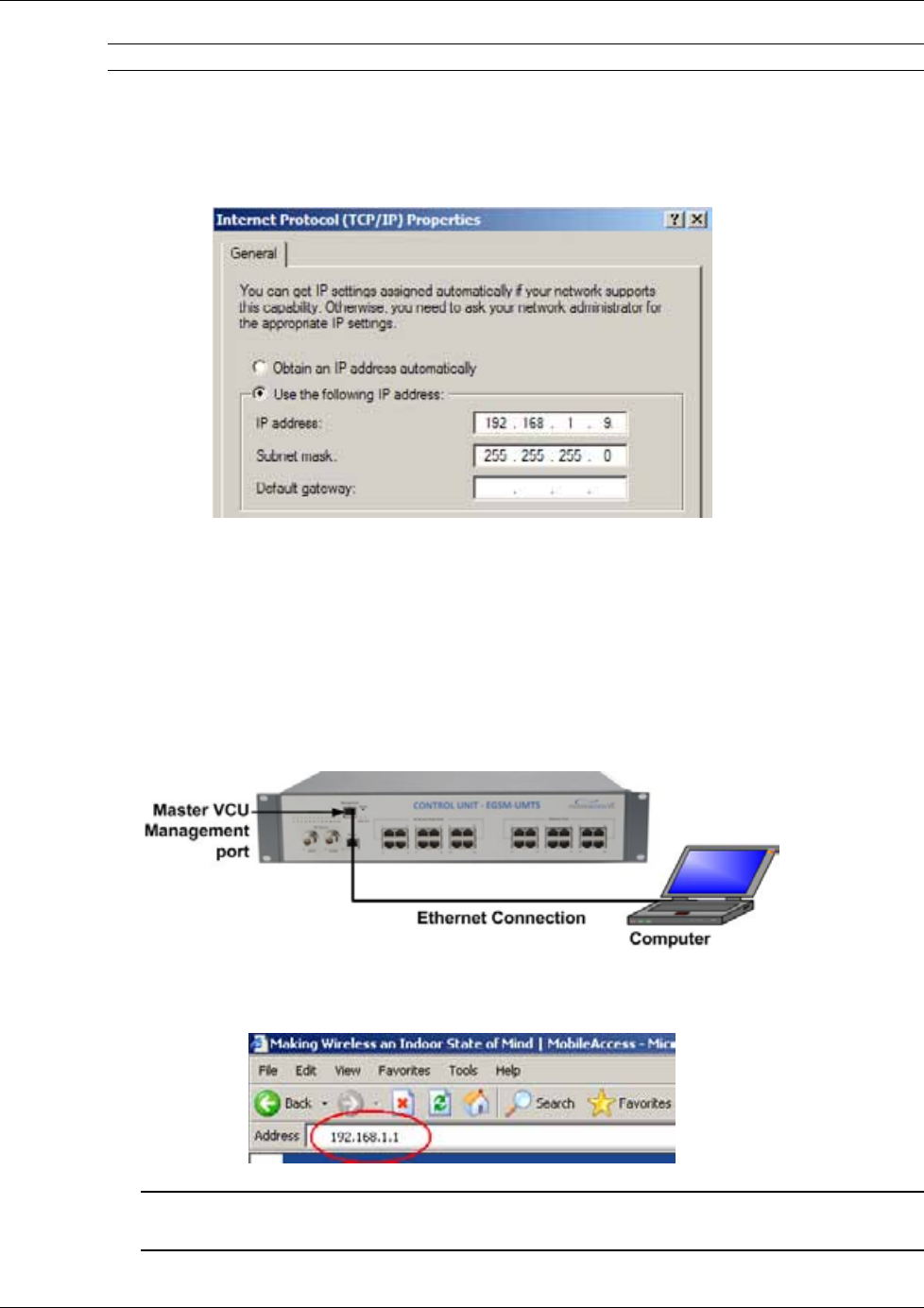
VCU Unit Installation and Provisioning
Dual-Band MobileAccessVE Instant Coverage Solution User Manual 25
Note: The Master VCU is supplied with the default IP address 192.168.1.1.
· In order to communicate with the unit, it is necessary to assign your computer a
Static
IP
address in the same subnet: 192.168.1.2 to 192.168.1.250.
(i.e. 192.168.1.9 as shown in the example).
· Define the subnet mask as shown: 255.255.255.0
6. Click OK.
7. The computer communication parameters are now defined and you can open a session to
the Master VCU and provision the unit.
4.4.2 Provisioning the Master VCU Unit
1. Perform a local connection to the Master VCU unit by connecting the Master VCU front panel
Management port and a laptop computer.
2. Open a web browser and type the Master VCU IP address in the address bar (Default:
192.168.1.1).
Note: If you have forgotten the VCU IP address (or want to change it) it can be retrieved via
the IP Recovery Tool application provided on the Setup CD. See section
9.2.
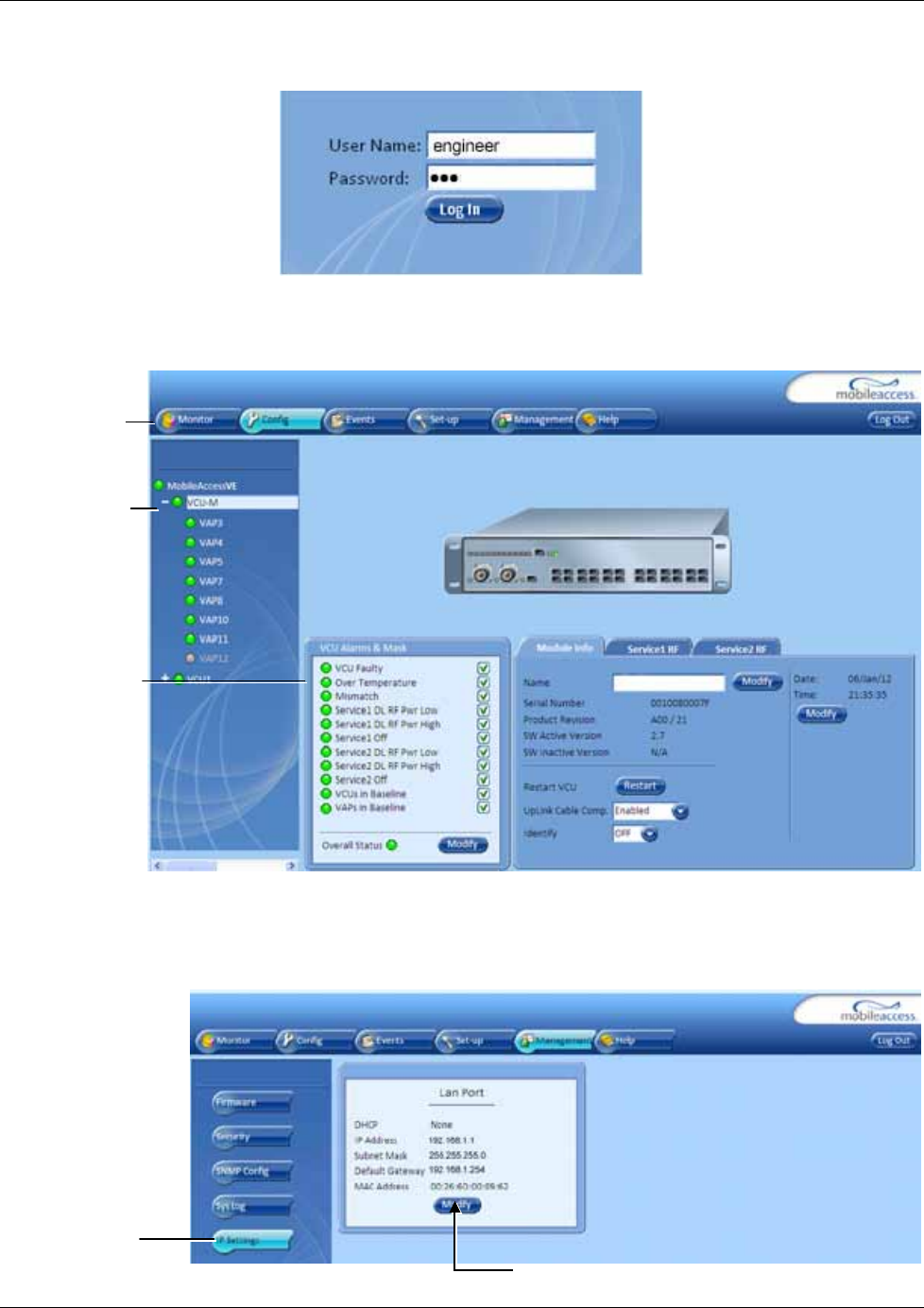
VCU Unit Installation and Provisioning
Dual-Band MobileAccessVE Instant Coverage Solution User Manual 26
The Login window appears.
3. Type the User Name “engineer” and enter the Password “eng”.
The MobileAccessVE Web GUI appears.
4. To remotely access Master VCU via Ethernet, configure the VCU IP address as follows:
· Choose the Management tab in the main menu bar
· Click the IP Settings tab on the side bar.
Network
Topology
Sub-
tabs
Corresponding
to Selected
Main Tab
Main Menu
Bar
Modify Button
IP
Settings

VCU Unit Installation and Provisioning
Dual-Band MobileAccessVE Instant Coverage Solution User Manual 27
Note: See section
6.4 for a description of the Management tab
.
· Click the Modify button to define the STATIC IP Address according to existing LAN.
· Set the Static IP address parameter (DHCP is not currently available)
Default definitions:
• The Default IP Address : 192.168.1.1
• The Default Subnet Mask: 255.255.255.0
• The Default Gateway: 192.168.1.254
· Click OK.
5. Log out and then log in again with the new IP settings.
6. Select the Config tab in the main menu bar.
Note: See section
6.3 for a complete description of the Config tab.
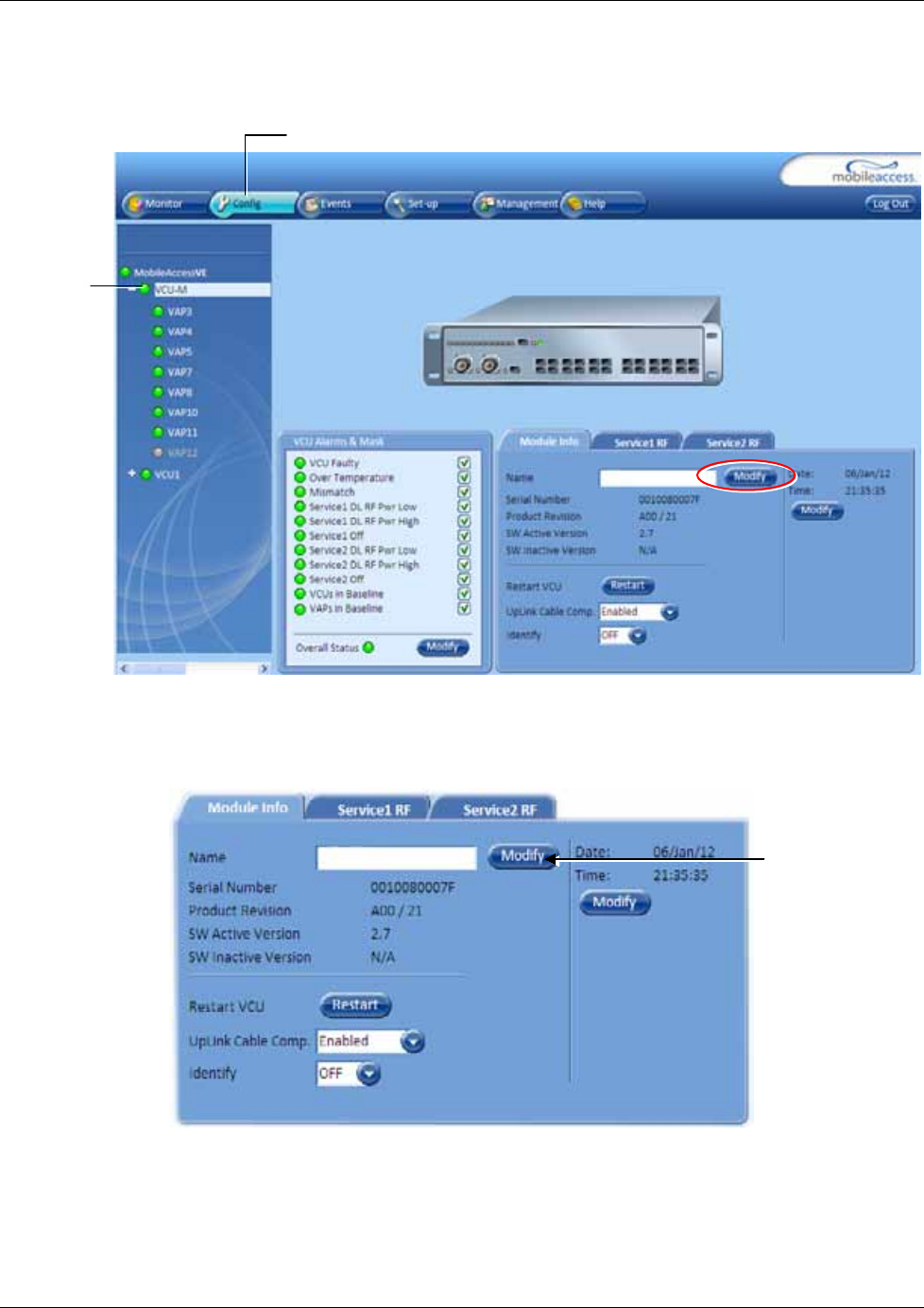
VCU Unit Installation and Provisioning
Dual-Band MobileAccessVE Instant Coverage Solution User Manual 28
7. The Master VCU appears in the Network Topology Tree as VCU-M. Select the Master VCU
by clicking on it.
8. Before configuring the Master VCU please give the unit an identifiable name. To assign the
Master VCU an identifiable name:
· Select the Module Info Tab and click the Modify button.
Click
Config Tab
Master
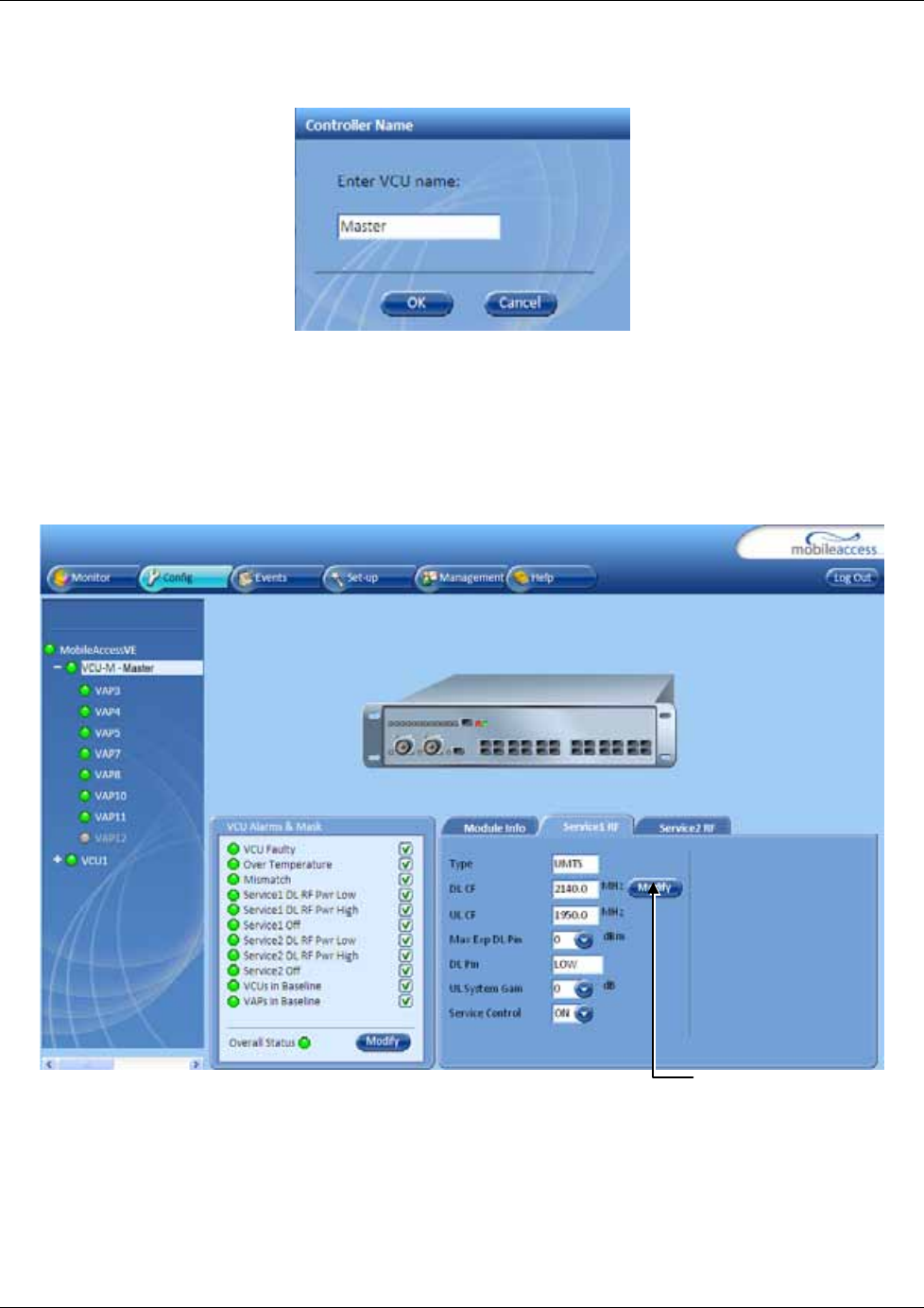
VCU Unit Installation and Provisioning
Dual-Band MobileAccessVE Instant Coverage Solution User Manual 29
· Type the unit name (up to 17 alpha-numeric characters) in the Controller Name dialog
and click OK.
9. Uplink Cable Compensation – enable this parameter ONLY if the bonded cable lengths vary
between the VCU and VAPs (reduces noise). It is NOT recommended to enable this option
for similar cable lengths between the VCU and the connected VAPs.
10. Set the RF parameters for each connected service (up to two). Select the Service RF tab
(Service1 RF / Service2 RF) of the service being configured (each service is configured
through its’ corresponding tab):
Figure 4-5. Service RF Tab - Example Shows Service RF Tab for UMTS Service
· For EGSM/DCS and EGSM/UMTS services (see figure above) - Click Modify and enter
the DL central frequency for each service according to the following ranges:
• EGSM: 925 – 960 MHz
• UMTS: 2110 – 2170 MHz
• DCS: 1805 – 1880 MHz
Modify
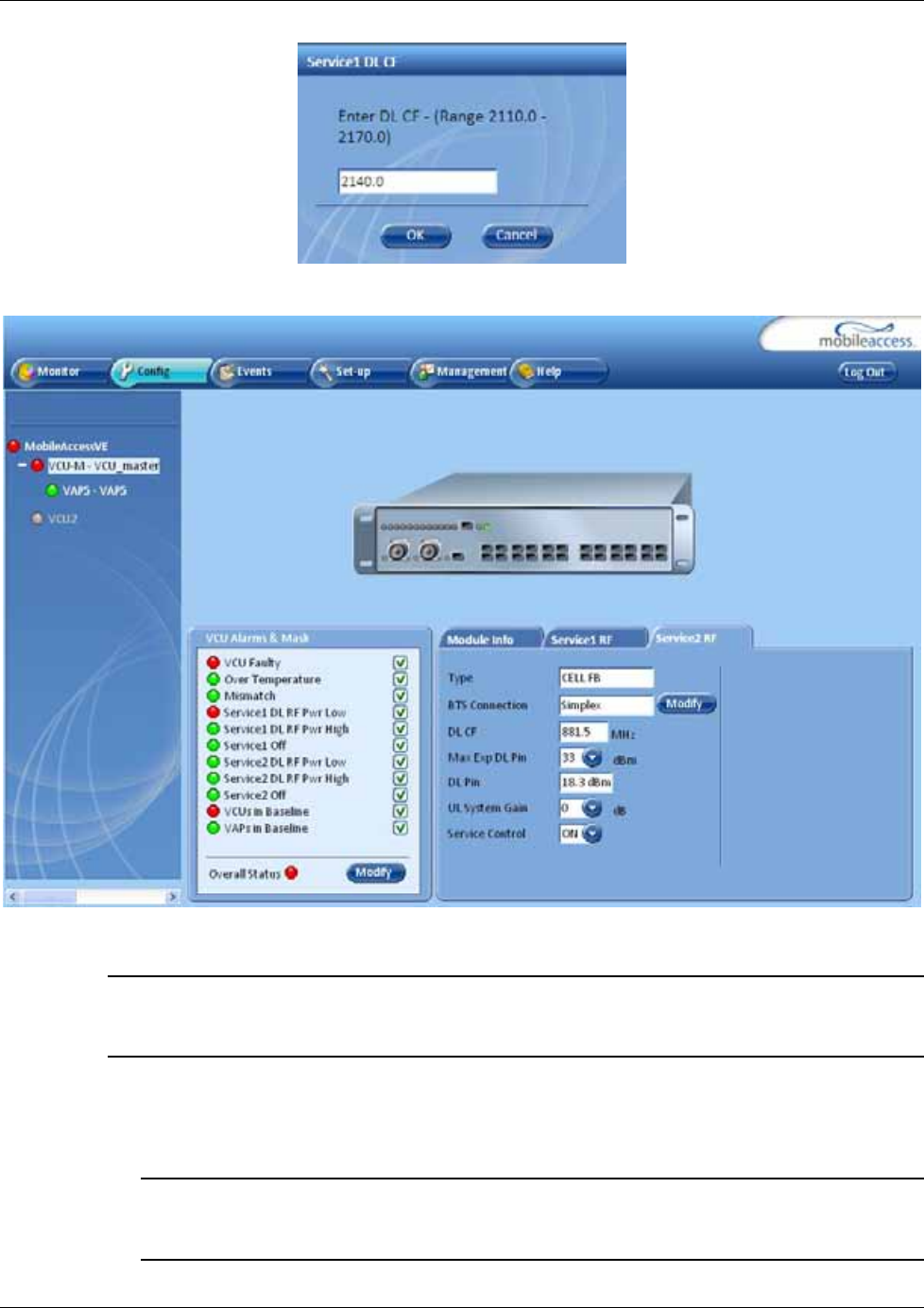
VCU Unit Installation and Provisioning
Dual-Band MobileAccessVE Instant Coverage Solution User Manual 30
· For CELL-PCS Full Band – Select BTS Connection (Simplex/Duplex).
Figure 4-6: Service RF Tab – Example for CELL Full Band
Note 1: CELL-PCS Full Band DL CF is Read Only.
Note 2: The Service DL CF dialog displays the relevant range for each service. The figure above
shows an example for the UMTS band.
· Click OK.
· Define Max expected power of BTS (0-33dBm).
· Define UL system gain for each service (5 to -15dB).
Notes:
1. Max expected Pin and Service CF parameters are service dependent and can be obtained
from your service provider.
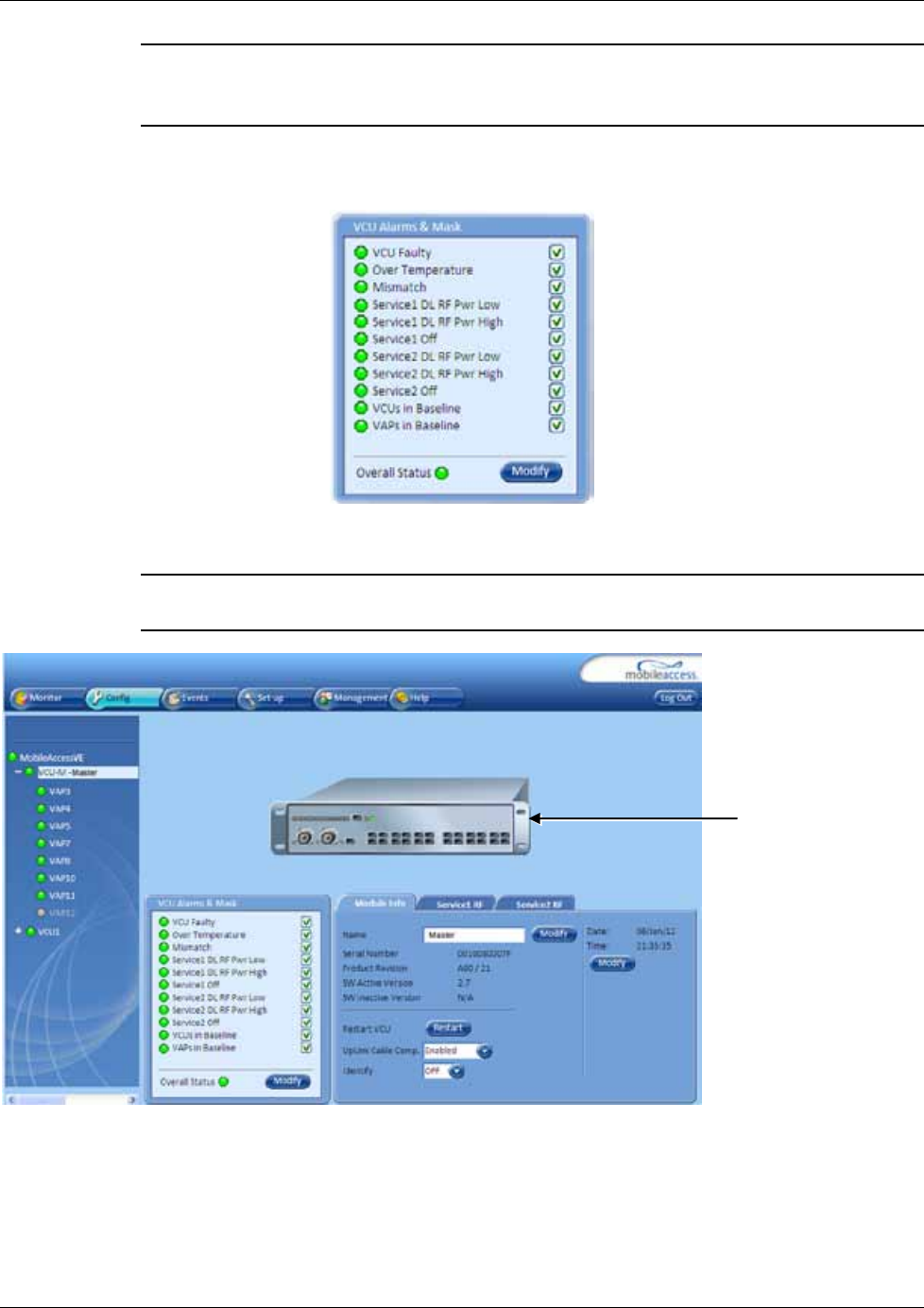
VCU Unit Installation and Provisioning
Dual-Band MobileAccessVE Instant Coverage Solution User Manual 31
2. The remaining parameters are predefined to their default values. (Service Bandwidth is
set to 15 MHz for EGSM, UMTS and CELL and to 20 MHz for DCS and PCS).
3. Any updates of the service Central Frequency definition is sent to all connected VAPs.
11. To verify proper operation of the system, refer to the Alarms sub-tab (in the Config tab).
(See following figure).
12. Verify that all the alarms are GREEN. Refer to section 7.2 for alarm descriptions.
Note: To briefly check the VCU status, click on the VCU name in the Topology Tree. The VCU
icon will appear, showing the LEDs status.
Master
VCU Icon
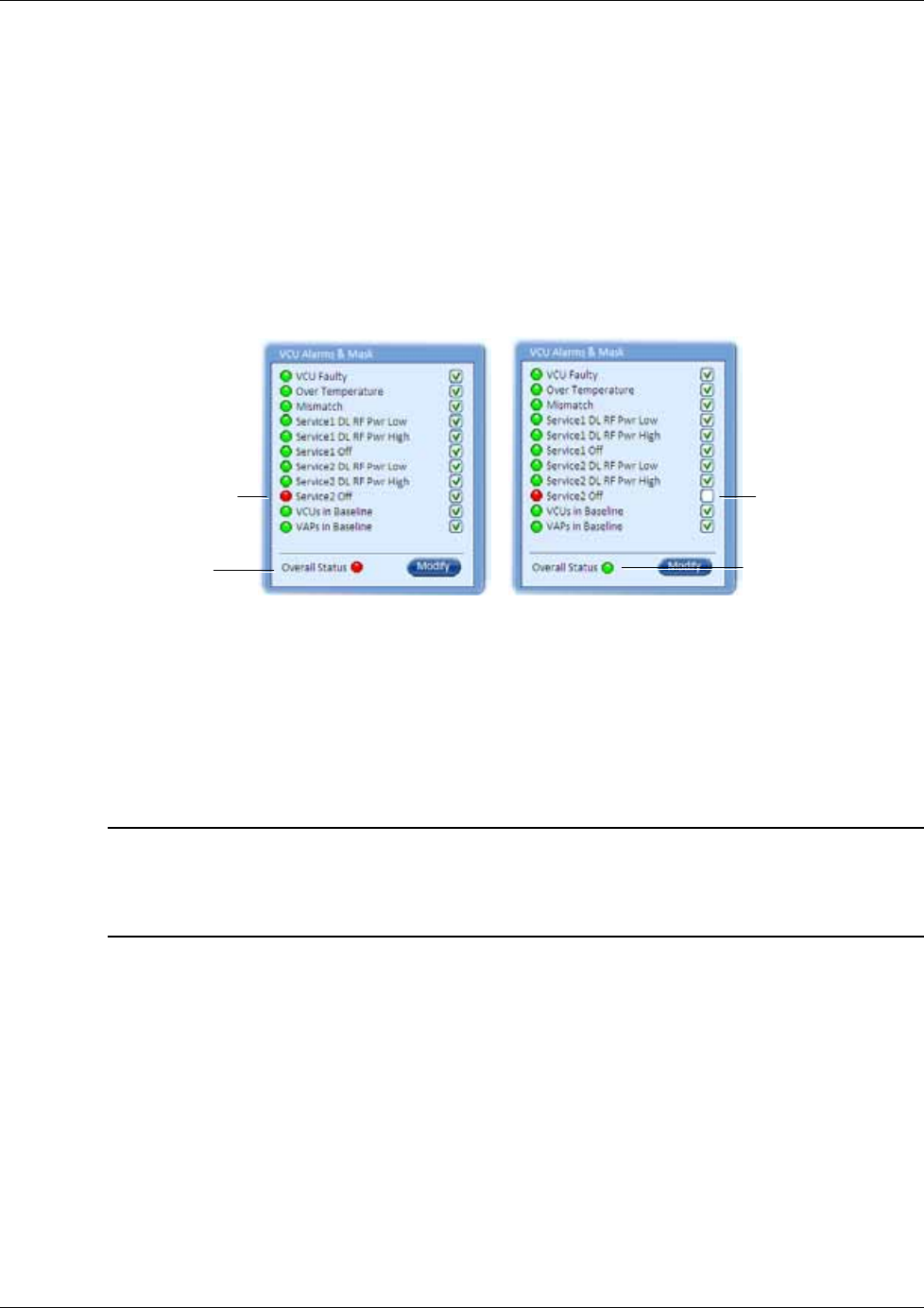
VCU Unit Installation and Provisioning
Dual-Band MobileAccessVE Instant Coverage Solution User Manual 32
13. Mask irrelevant alarm conditions to avoid having them reflected to the overall status of the
unit.
For Example
If the Dual-Band system is currently only being used to provide one service, while the other
service is disabled, the “Service Off” alarm can be masked (Disabled).
In the example below, the left dialog shows the alarm response if the Service 2 alarm is NOT
masked (enabled). In that case the Overall Status will be RED indicating a fault.
If the Service 2 alarm is MASKED (Disabled), then the LED for the alarm will be RED; but,
the Overall Status will be GREEN – showing NO Fault.
Figure 4-7. Service2 Service Off Alarm – Not Masked Figure 4-8. Service2 Service Off Alarm –Masked
In
Figure 4-9
, the alarm condition for “Service 2 Service Off” actually exists, while the masking
prevents this condition from affecting the overall status of the system and therefore the Overall
Status led below is green.
4.4.3 Provisioning the Slave VCUs
Note: The Slave VCUs management and configuration is performed through a remote connection
to the Master VCU, via the Web Management application. Before provisioning the Slave VCUs
verify that the Master VCU unit, to which it is connected, has been provisioned (See section
4.4.1).
The Slave VCU RF parameters are set via the Master VCU, therefore there is no need to
configure the RF parameters individually for each connected Slave VCU. It is recommended to
assign each Slave VCU an identifiable name.
Service2 Service
Off Alarm
Masked
(Disabled)
Service2 Service Off
Alarm
Unmasked
(Enabled)
Overall Status RED
Overall Status GREEN
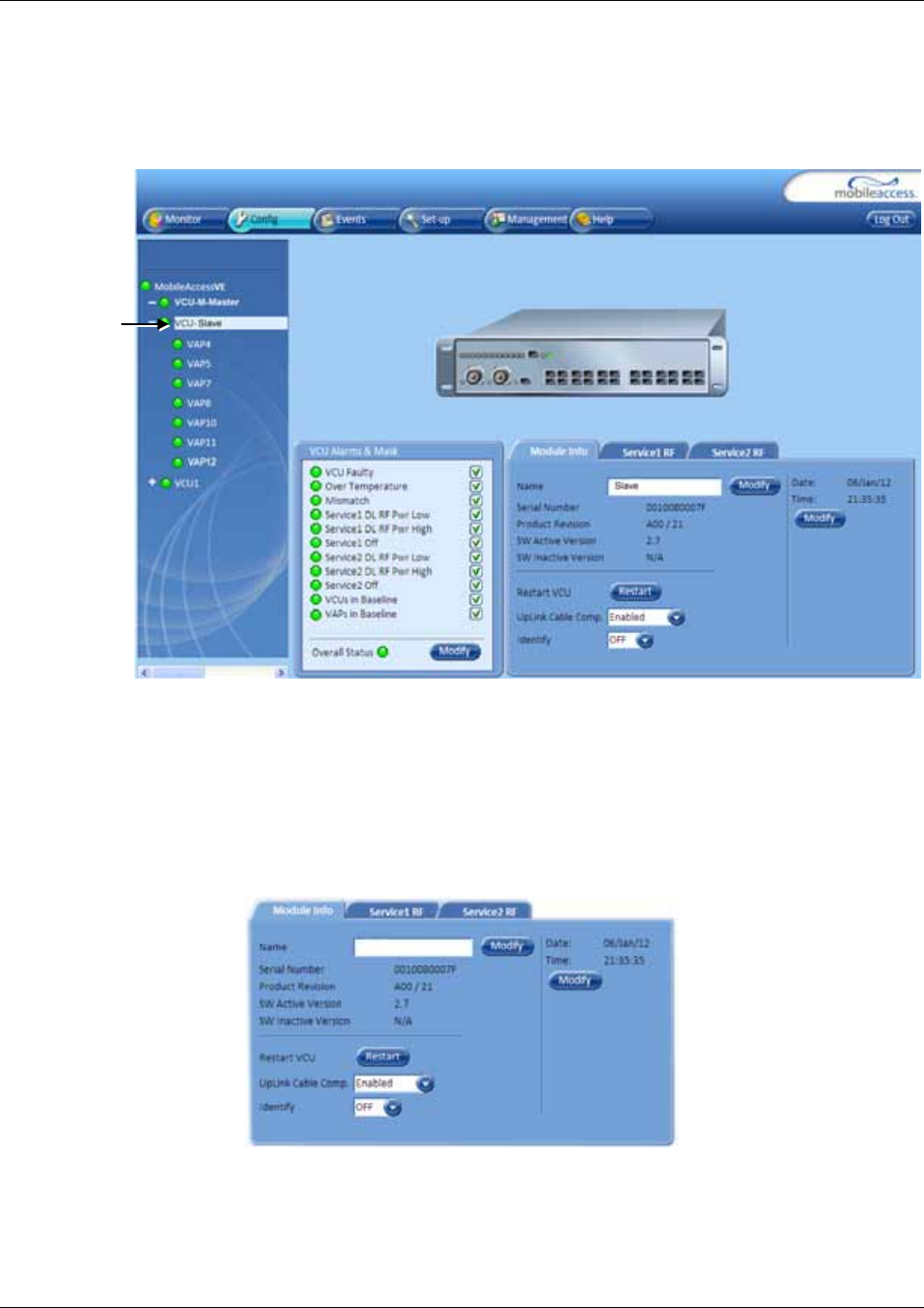
VCU Unit Installation and Provisioning
Dual-Band MobileAccessVE Instant Coverage Solution User Manual 33
To assign a name to a Slave VCU:
1. Connect to the Master VCU unit (either locally as explained in section 4.4.1 or remotely) and
select the Slave VCU to be provisioned from the Network Topology Tree.
Each VCU has a default name of the form “VCUPx-name”, where:
· Px - Master VCU port number to which the Slave VCU is connected
· Name - User-defined name
2. To assign the Slave VCU an identifiable name:
· Select the Module Info Tab
· Click the Modify button
· Type the unit name (up to 17 alpha-numeric characters) and click OK.
3. Uplink Cable Compensation – enable this parameter ONLY if the bonded cable lengths vary
between the VCU and VAPs (reduces noise). It is NOT recommended to enable this option
for similar cable lengths between the VCU and the connected VAPs.
Selected Slave
VCU-

VAP Installation and Provisioning
Dual-Band MobileAccessVE Instant Coverage Solution User Manual 34
5 VAP Installation and Provisioning
This section provides a description of the VE Access Pods (VAPs) installation, verification, and
monitoring procedures.
5.1 VAP Installation
The VAPs installation procedure consists of connecting each VAP to an Ethernet jack in the
appropriate location to provide optimal coverage (See sections 3.4 and 4.3).
It is recommended to install the VAPs in places located high up so as to maximize the provided
coverage per VAP.
Note: Mounting a VAP beneath a desk or in another secluded location (e.g. office corner)
decreases the effective coverage of the VAP increasing the need for a higher number of VAPs to
cover the same area.
There are three main types of VAP mounting installations:
· Desk Mount – Used for VAPs mounted on locations such as desks, cubical walls, and filing
cabinets. (See section 5.2.1.2).
· Wall Mount – Used for VAPs mounted on walls (
Recommended
). (See section 5.2.1.3).
· Ceiling Mount – Used for VAPs being installed in the ceiling. Two types of ceiling mount
installations:
· Horizontal – ONLY relevant for VAPs to which EXTERNAL antennas are connected. (See
section 5.2.2).
· Vertical – Applicable for VAPs working either with INTERNAL or EXTERNAL antennas.
(See section 5.2.3 5.2.3).
VAP Installation Considerations
· Placing units in an open area.
· Availability of CAT-5e/6 infrastructure.
· The VAPs plug into standard (RJ-45) Ethernet connection jacks.
· If the jack being used is already connected to Ethernet switch. For more information see
sections 3.4.2 and 4.3.
· Aesthetics of the VAP location.
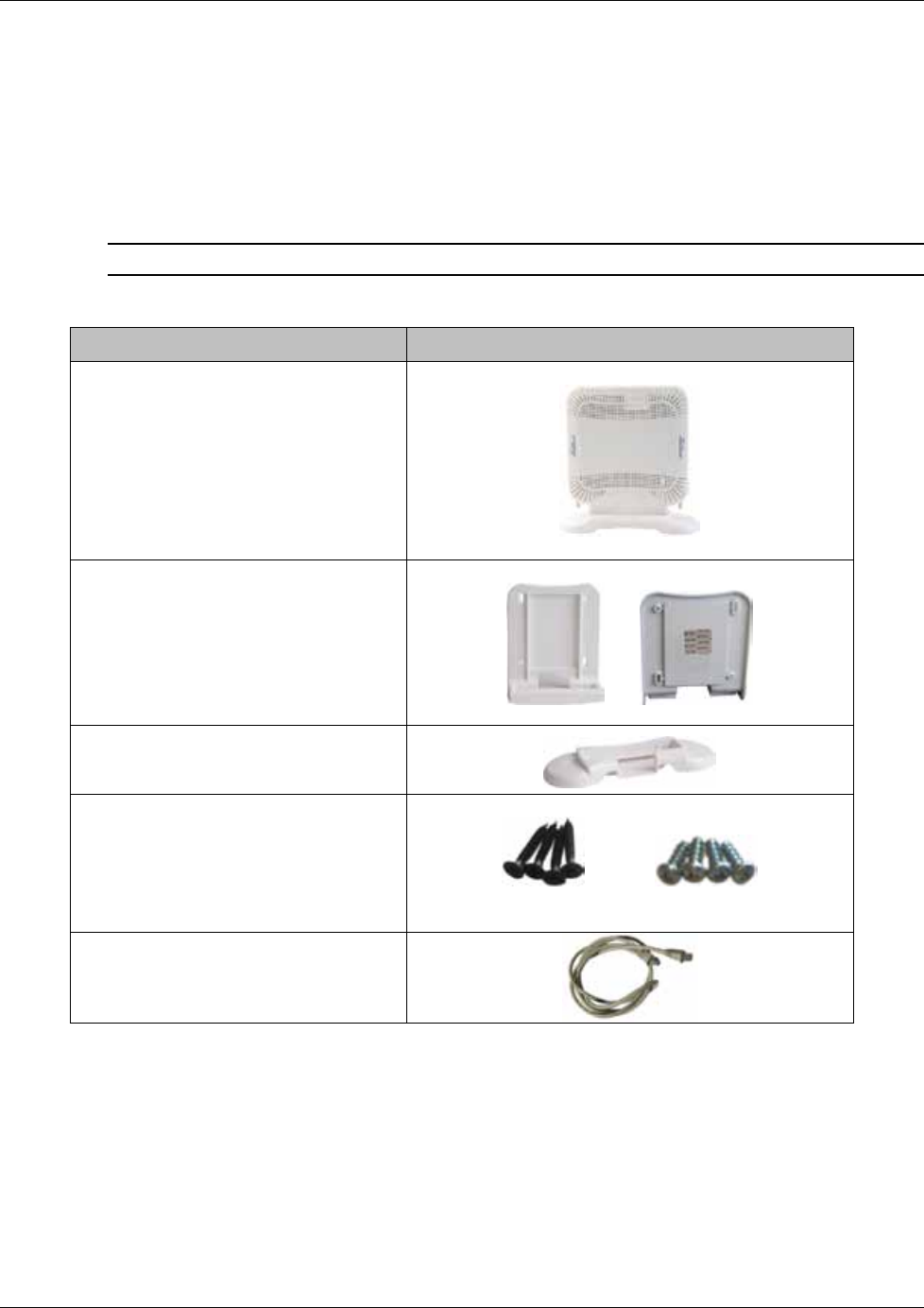
VAP Installation and Provisioning
Dual-Band MobileAccessVE Instant Coverage Solution User Manual 35
5.2 Desk and Wall Mount VAP Installations
5.2.1.1
VAP Kit Contents
The Dual-Band VE Access Pod (VAP) Kit includes:
Note: VAPs are provided with two mounting options: Desk Mount and Wall Mount
Table
5-1: VAP Kit
Kit Items Unit
VE Access Pod (VAPs)
Wall Mount Adaptor (Features
double-sided sticky tape located on
rear for fast installation)
Desk Mount Adaptor
(8) Screws:
o (4) Short Screws – Used to secure
adaptor to pod
o (4) Long Screws – Used to secure
wall mount adaptor to the wall
(“anti-theft” installation)
RJ-45 Jumper Cable
Front
Rear – showing
Long screws Short screws
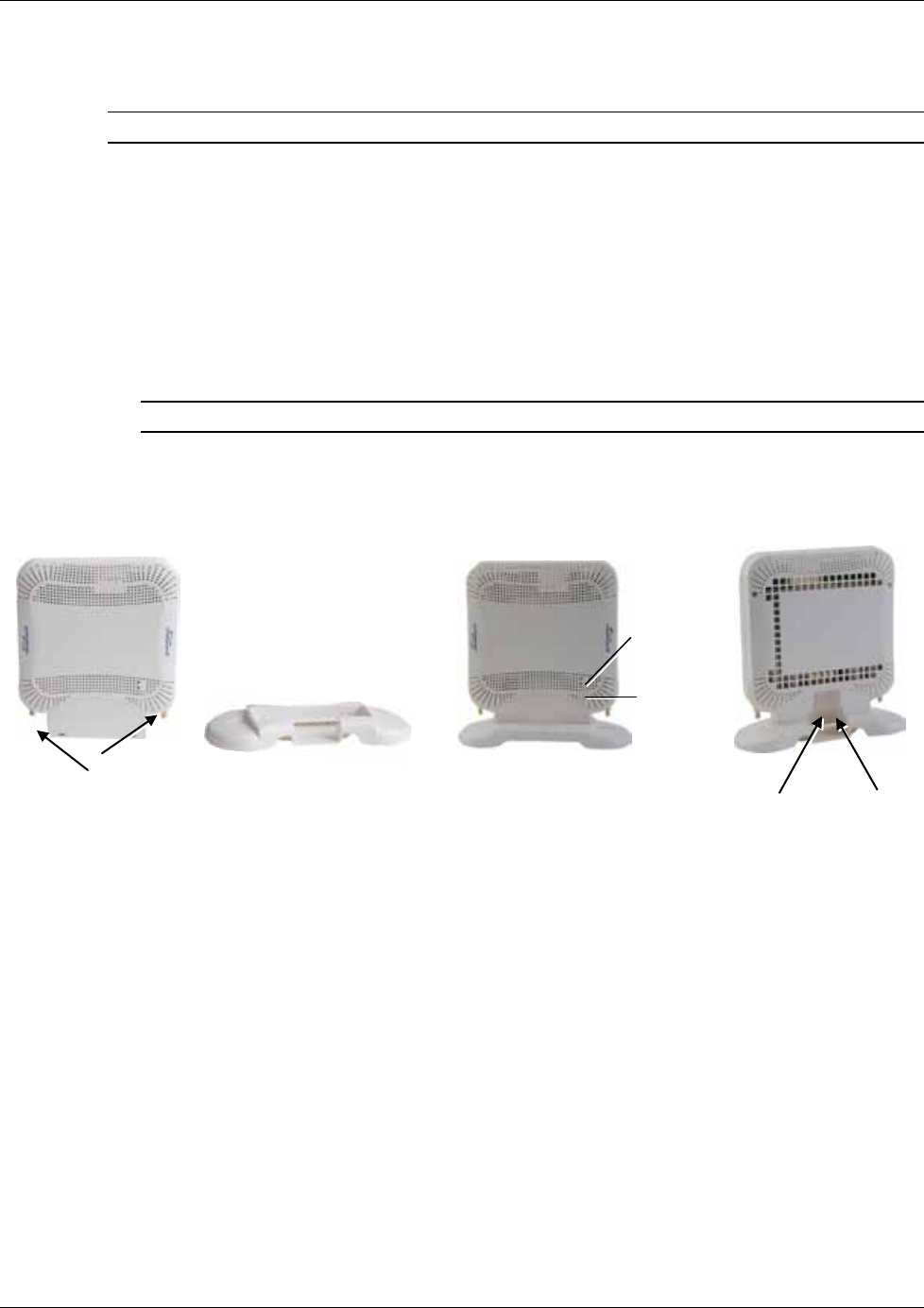
VAP Installation and Provisioning
Dual-Band MobileAccessVE Instant Coverage Solution User Manual 36
5.2.1.2
Desk Mount Installation
Note: All components (adaptor, screws, and cables) are included in the VAP Kit.
· Place the VAP on the Desk Mount.
· Secure the Desk Mount adaptor to the VE Access Pod using the (4) short screws.
· Connect the RJ-45 jumper cable (CAT-5e/6) to the VAP’s RJ-45 connector.
· Place the VAP on a flat surface according to the planned location.
· Plug the other end of the cable into the VCUs (RJ-45) Ethernet jack.
· When using an external antenna, connect the Ext. Antenna SMA connector(s) to the
external antenna(s). This option must be SW configured via the web GUI. (Note:
Internal antenna is enabled by default).
Note: The maximum external antenna gain should not exceed 10 dBi.
· Verify that the VAP receives power and connects to the VCU via the LEDs on the unit, both
the GREEN LED and the BLUE LED should be lit.
Desk Mount Adaptor
Ext. Antenna SMA
Connectors RJ-45 to
LAN
RJ-45 to
VCU
Access Pod
Assembly - Front View
Assembly - Rear View
Activity –
Blue LED
Pwr –
Green LED
+
=
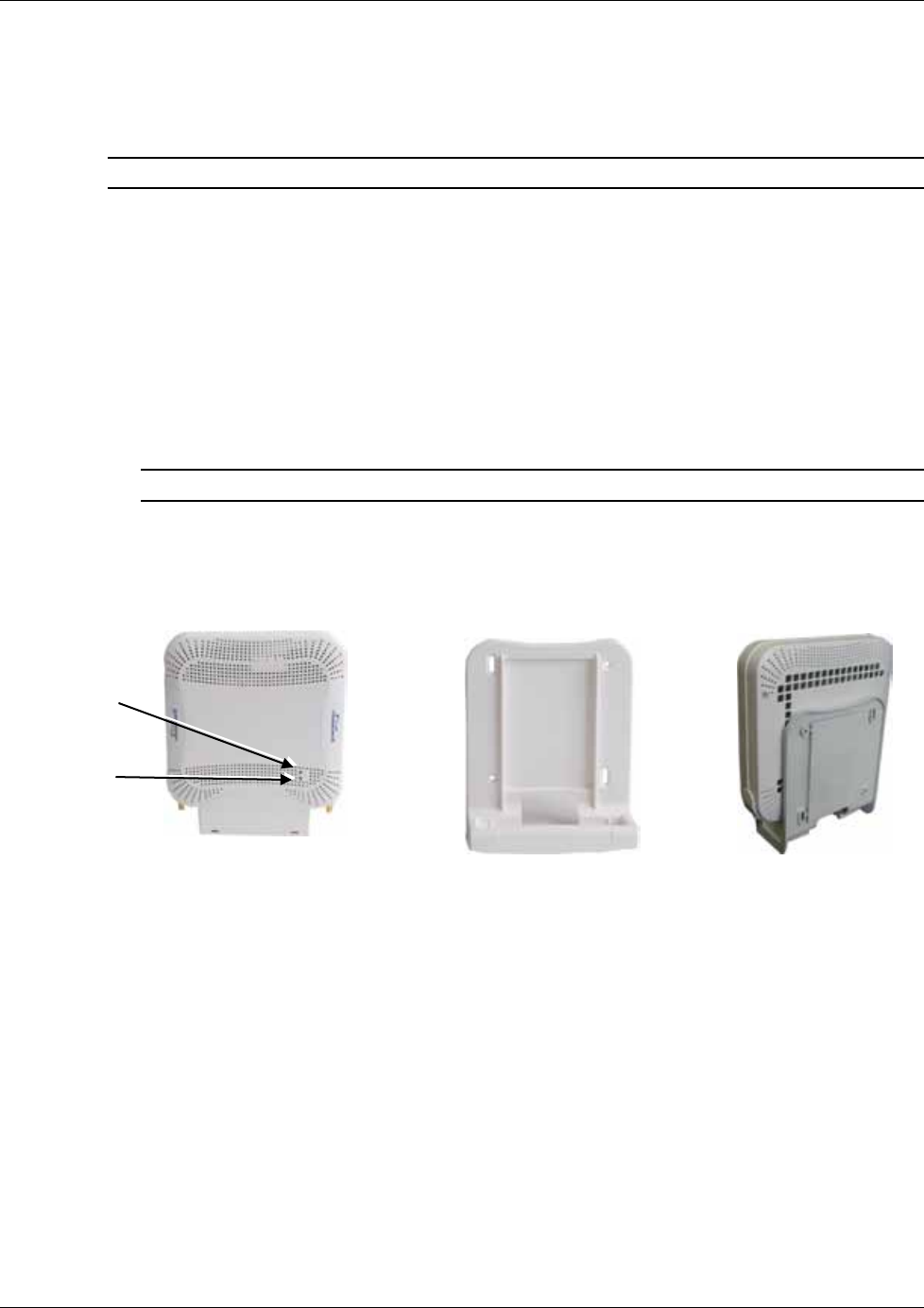
VAP Installation and Provisioning
Dual-Band MobileAccessVE Instant Coverage Solution User Manual 37
5.2.1.3
Wall Mount Installation
Note: All components (adaptor, screws, and cables) are included in the VAP Kit.
· Attach the VAP’s Wall Mount adaptor to the wall in the planned location, using the double
sided sticky tape located on the rear or secure it using the longer screws.
· Place the VAP on the Wall Mount.
· Secure the Wall Mount adaptor to the VE Access Pod using the (4) short screws.
· Connect the RJ-45 jumper cable via CAT-5e/6 to the VAP’s RJ-45 connector.
· Plug the other end of the cable into the VCUs (RJ-45) Ethernet jack.
· When using an external antenna, connect the Ext. Antenna SMA connector(s) to the
external antenna(s). This option must be SW configured via the web GUI.
(Note:
Internal antenna is enabled by default).
Note: The maximum external antenna gain should not exceed 10 dBi.
· Verify that the VAP receives power and connects to the VCU via the LEDs on the unit, both
the GREEN LED and the BLUE LED should be lit.
Access Pod
+
Blue LED
Green LED
Wall Mount
=
Assembly
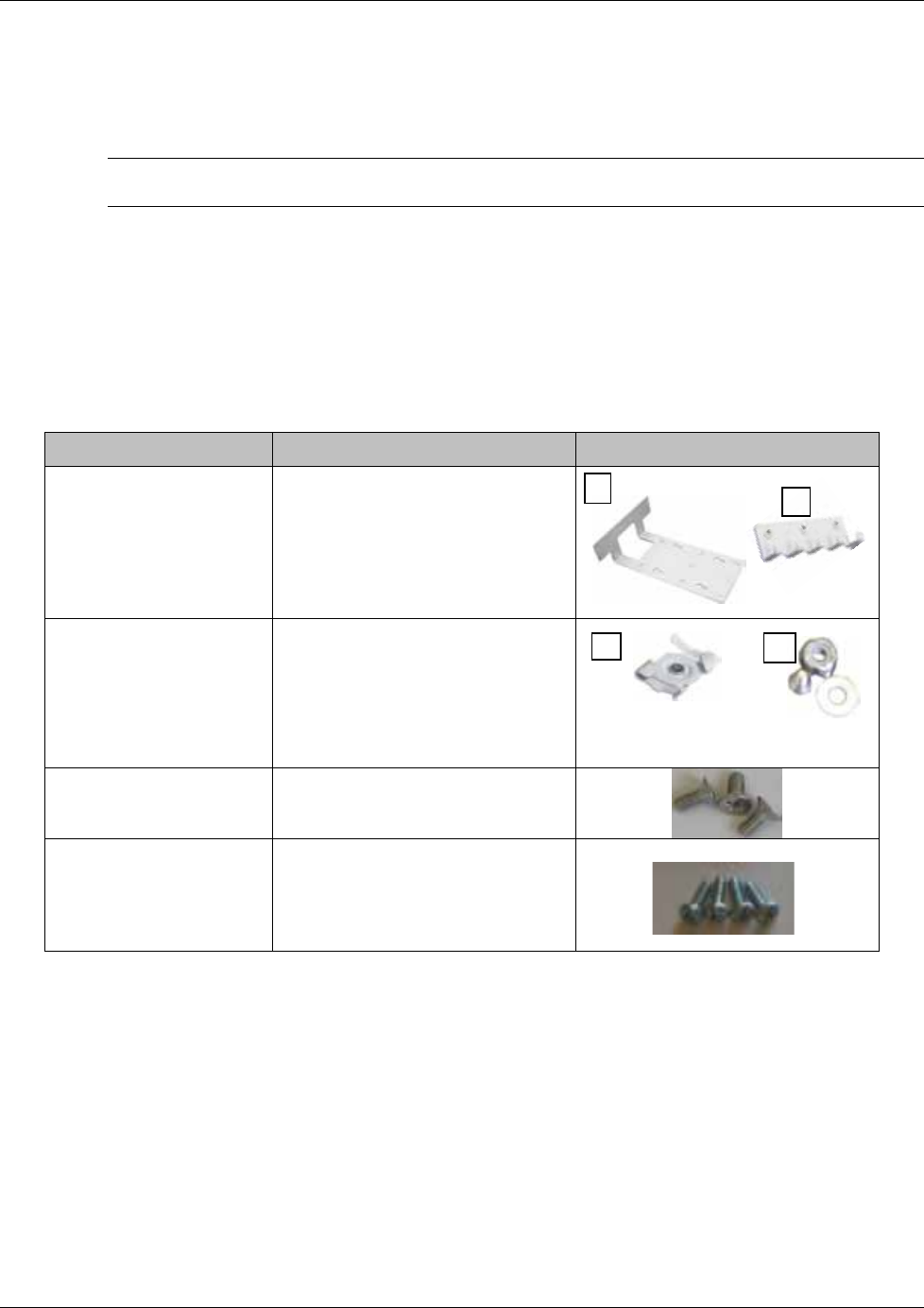
VAP Installation and Provisioning
Dual-Band MobileAccessVE Instant Coverage Solution User Manual 38
5.2.2 Horizontal Ceiling Mount VAP Installations
Note: This type of installation is ONLY relevant for VAPs to which EXTERNAL antennas are
connected.
The Horizontal installation procedure varies depending on the type of ceiling:
· Lowered ceilings.
· Concrete/Wood ceilings (See section 5.2.2.3).
5.2.2.1
VAP Kit Contents
Please verify that the VAP Ceiling Mount Installation kit (P/N AK-VAP-CEILING-MT-H)
includes the items listed below.
Kit Items Description Unit
Mounting Brackets A) Ceiling Bracket
B) Locke Bracket
“Twist on” Track Light
Clip assembly
Used for installation on lowered
ceilings.
A) Track Light Clip
B) Screw, Bolt, and Washer
(3) Flat Head Screws
100', 4/40 x 1/4
[NEROSTA] Used for assembling brackets
(4) Self Screws
3dim L=8 ,Flat HD 90
[Steel zinc]
Used for securing bracket
assembly to VAP
B
A
B
A

VAP Installation and Provisioning
Dual-Band MobileAccessVE Instant Coverage Solution User Manual 39
5.2.2.2
Lowered Ceiling Installation
To Install VAP on a Lowered Ceiling
1.
Loosely
assemble the two brackets (Ceiling and Locke) using the provided Flat Head screws.
The assembly will be secured at a later stage.
2. Assemble the Track Light Clip to the Ceiling Bracket (top side) using the provided washer
and bolt.
3. Hook the assembly onto the VAP rear panel grid and fit to the bottom of VAP.
4. Secure the assembled brackets to the bottom of the VAP using the Self Screws.
5. Adjust the bracket assembly to firmly fit the VAP and tighten the three screws securing the
assembly.
6. Mount the VAP on the lowered ceiling as follows:
· Enlarge large flanges over opposite sides of T-bar.
Note: Apply slight pressure as Twist
Clip is made of spring steel.
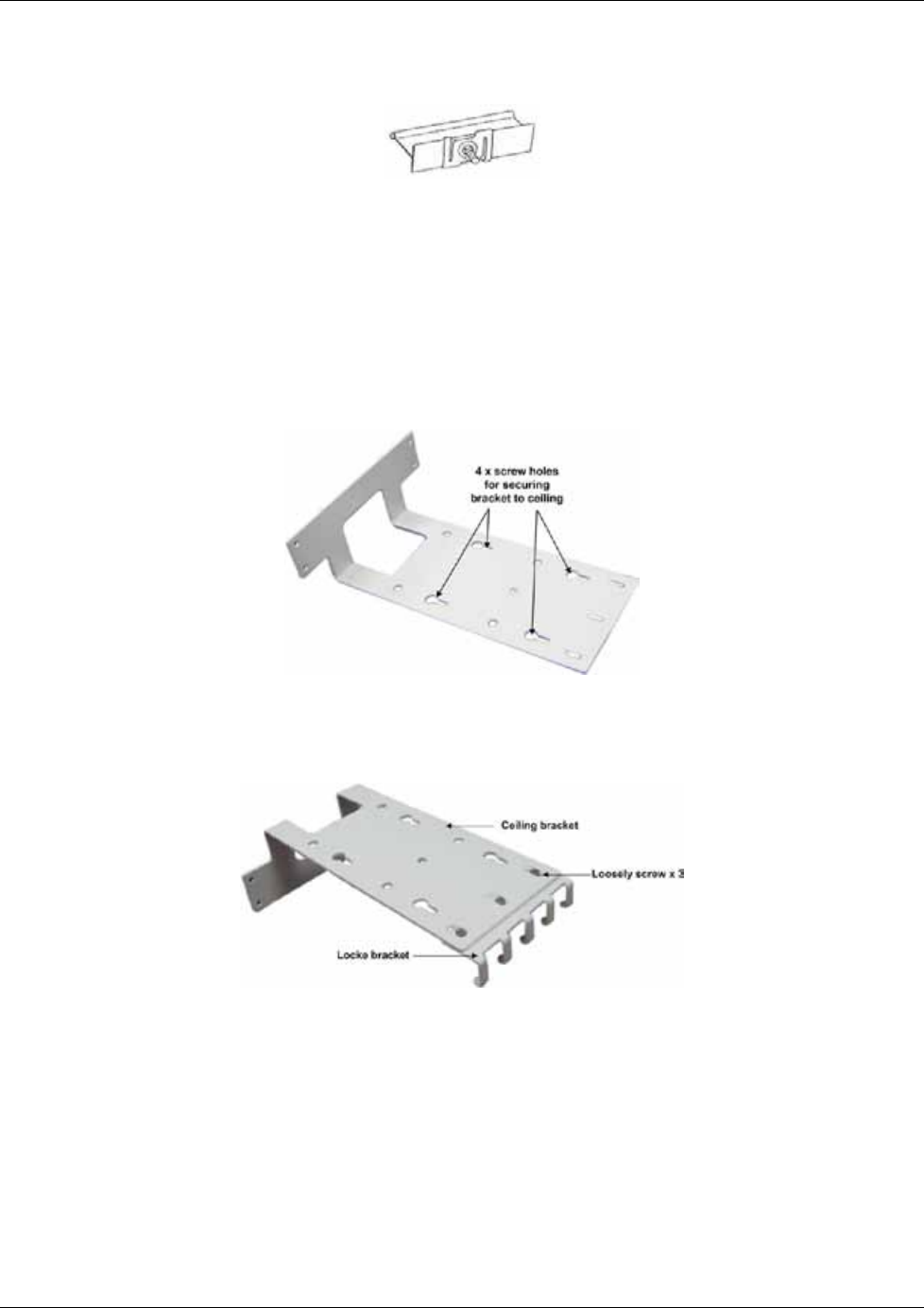
VAP Installation and Provisioning
Dual-Band MobileAccessVE Instant Coverage Solution User Manual 40
· Twist flanges clockwise until small flanges snap over edges. The Twist Clip is now in
position.
· Place stud through 1/2" knock-out. Use washer-nut combination and tighten securely.
5.2.2.3
Concrete/Wood Ceiling Installation
To Install VAP in Lowered Ceiling
1. Mark the location of the (4) screws on the ceiling according to the (4) larger holes on the
bracket assembly.
2. Drill the screws in to the marked locations on the ceiling.
3. Align the (3) screw holes of each of the brackets (Ceiling and Locke) as shown in the
adjacent figure and using the supplied Flat Head screws,
loosely
assemble the brackets.
Note: To be adjusted at a later stage.
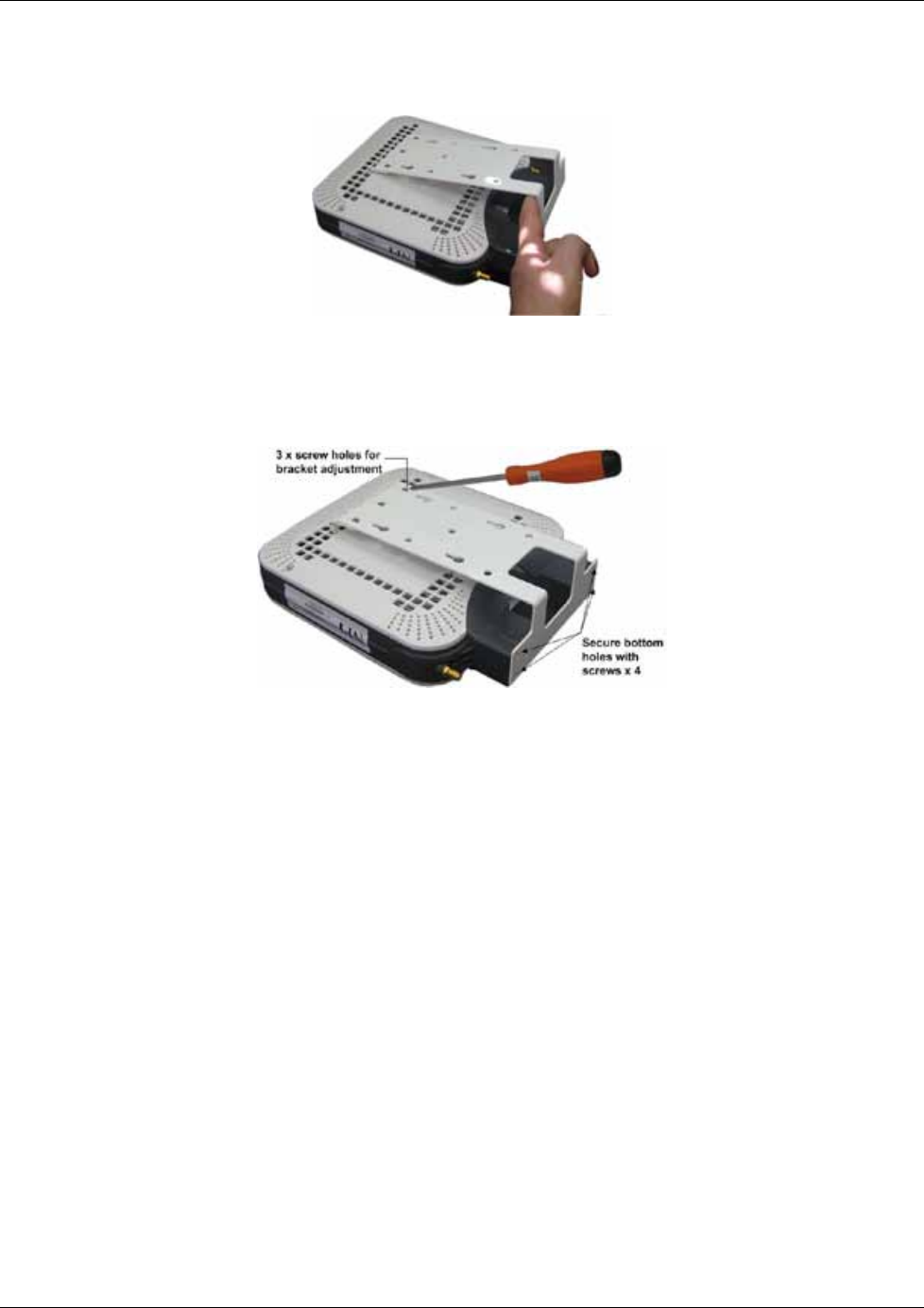
VAP Installation and Provisioning
Dual-Band MobileAccessVE Instant Coverage Solution User Manual 41
4. Fit the assembled brackets on to the VAP by inserting the (5) hooks in corresponding top
rear grid of the VAP and fit the other side on to the underside of the VAP.
5. Secure the assembled brackets to the bottom of the VAP using the Self Screws.
6. Adjust the bracket to the VAP and tighten the assembly screws.
7. Hang the VAP (using the (4) larger screw holes) on to the (4) screws located on the ceiling.
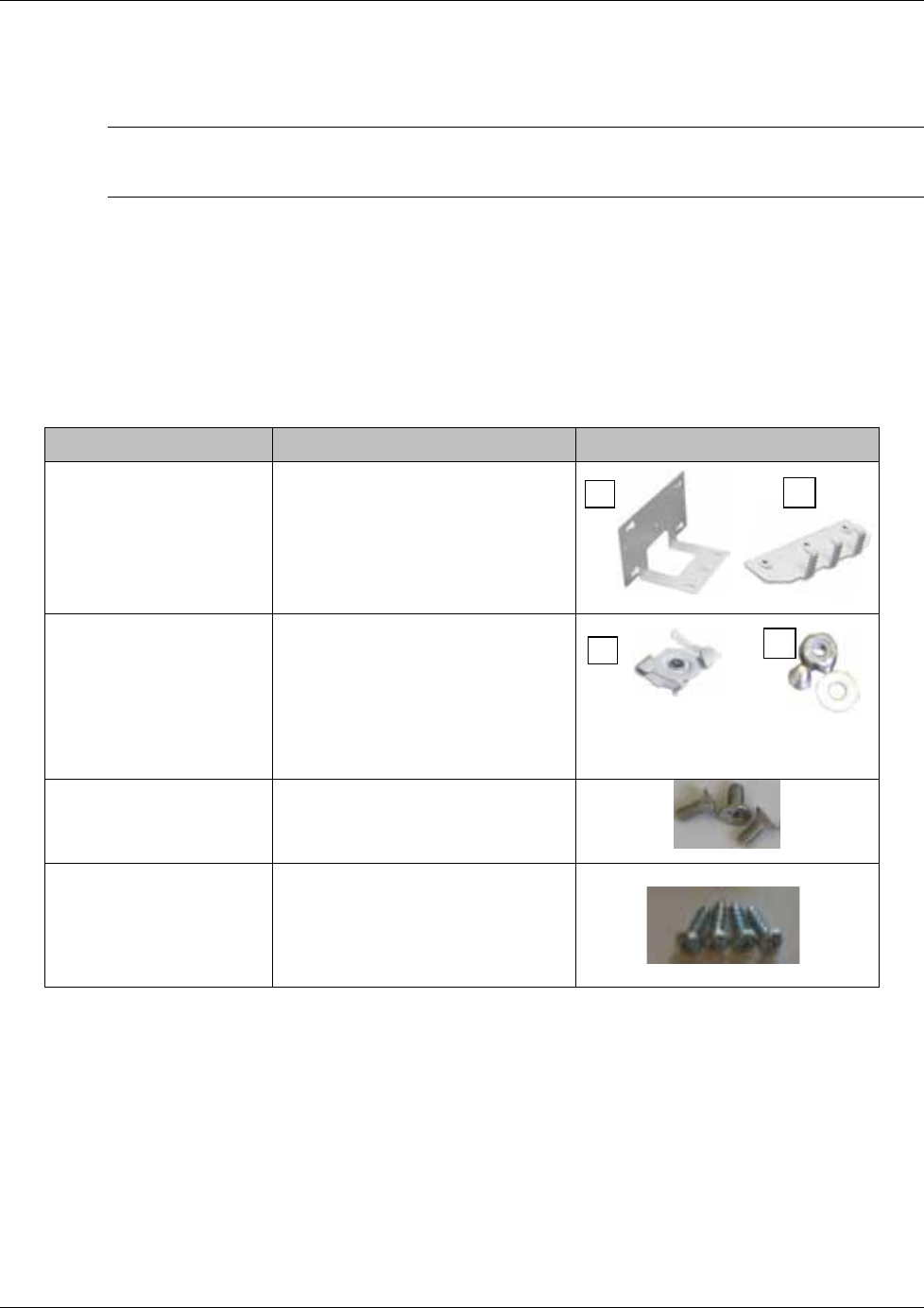
VAP Installation and Provisioning
Dual-Band MobileAccessVE Instant Coverage Solution User Manual 42
5.2.3 Vertical Ceiling Mount VAP Installations
Note: This type of installation option is applicable for VAPs working with either the INTERNAL
antennas or the EXTERNAL antennas (internal antennas are designed to provide uniform
coverage when aligned vertically on desk, wall or from ceiling).
The Vertical installation procedure varies depending on the type of ceiling:
· Lowered ceilings (See section 0).
· Concrete/Wood ceilings (See section 5.2.3.3).
5.2.3.1
VAP Kit Contents
Please verify that the VAP Ceiling Mount Installation kit (P/N AK-VAP-CEILING-MT-V)
includes the items listed below.
Kit Items Description Unit
Mounting Brackets A) Ceiling Bracket
B) Locke Bracket
“Twist on” Track Light
Clip Assembly A) Track Light Clip
B) Screw, Bolt, and Washer
(3) Flat Head Screws
100', 4/40 x ¼
[NEROSTA]
Used for assembling brackets
together
(4) Self Screws
3dim L=8 ,Flat HD 90
[Steel zinc]
Used for securing bracket
assembly to VAP
A
B
A
B
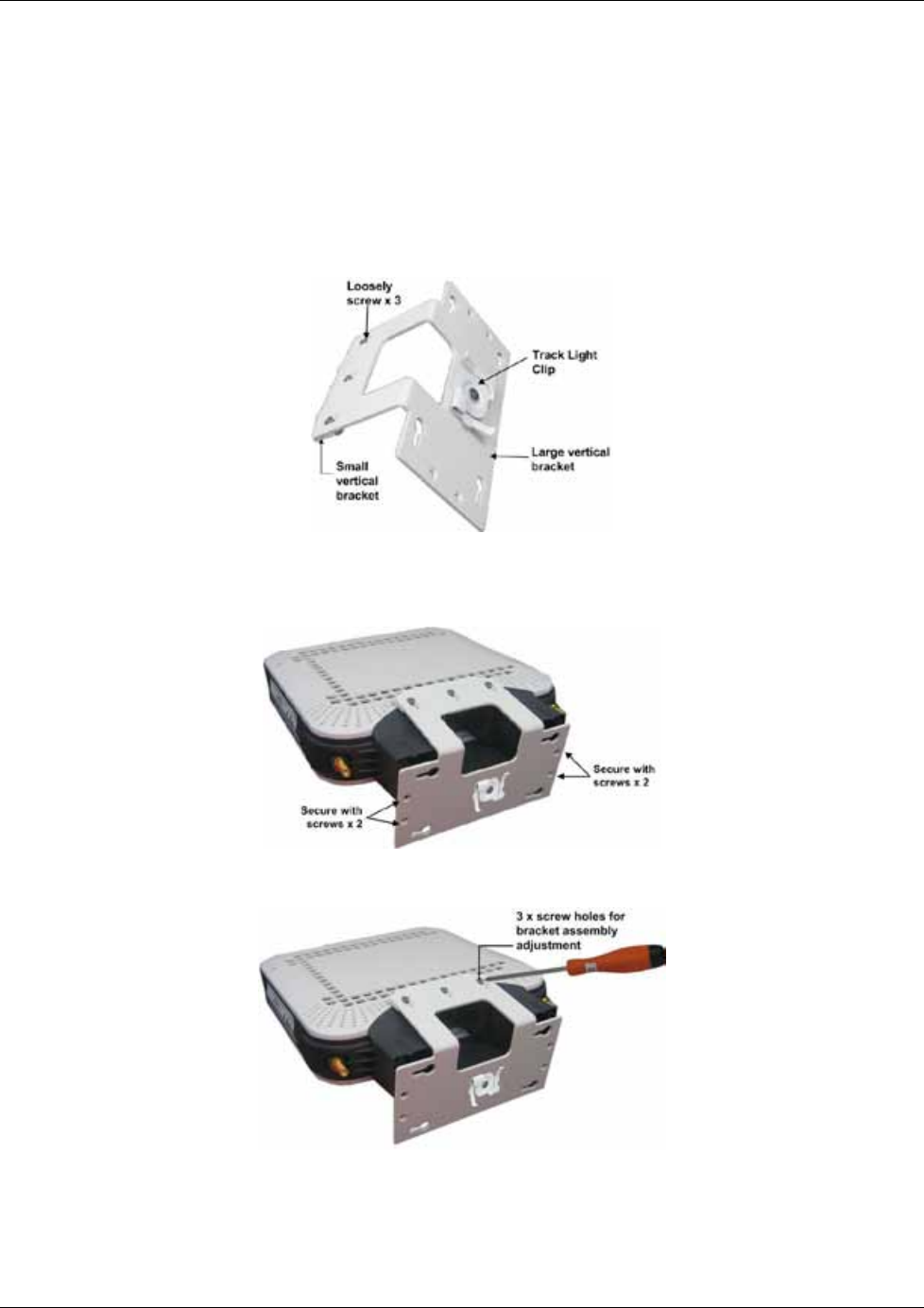
VAP Installation and Provisioning
Dual-Band MobileAccessVE Instant Coverage Solution User Manual 43
5.2.3.2
Lowered Ceiling Installation
To Install VAP in Lowered Ceiling
1.
Loosely
assemble the (2) brackets using the provided Flat Head screws. (The assembly will
be secured at a later stage.)
2. Assemble the Track Light Clip to the Large Horizontal Bracket (top side) using the provided
washer and bolt.
3. Hook the assembly onto the VAP rear panel bottom grid and fit to underside of the VAP.
4. Secure the assembled brackets to the bottom of the VAP using the Self Screws.
5. Adjust the bracket to firmly fit the VAP and tighten the (3) bracket assembly screws.
6. Mount the VAP on the lowered ceiling as follows:
· Enlarge large flanges over opposite sides of T-bar. Note: Apply slight pressure as Twist
Clip is made of spring steel.
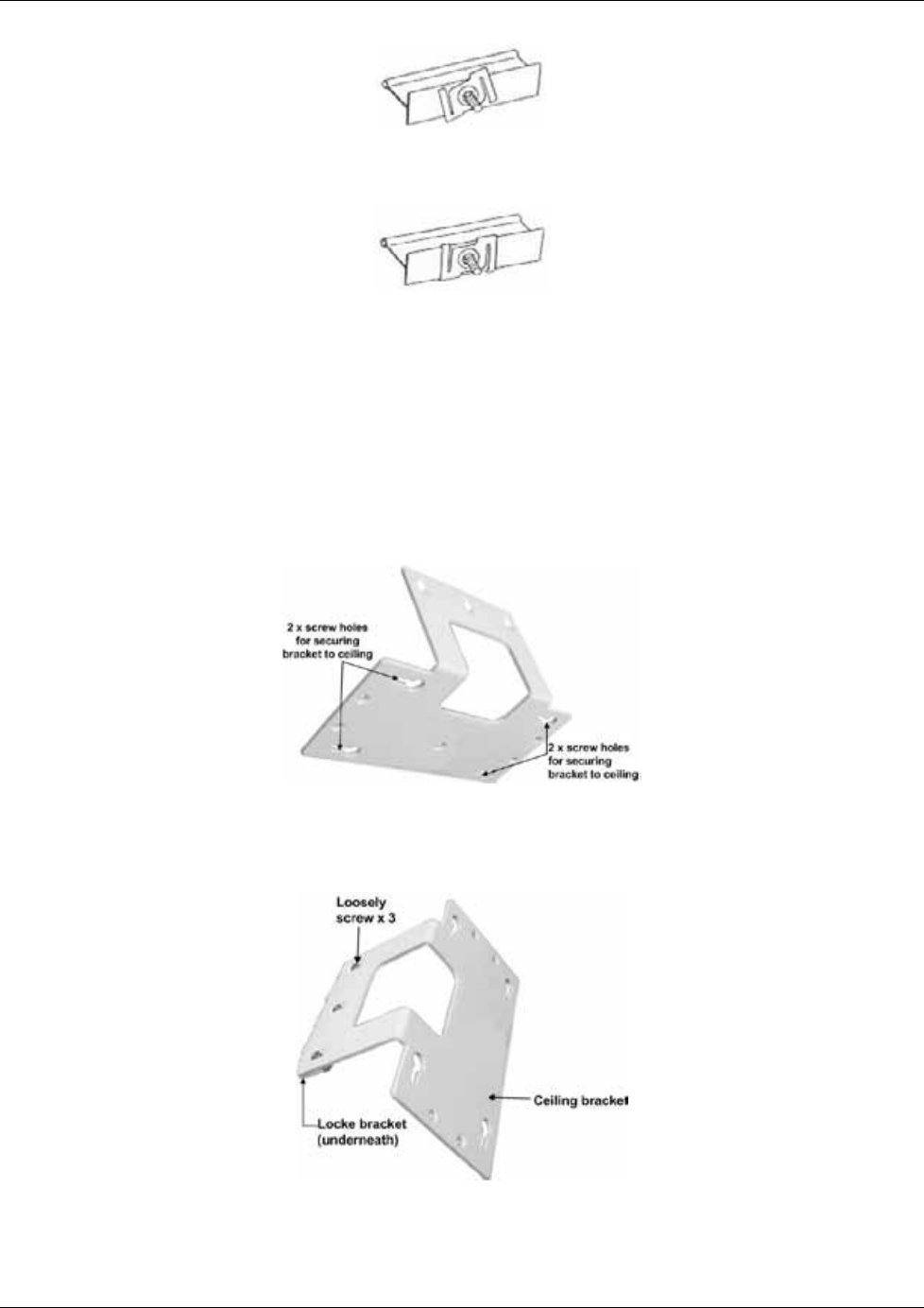
VAP Installation and Provisioning
Dual-Band MobileAccessVE Instant Coverage Solution User Manual 44
· Twist flanges clockwise until small flanges snap over edges. The Twist Clip is now in
position.
· Place stud through 1/2" knock-out. Use 4WN washer-nut combination and tighten
securely.
5.2.3.3
Concrete/Wood Ceiling Installation
To Install VAP in Lowered Ceiling
1. Mark the location of the (4) screws on the ceiling according to the (4) larger holes on the
bracket assembly.
2. Drill the screws in to the marked locations on the ceiling.
3. Align the (3) screw holes of each of the brackets (Ceiling and Locke) as shown in the
adjacent figure and using the Flat Head screws,
loosely
assemble the brackets.
Note: To be
adjusted at a later stage.
4. Fit the assembled brackets on to the VAP by inserting the (3) hooks in corresponding bottom
rear grid of the VAP and fit the other side on to the underside of the VAP.
5. Secure to the underside of the VAP using the (4) supplied Self Screws.
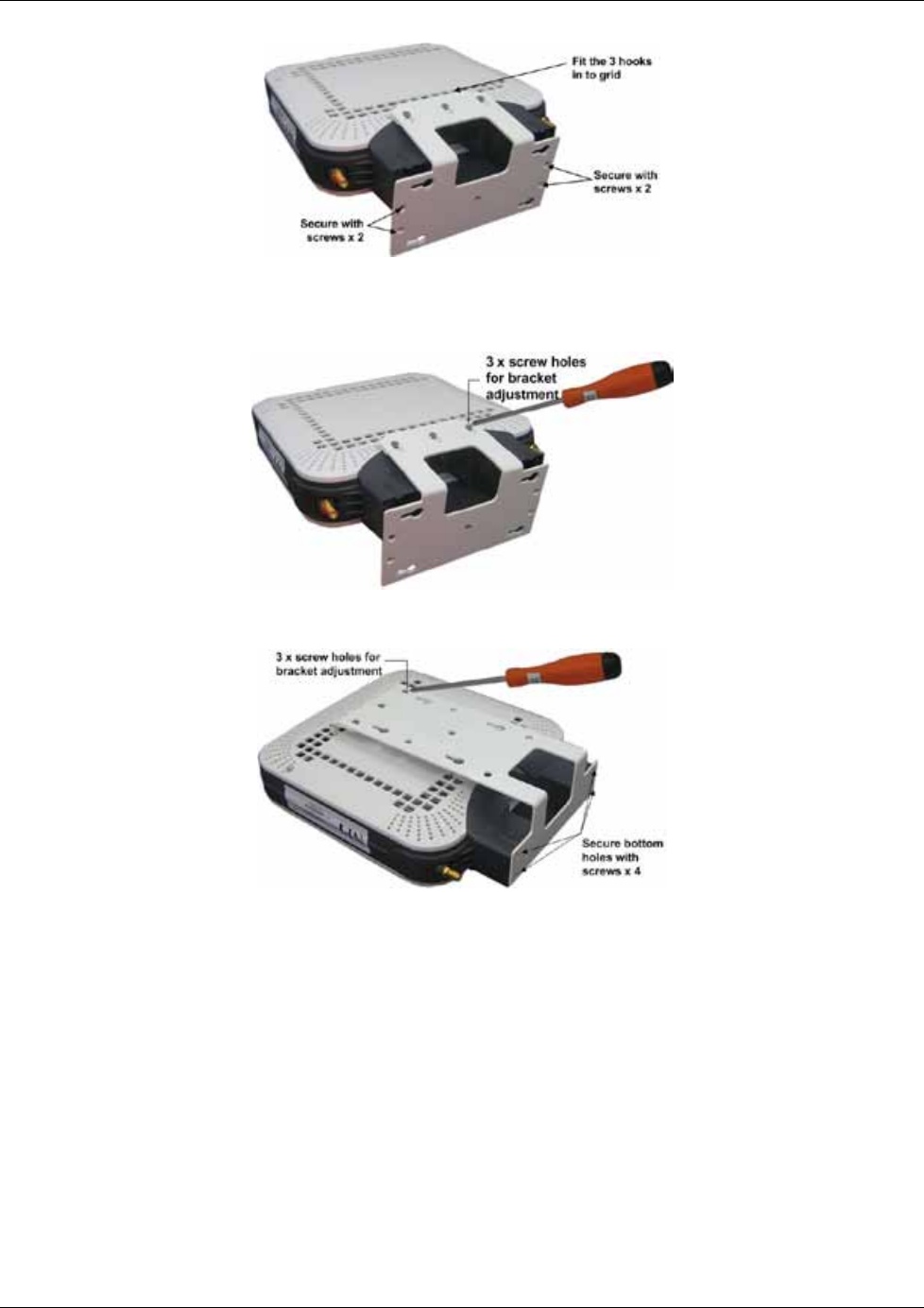
VAP Installation and Provisioning
Dual-Band MobileAccessVE Instant Coverage Solution User Manual 45
6. Tightly adjust the bracket to the VAP and secure the bracket assembly.
7. Hang the VAP on to the (4) screws located on the ceiling, and secure the screws.
8. Hang the VAP using the (4) larger screw holes on to the (4) screws located on the ceiling.
5.3 Verifying Coverage
Verify coverage in the areas, adding and moving VAPs for optimal coverage according to the
principles described in 3.3.
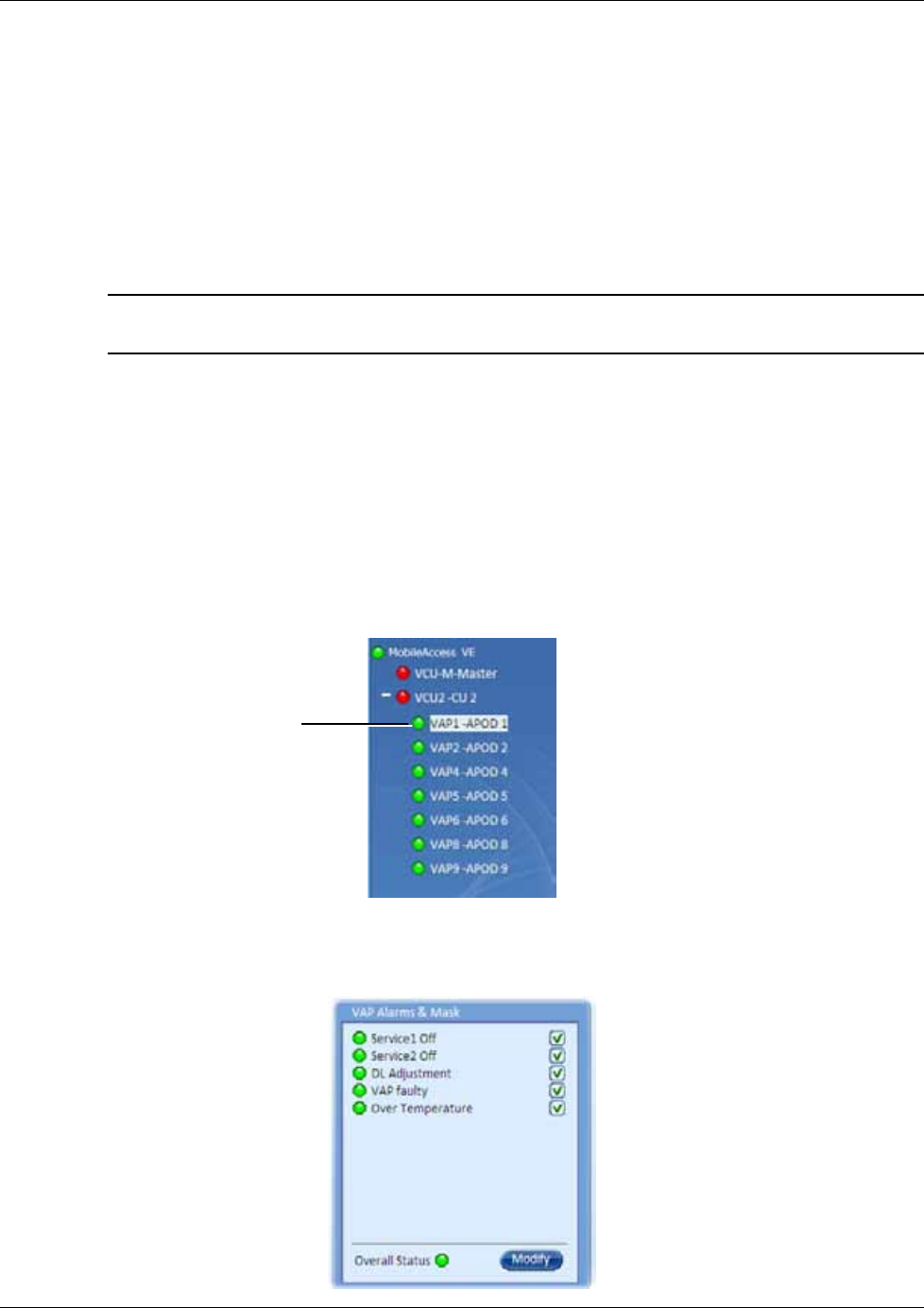
VAP Installation and Provisioning
Dual-Band MobileAccessVE Instant Coverage Solution User Manual 46
5.4 Naming the VAPs, Verifying Connections, and
Monitoring
The VAPs are auto-discovered by the VCU and can be monitored via a remote or a local
connection (to the Master VCU). The VAPs are auto-configured by the VCU without user
intervention (no configuration procedure is required). However, if you wish, you may assign each
VAP an identifiable name corresponding to its physical location.
Note: See section
6 for full explanation about navigating the MobileAccessVE Web GUI
application.
1. If a session in not already open to the MobileAccessVE Web management application, open
a session to the Master VCU according to section 4.4.1.
2. Select a VAP from the Network Topology Tree.
Each VAP has a default name of the form VAP Px-name where:
· Px – Number of Slave VCU port to which the VAP is connected
· Name - User-defined name
3. In the Network Topology Tree under the Control Unit, verify that a GREEN (or RED) circle is
displayed for each connected VAP.
· If a VAP is not green, select the VAP from the network topology tree. Then select the
Config tab. Refer to the Alarms tab work area. The alarms for the selected VAP are
displayed.
Connected VAP
Selected Master VCU
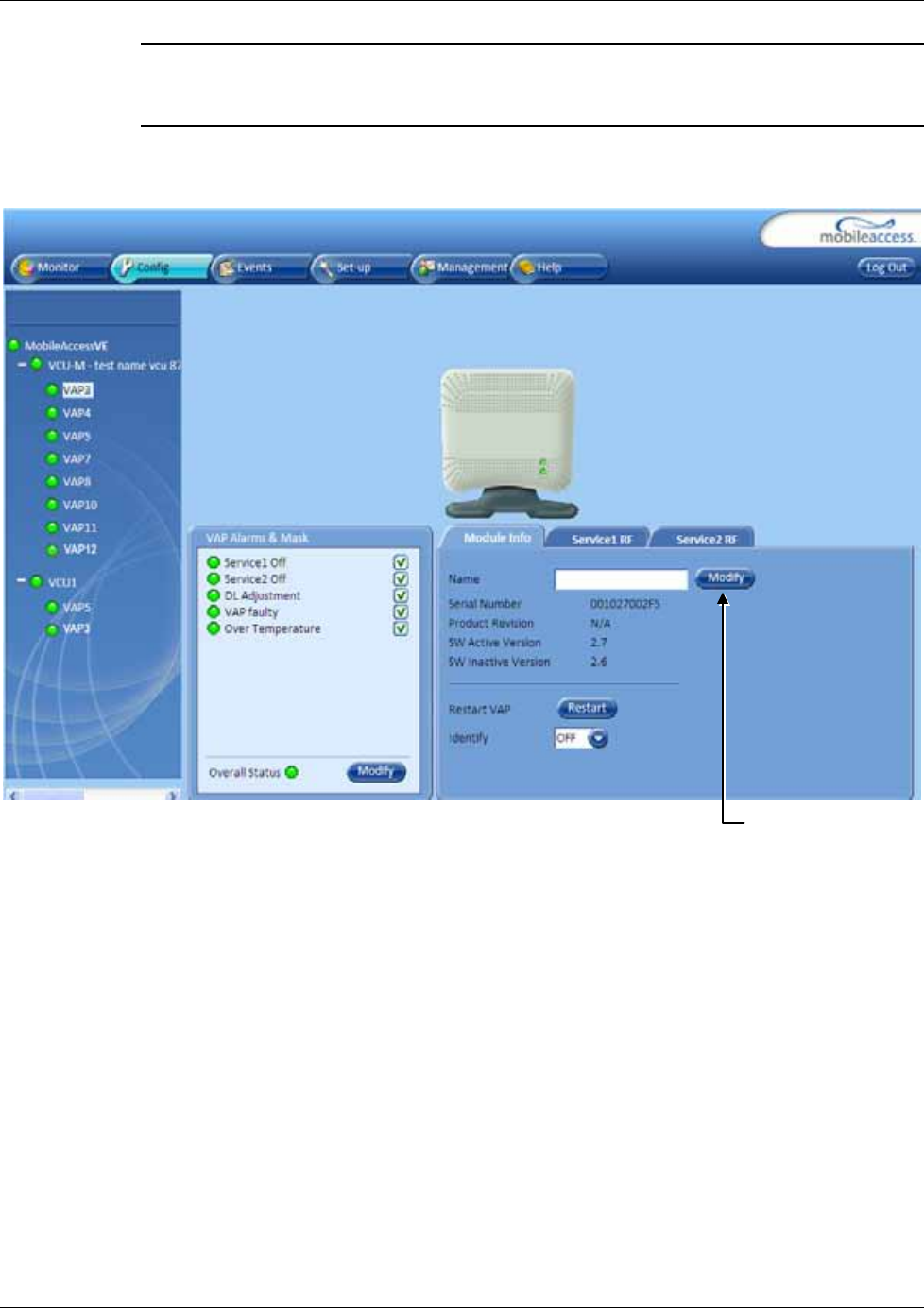
VAP Installation and Provisioning
Dual-Band MobileAccessVE Instant Coverage Solution User Manual 47
Note: VAP alarm mask is saved in the VCU, associated with the port to which the VAP is
connected. In case you replace the VAP, the newly installed VAP will automatically be set
with same alarm mask.
4. Refer to the Config Module info tab.
5. Assign each VAP a name as follows:
· Click the Modify button
· Type the unit name (up to 17 alpha-numeric characters) and click OK
Click Modify button
to assign name
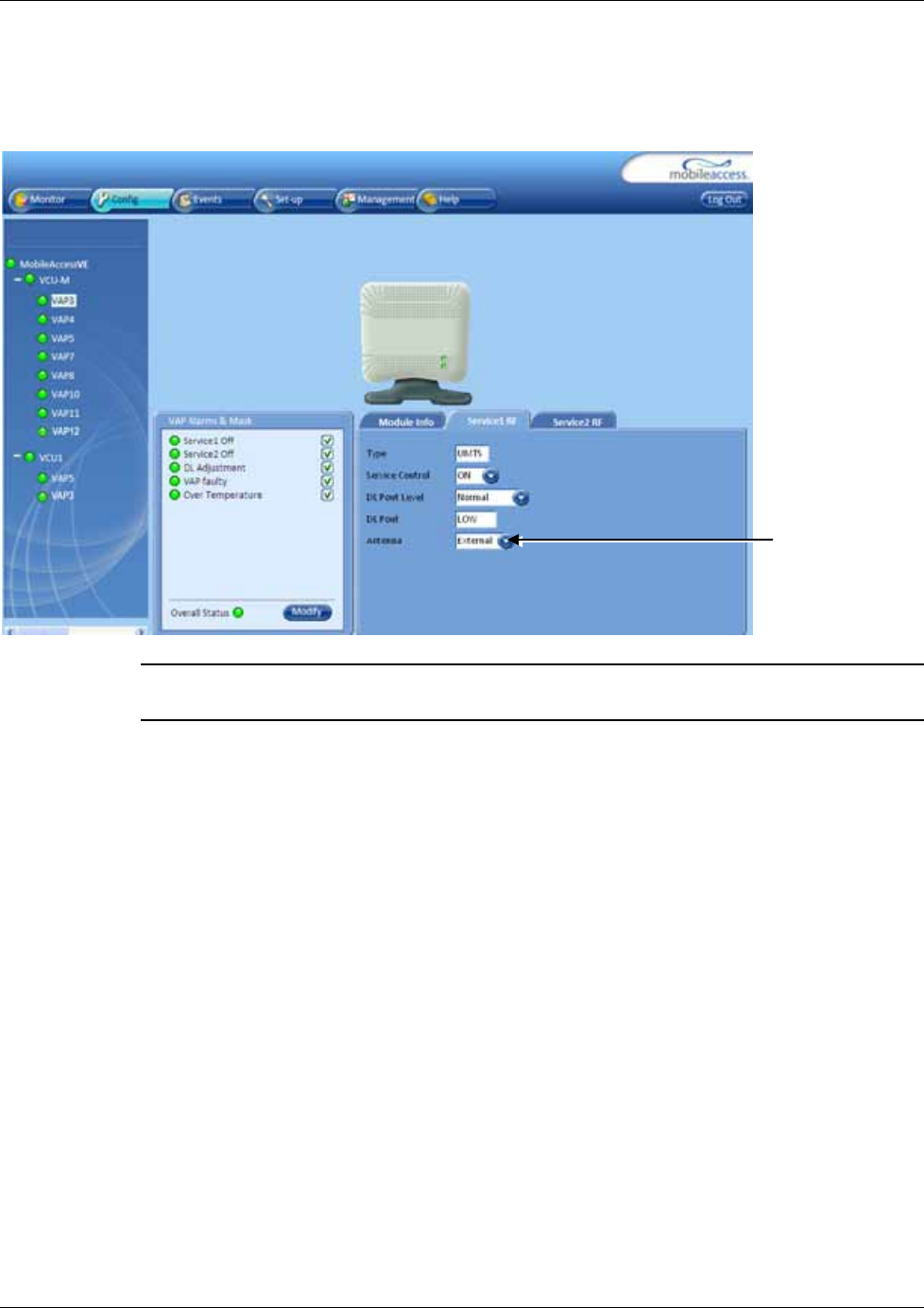
VAP Installation and Provisioning
Dual-Band MobileAccessVE Instant Coverage Solution User Manual 48
6. When required to transmit the RF signal through a connected external antenna:
· Refer to the Service 1 RF and/or Service 2 RF tabs
· Enable the External Antenna option
Note: If the external antenna option is not enabled, the signal will be transmitted via the
integrated internal antenna, by default.
7. Verify the system connections according to the following section (See section 6 ).
Antenna option
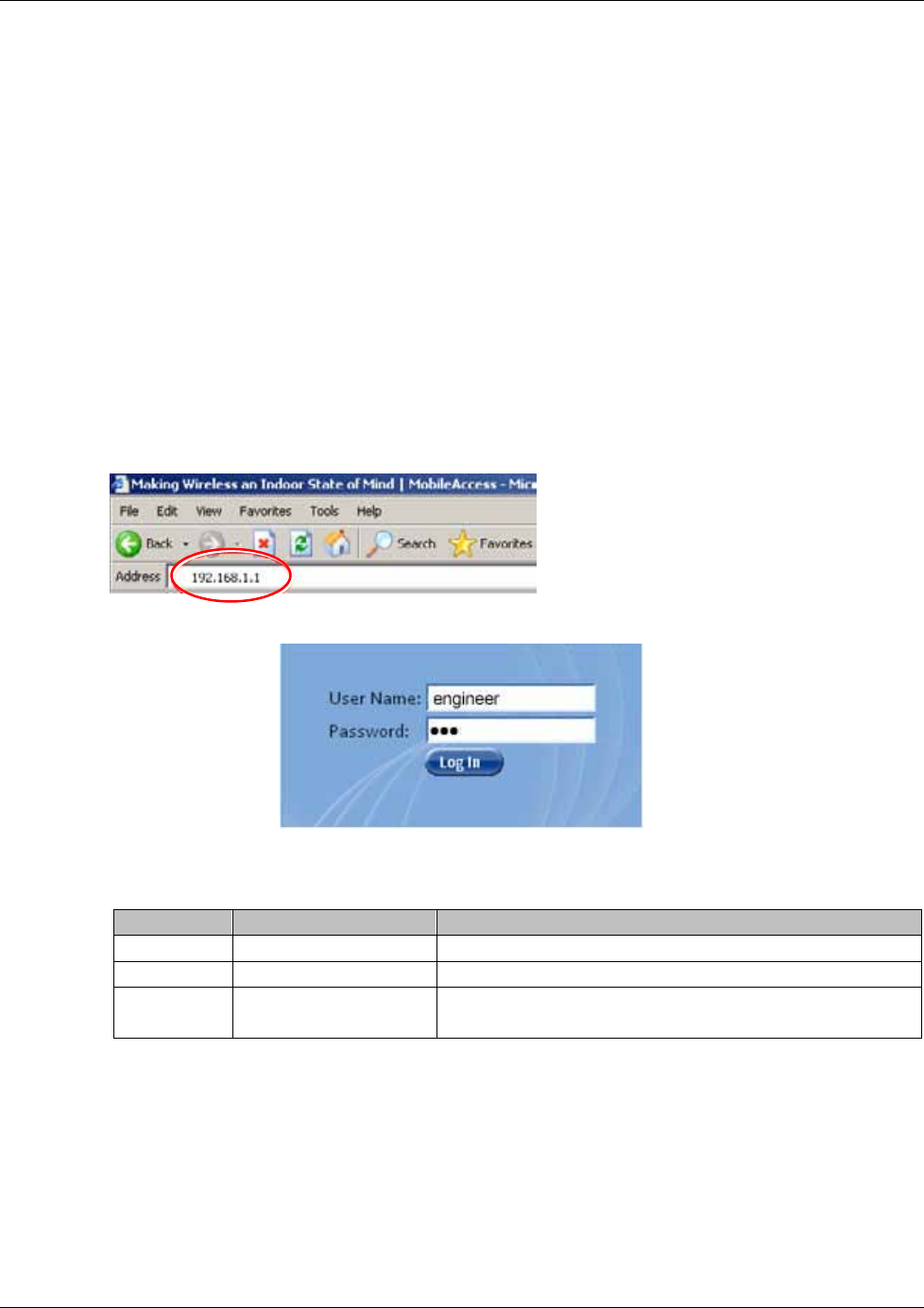
Navigating the Web Access Application
Dual-Band MobileAccessVE Instant Coverage Solution User Manual 49
6 Navigating the Web Access Application
The MobileAccessVE Web management application is accessed through any standard web
browser connected to the Master VCU via a network within the same subnet as the Master VCU
or a different subnet which is routable.
6.1 Opening a Session and Authentication Levels
After the initial configuration (as explained in 4.4.1) the MobileAccessVE system can be accessed
via the network.
To Access the System:
1. Open a web browser. In the address bar type the Master VCU’s IP address as you set it in
the Master VCU configuration operation (See section 4.4.1).
2. The Login pane appears.
Enter your User Name and password. The following authentication levels are available:
Level Default Password
Access
operator
oper
This user has Read Only access.
engineer eng This user has access to basic configuration options.
admin ma98 This user has Field Engineer permissions, in addition to
access to changing passwords.
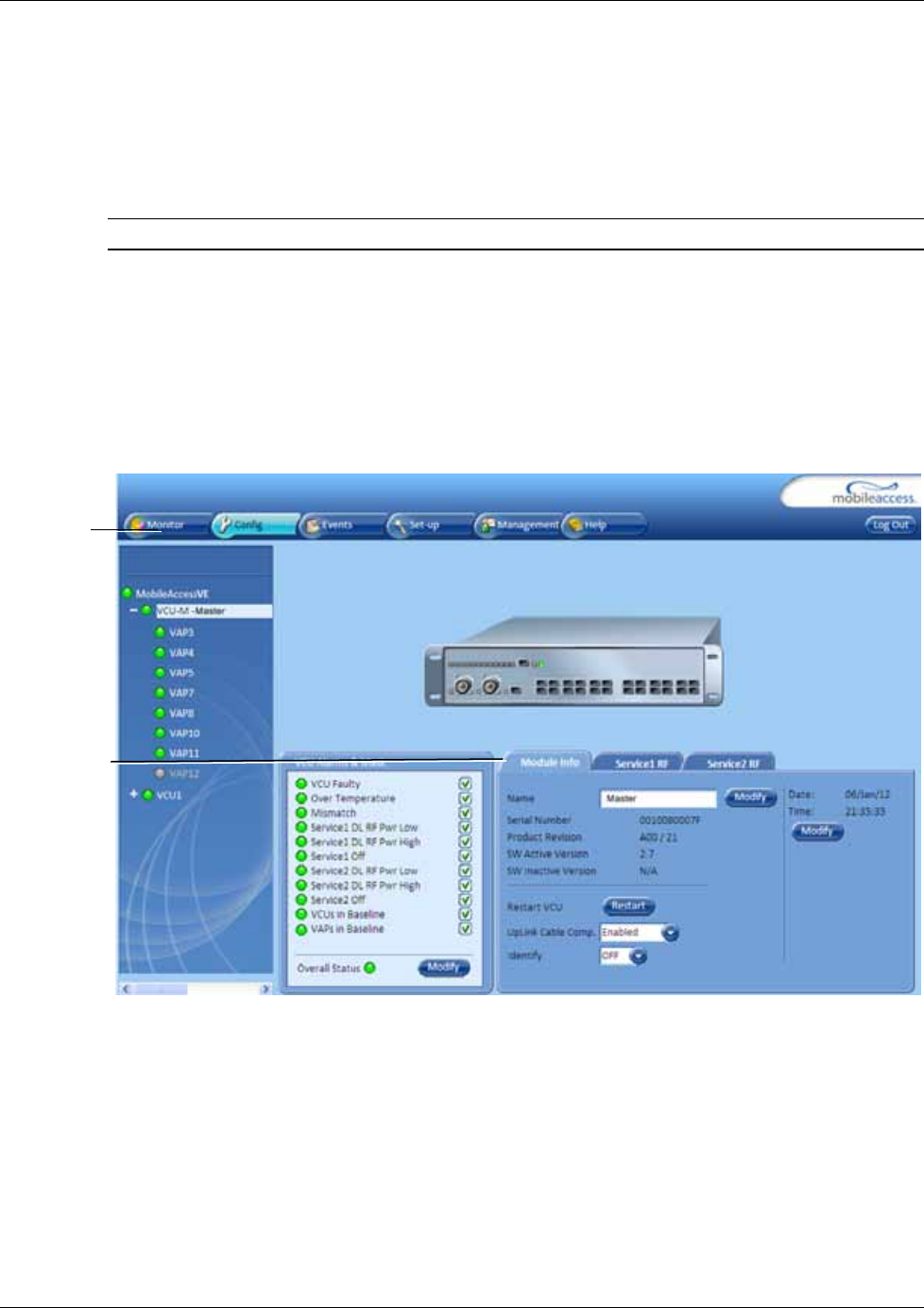
Navigating the Web Access Application
Dual-Band MobileAccessVE Instant Coverage Solution User Manual 50
6.2 About the MobileAccessVE Web Access Window
The MobileAccessVE Web window includes six main tabs that provide access to the applications’
main options. Here the Config tab is displayed by default.
Note: The Monitor, Events, Setup, and Help tab are future options.
The appearance of the each screen varies according to the tab displayed. The Main Menu Bar
tabs are:
· Config(uration) – Displayed by default upon login. Provides the selected units’
configuration parameters and alarms
· Management - Provides upgrade, IP configuration and security options
Both of these tabs are described in detail in the following sections
Menu Bar
Sub-
tabs
Corresponding
to Menu Bar
Options
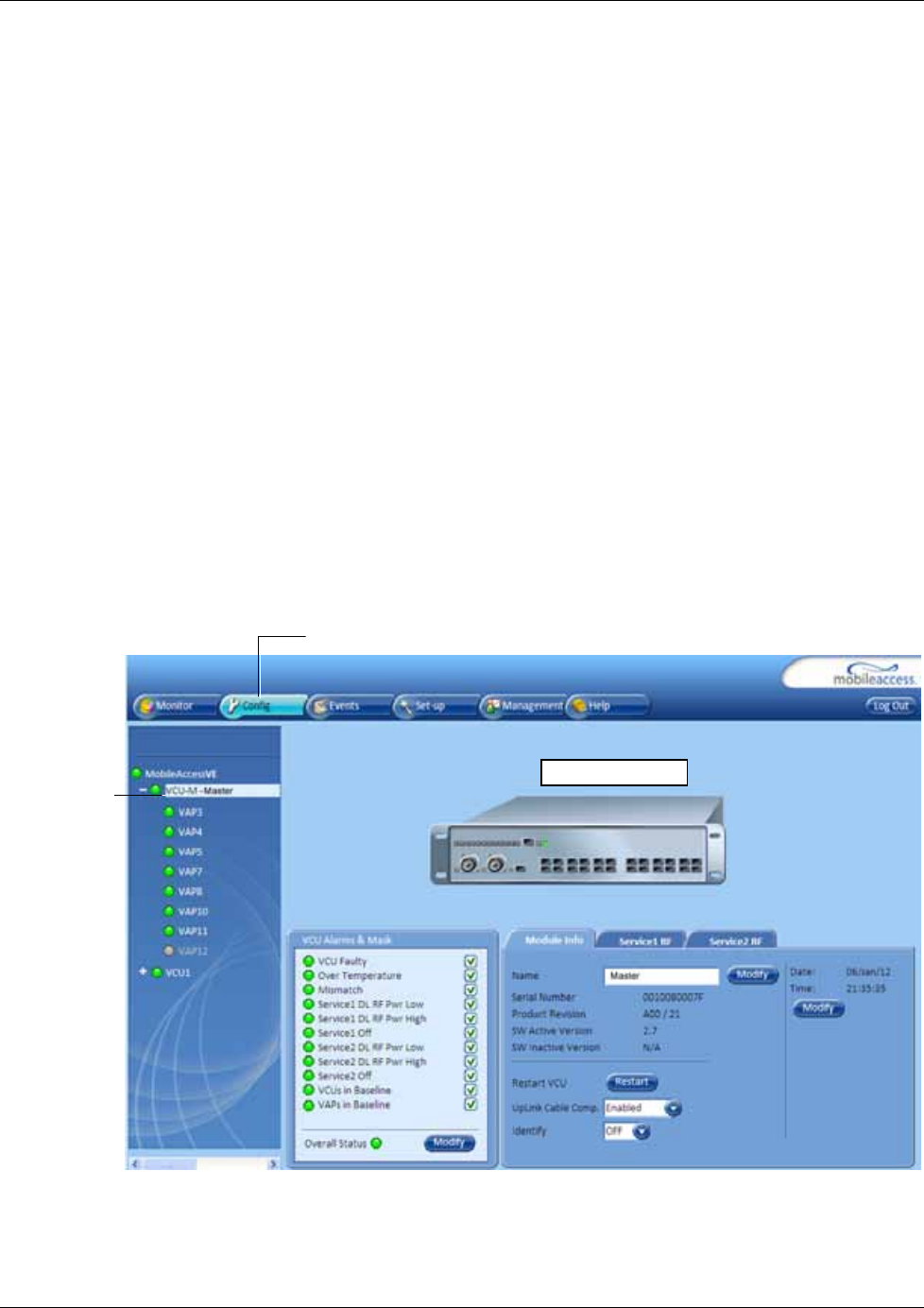
Navigating the Web Access Application
Dual-Band MobileAccessVE Instant Coverage Solution User Manual 51
6.3 Configuration Tab
The Configuration tab provides the general information and service RF parameters for
configuration of the units appearing in the Network Topology tree.
To Access a VCU Configuration Tab
On the left hand side of the window select a Master VCU/Slave VCU from the network topology
tree. Select the Configuration tab from the menu-bar. The information and parameters
displayed in the Configuration sub-tabs vary depending on whether a VCU or VAP is selected in
the topology tree.
The Configuration tab is divided in to three main areas:
· Network Topology Tree – Displays the system units (Master VCU, Slave VCUs and VAPs)
and their status.
· Display Area – Displays the icon of the selected unit including the LED statuses.
· Work Area – Displays the Module Info, alarms, and RF tabs corresponding to the unit
selected in the topology tree (Master VCU, Slave VCU or VAP).
Selected
VCU
VCU Icon display
Configuration Tab
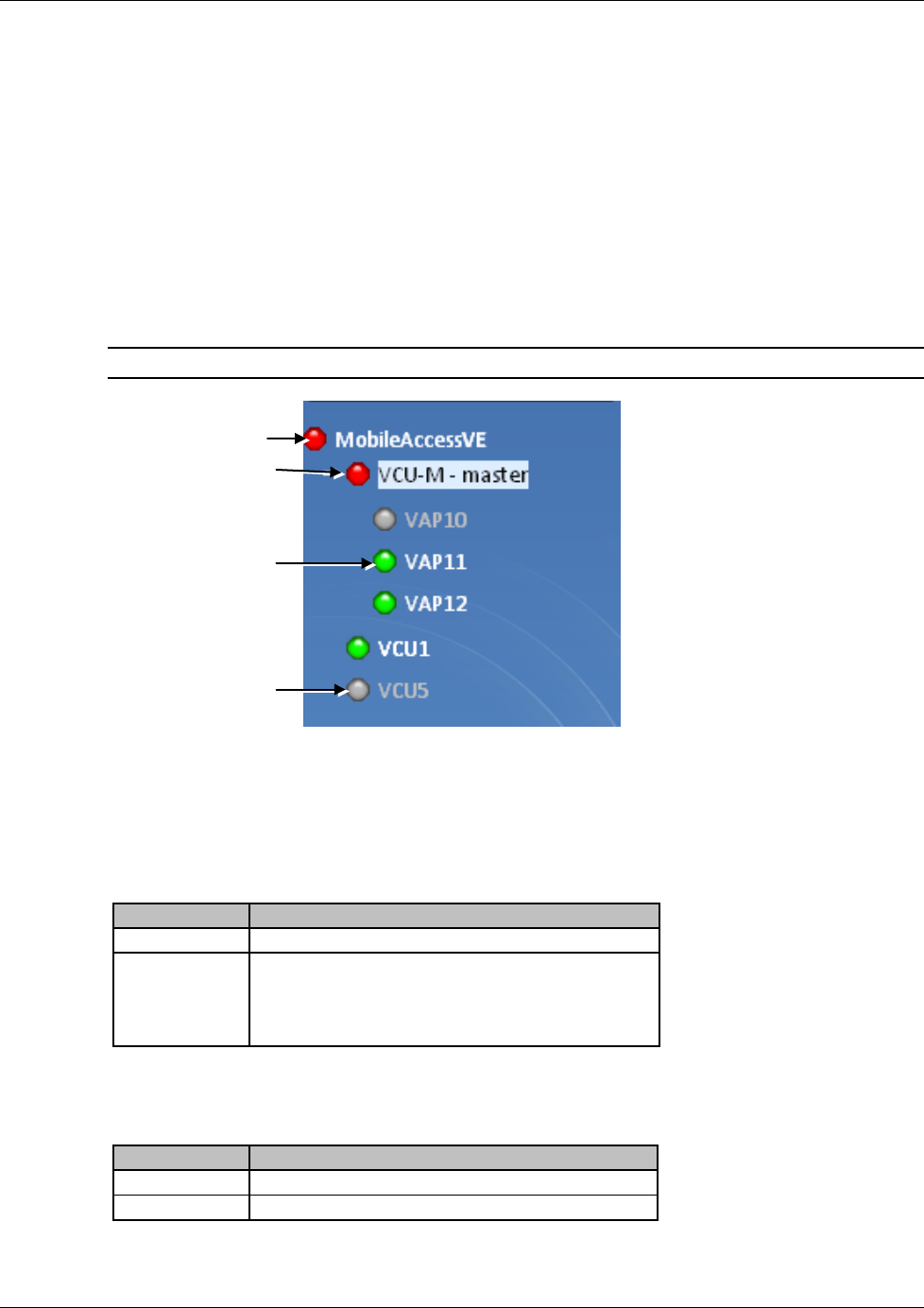
Navigating the Web Access Application
Dual-Band MobileAccessVE Instant Coverage Solution User Manual 52
6.3.1 Network Topology Tree
The Configuration Network Topology Tree appears on the left hand side when the Config tab is
selected. Connected Slave VCUs and VAPs are automatically detected and displayed in the
topology. The VE Web Access Application includes a Baseline feature providing an indication on
network elements (VCUs/VAPs), which were disconnected from the VE network. Connected VCUs
and VAPs are automatically added to the Baseline upon detection, and will appear in the
topology as grayed out in case they are disconnected. The network elements are displayed in
two levels:
· First Level – Up to 12 VCUs
· Second Level – Up to 12 VAPs connected to each VCU
Note: The root is MobileAccessVE.
Each unit is assigned a Type Px-name:
· Type – VCU-M, VCU or VAP (for Master VCU, Slave VCU or VE Access Pod)
· Px - VCU port number
· Name – User defined
Each unit is displayed with a colored bullet that indicates its’ status:
Color
Indicates
Green OK
Red Alarm Condition
Gray Disconnected unit (e.g. faulty connection).
Generates RED Baseline alarm in Alarms tab
(see 7.2).
The root (the entire MobileAccessVE site) is also associated with a colored bullet that indicates
the overall status of the deployment:
Color
Indicates
Green OK
Red Alarm Condition in one or more VCUs or VAPs
Root
Master VCU –
First
Level
VAP – Second
Level
Disconnected Unit

Navigating the Web Access Application
Dual-Band MobileAccessVE Instant Coverage Solution User Manual 53
6.3.1.1
Removing Network Element from Baseline
The Baseline automatically detects the connected units (VCUs and VAPs) and when for some
reason a unit is disconnected or the connection with it is no longer detected it will not disappear
from the topology but will appear in gray. In addition, the Baseline alarm in the Alarm tab will
appear in Red.
In order to remove a unit from the baseline so that it no longer appears in the network topology,
it must be done via the GUI from either the Topology Tree or unit icon.
To Remove a Unit from the Baseline
1. Click on the unit in the Topology Tree or on the unit icon (for example, VAP). The following
dialog appears:
2. Click OK. The unit will no longer be displayed in the Network Topology Tree and the
Baseline Alarm will show Green.
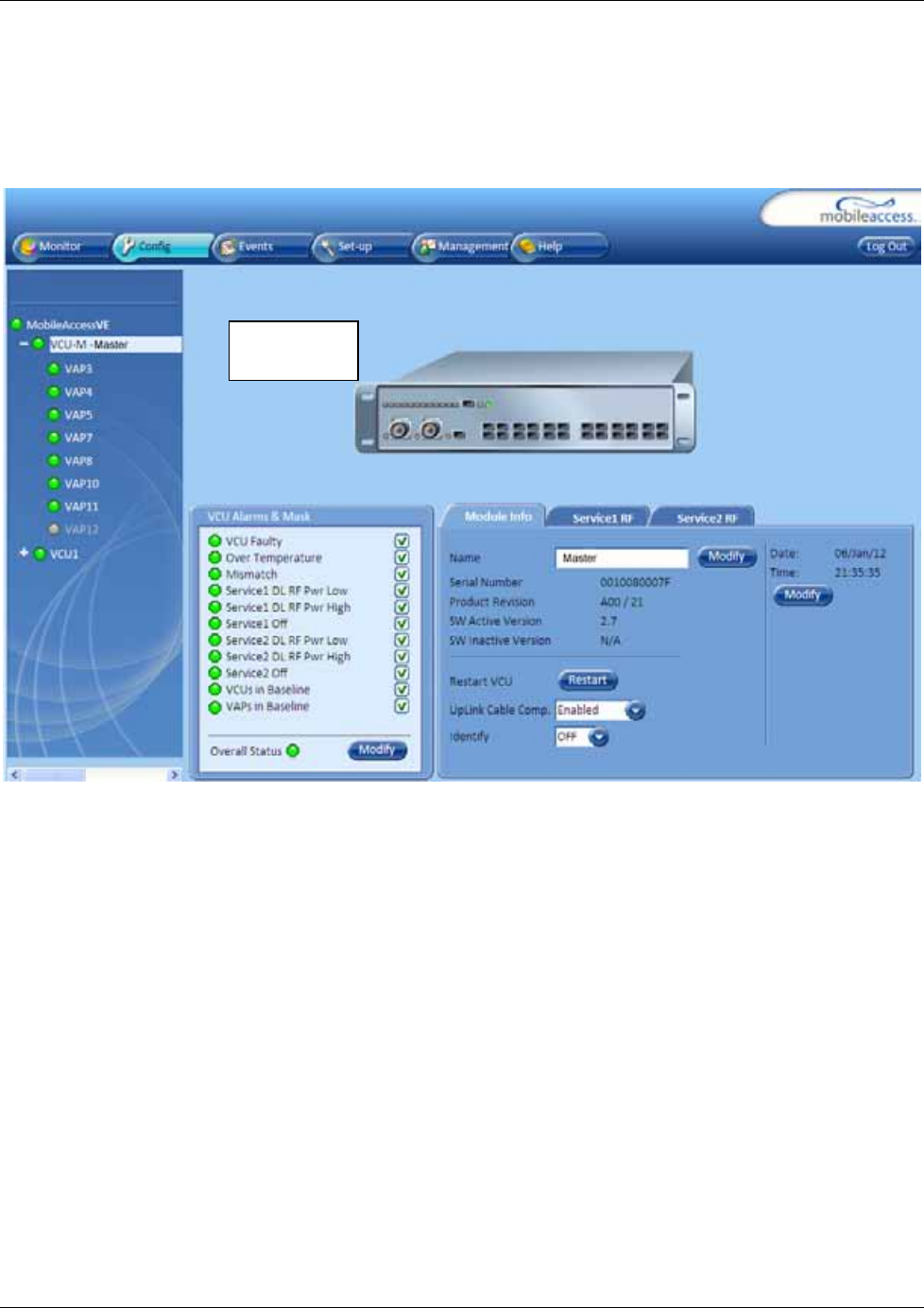
Navigating the Web Access Application
Dual-Band MobileAccessVE Instant Coverage Solution User Manual 54
6.3.2 Configuration Display Area
When selecting an element (Master VCU/Slave VCU or VAP) in the network topology tree, an
icon representing the unit is displayed in the Configuration tab display area.
Icon Display
Area
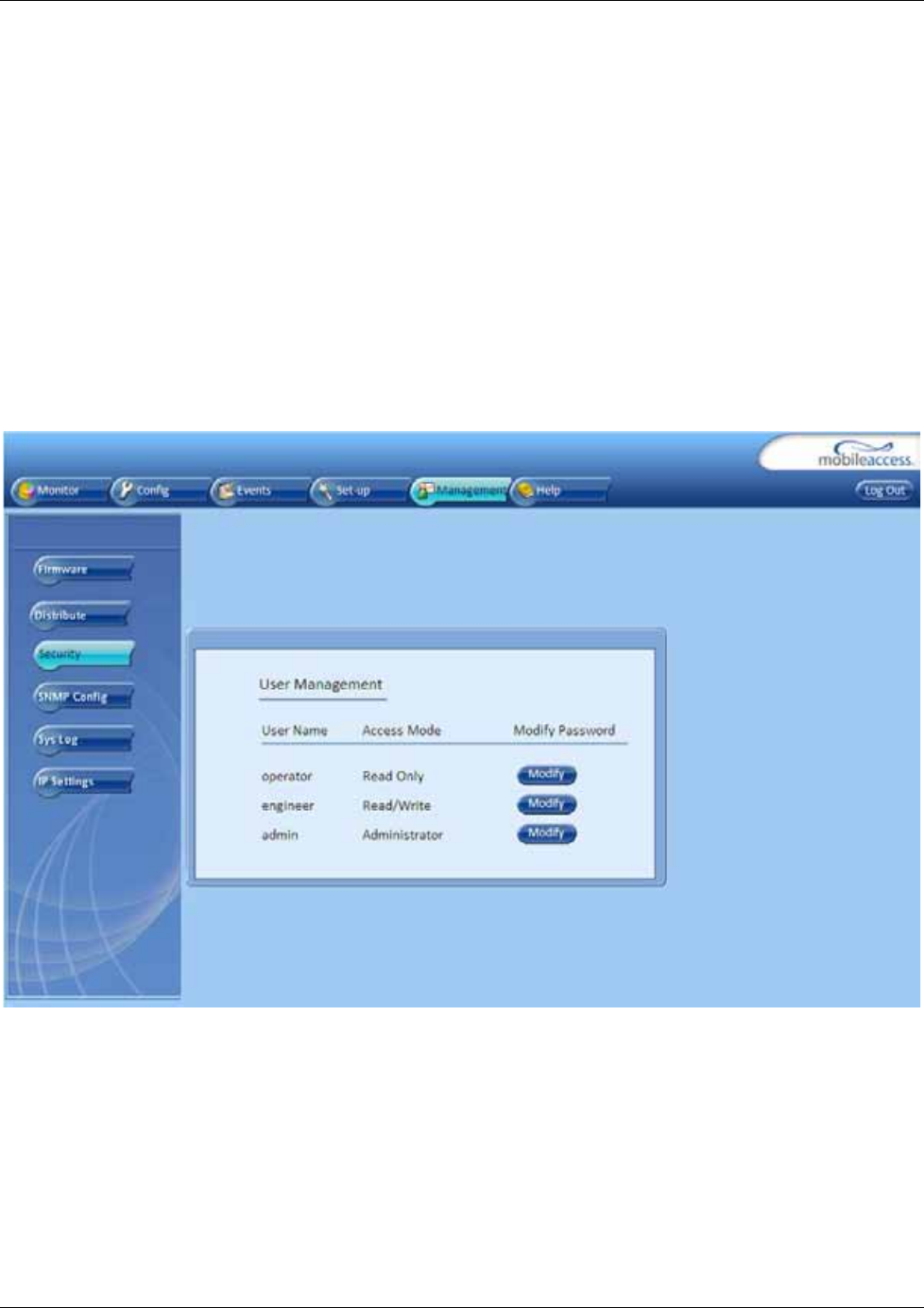
Navigating the Web Access Application
Dual-Band MobileAccessVE Instant Coverage Solution User Manual 55
6.4 Management Tab
The Management tab provides user administrative management options and includes the sub-
menu tabs:
· Firmware – Used for upgrading/downgrading SW to VCUs.
· Distribute – Used for distributing the upgrade/downgrade SW files to the VAPs.
· Security – Used for changing user passwords.
· SNMP Config – Used for defining the SNMP communities and trap destinations.
· IP Settings – Used for viewing and modifying the network parameters.
· Sys(tem) Log – N/A
The following figure shows the Management screen with the menu options on left.
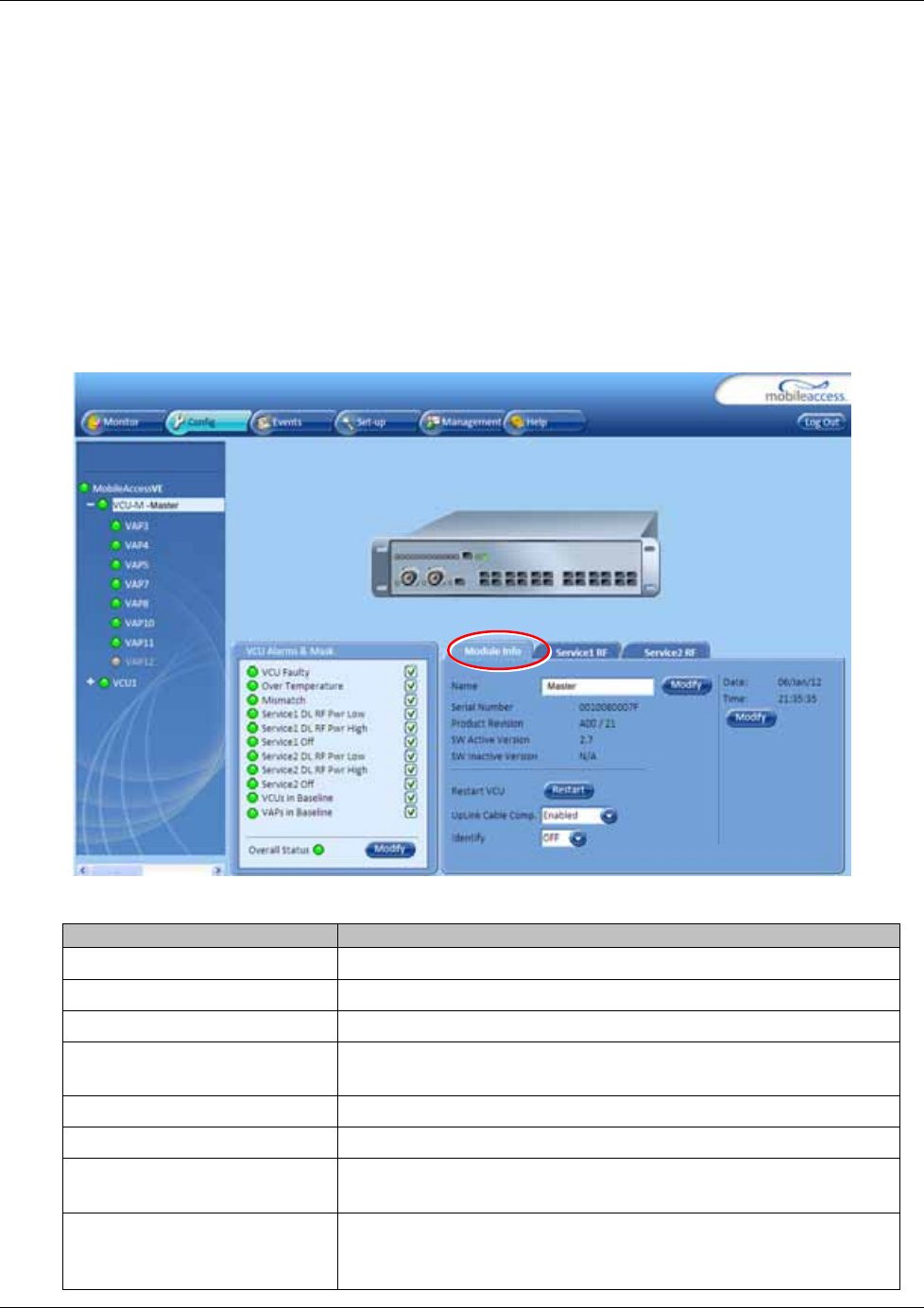
VCU Monitoring and Configuration
Dual-Band MobileAccessVE Instant Coverage Solution User Manual 56
7 VCU Monitoring and Configuration
7.1 Viewing VCU General Information
The VCUs general information, such as unit name and SW versions, can be viewed in the Config
Module Info sub-tab.
To View VCU General Information
· Click the Config tab from the main menu and select the VCU from the network topology
tree. The Module Info sub-tab is displayed by default.
The following information is displayed:
Field
Description
Name User defined name for system element (up to 17 characters)
Serial Number Factory set ID number
Product Revision Revision number of VCU/VAP
SW Active Version Version of the SW currently being used to manage and monitor
the system
SW Inactive Version Version of other system SW version not in use
Restart VCU Button SW reset of the unit
Uplink Cable Compensation Used to minimize interference that may be caused by bonded
cables that vary in length
Identify Enabling this option enables finding the physical location of the
selected element (See section 10.1). When this option is set to
ON, the LEDs on the corresponding VAP/VCU flickers.
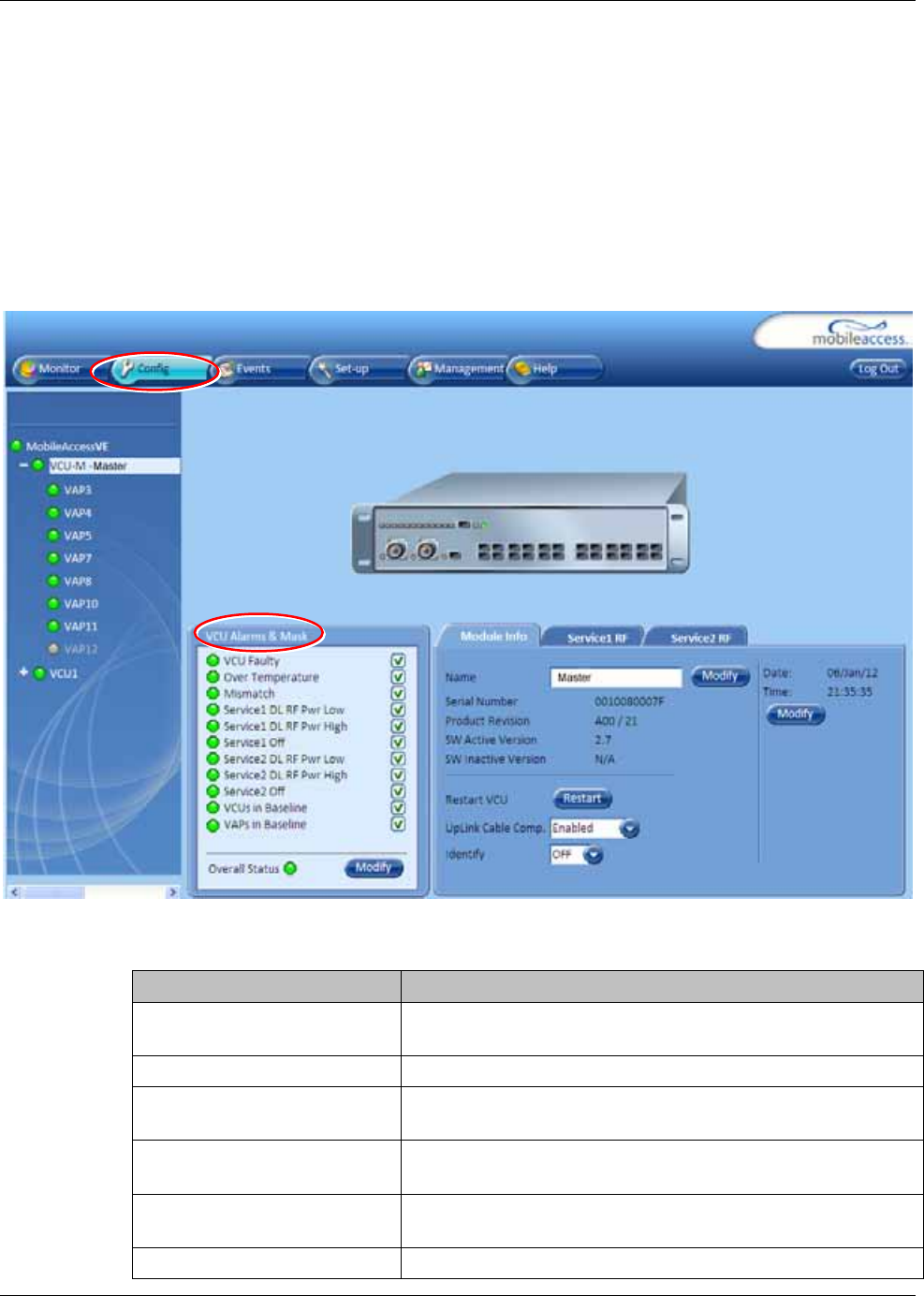
VCU Monitoring and Configuration
Dual-Band MobileAccessVE Instant Coverage Solution User Manual 57
7.2 Viewing VCU Alarms
The alarms displayed in the Alarms tab correspond to the VCU (Master/Slave) selected in the
topology tree. When a VCU element is selected in the topology tree, the Alarm tab displays the
main alarms in the unit.
To View VCU Alarms
In the Topology Tree select the Control Unit (VCU) then click the Config(uration) tab in the
menu bar located at the top of the window. Refer to the VCU Alarms and Mask sub tab.
If one or more alarms occur, the corresponding Status indicator will be illuminated in RED. If the
VCU is OK and no fault occurs, the Overall Status indicator will show GREEN.
Alarm Description
VCU Faulty RED - VCU fault. Remove and re-apply power to VCU. If
problem persists, replace VCU.
Over Temperature Temperature of unit exceeds normal range.
Mismatch Red – Mismatch of services (e.g. CELL/PCS VAP connected
to EGSM/UMTS VCU, VCU connected to slave VCU etc.).
Service 1 DL RF Pwr Low RED - DL RF Power is lower by 15dBm (or more) from the
Max Expected Pin.
Service 1 DL RF Pwr High RED - the input power exceeds the maximum expected Pin
by more than 3 dB.
Service 1 Service Off User has disabled Service 1.
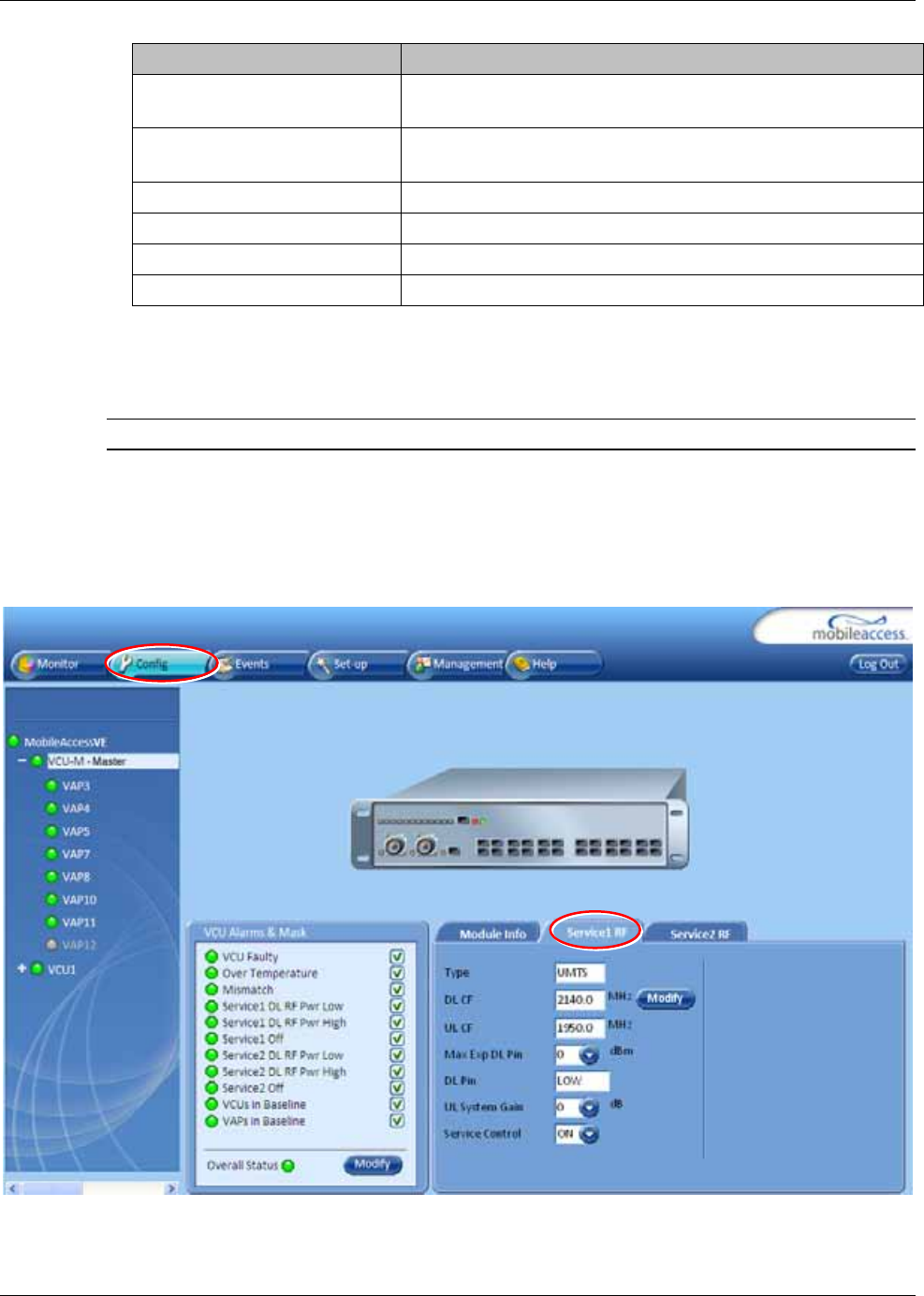
VCU Monitoring and Configuration
Dual-Band MobileAccessVE Instant Coverage Solution User Manual 58
Alarm Description
Service 2 DL RF Pwr Low RED - DL RF Power is lower by 15dB (or more) from the
Max Expected Pin.
Service 2 DL RF Pwr High RED - the input power exceeds the maximum expected Pin
by more than 3 dB.
Service 2 Service Off User has disabled Service 2.
VCUs in Baseline RED – Communication lost with VCU defined in baseline
VAPs in Baseline RED - Communication lost with VAP defined in baseline
Overall Status Indicates Fault (RED) level or GREEN if there are no faults.
7.3 Master VCU RF Parameters
Note: The RF parameters are not displayed for control units functioning as Slave VCUs.
To Access the Service RF Tab
Click the Config tab from the main menu bar and then select the Master control unit from the
network topology and click the
Service RF
tab. The parameters displayed in Service RF tabs
correspond to the selected element.
Figure 7-1. Service RF Tab for UMTS Service (similar for EGSM and DCS)
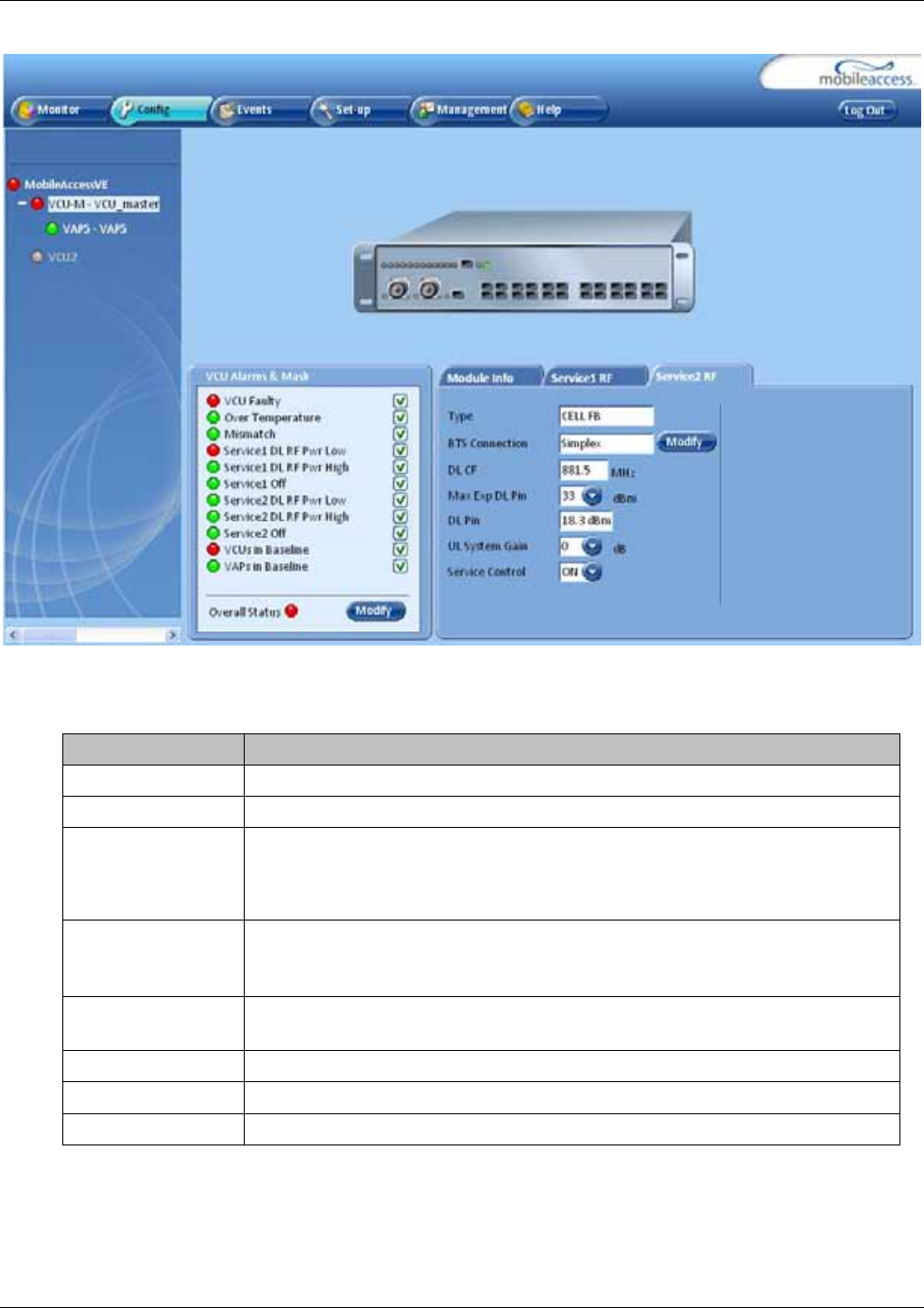
VCU Monitoring and Configuration
Dual-Band MobileAccessVE Instant Coverage Solution User Manual 59
Figure 7-2. Service RF Tab for CELL/PCS
The following table provides a description of the RF parameters displayed in the Service RF tabs.
Parameter Description
Type Set (read only) according to unit type (e.g. EGSM / UMTS)
BTS Connection* Type of BTS RF connection (Simplex/Duplex)
DL CF
DL Center frequency (from BTS):
· **For EGSM/DCS/UMTS - User defined, according to connected service
· For CELL/PCS – Read Only
UL CF UL center frequency (from BTS) – corresponding to defined DL Center
Frequency. Automatically assigned by the system according to the DL
frequency
Max Exp Pin** Maximum expected input power from the BTS. Used for adjustment
procedure. Range: 0-33 dBm. User defined.
Pin Actual measured Pin (read only)
UL System Gain Used for adjusting the UL system gain. Range: -15dB to +5dB
Service Control Enables (On)/Disables (Off) the service
* Appears in CELL/PCS Full Band GUI only.
** Required parameters to be provisioned by the user.
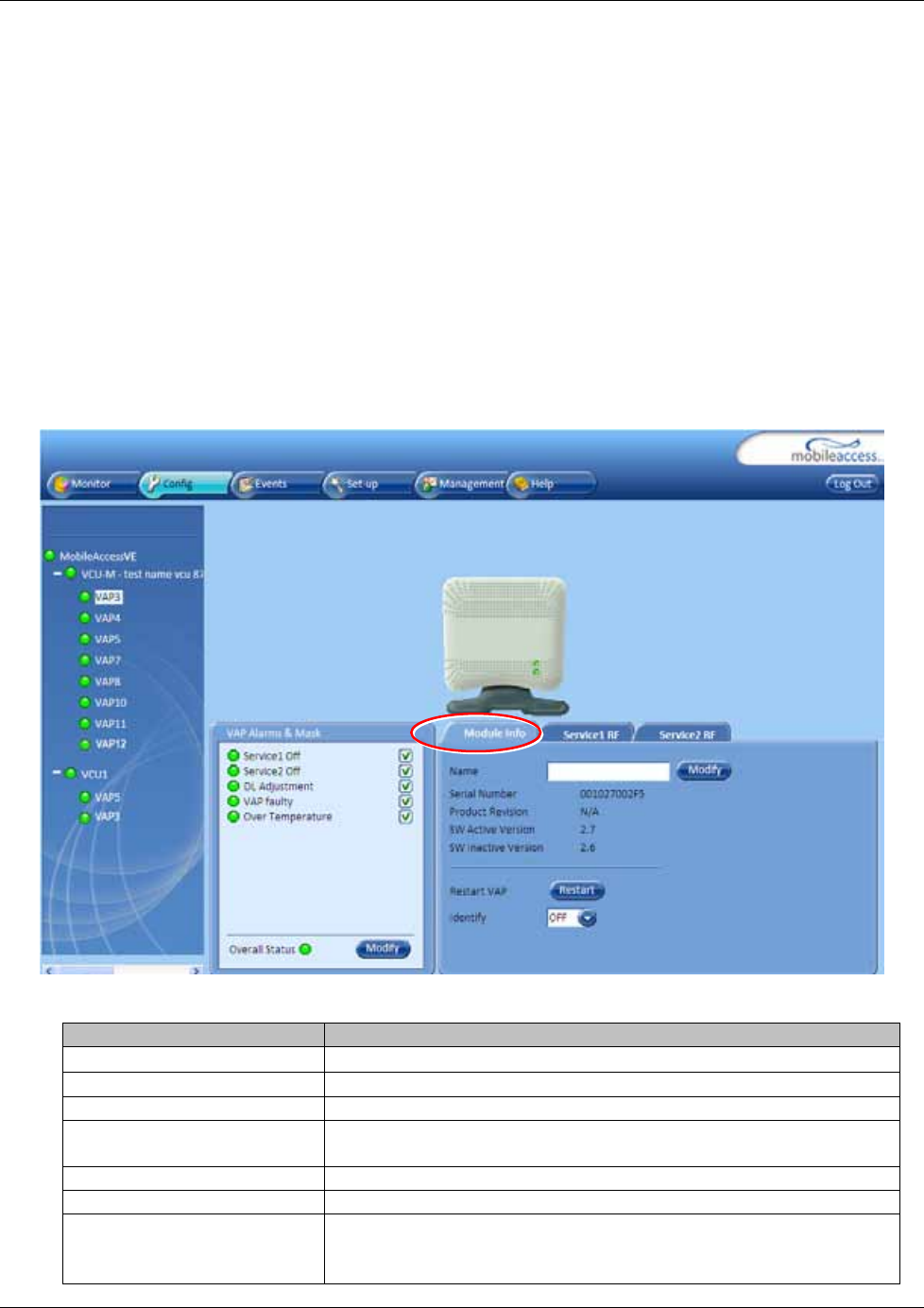
VAP Monitoring and Configuration
Dual-Band MobileAccessVE Instant Coverage Solution User Manual 60
8 VAP Monitoring and Configuration
8.1 Viewing VAP General Information
The VAPs general information, such as unit name and SW versions, can be viewed in the Config
Module Info sub-tab.
To View VAP General Information
Click the Config tab in the main menu and select the VAP from the network topology tree. The
Module Info sub-tab will be displayed by default.
The following information is displayed:
Field
Description
Name
User defined name for system element (up to 17 characters)
Serial Number Factory set ID number
Product Revision
Revision number of VCU/VAP
SW Active Version Version of the SW currently being used to manage and monitor
the system
SW Inactive Version Version of other system SW version not in use
Restart VAP Button
SW reset of the unit
Identify Button Enabling this option enables finding the physical location of the
selected element (See section 10.1). When this option is set to
ON, the LEDs on the corresponding Access POD/VCU flickers.
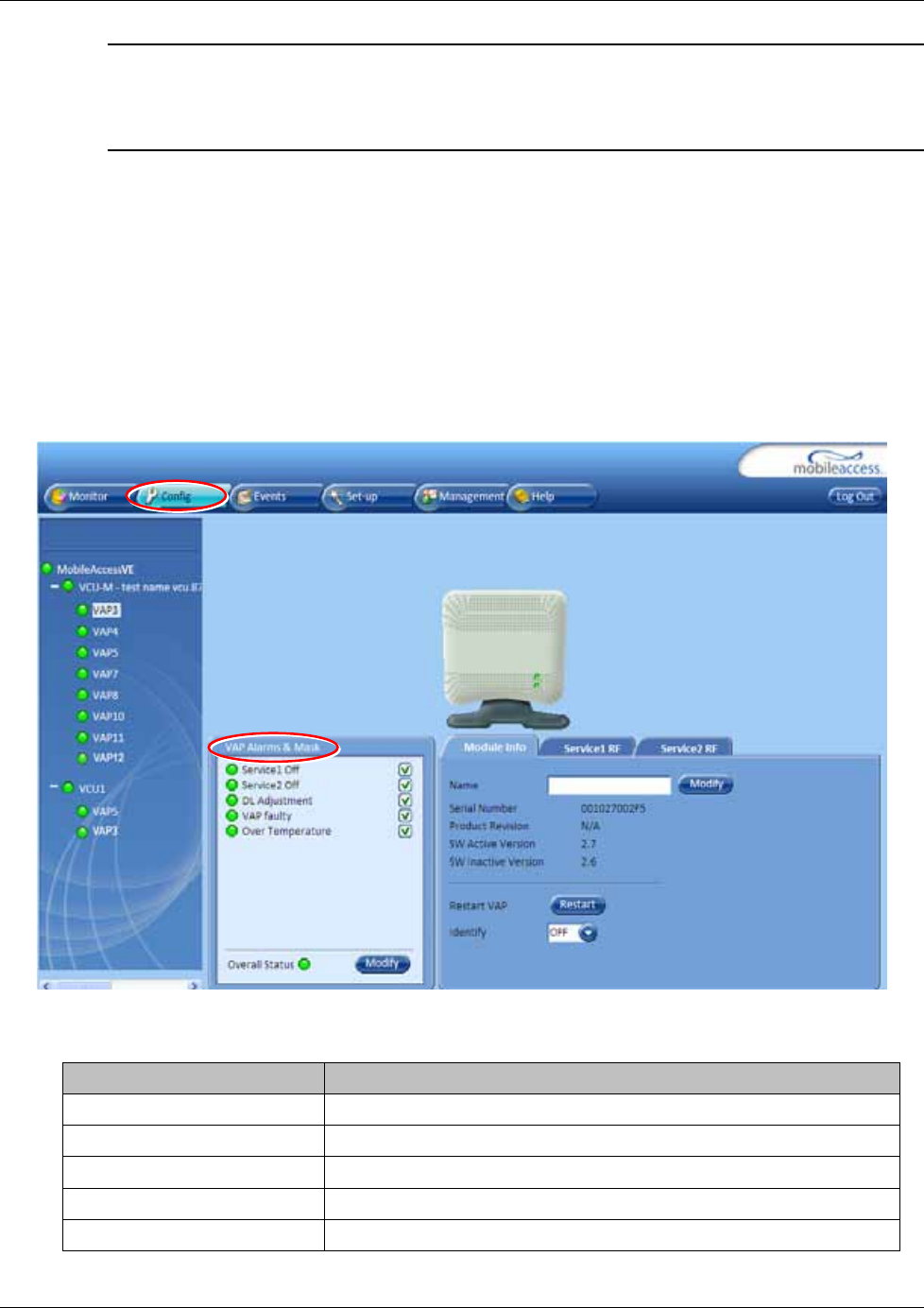
VAP Monitoring and Configuration
Dual-Band MobileAccessVE Instant Coverage Solution User Manual 61
Note: VAP Name is saved in the VCU associated to the port to which the VAP is connected, such
that in case you replace a VAP, the new one will be associated with the same name. In case you
do not want to keep the configuration of the replaced VAP, remove it from the topology baseline
before connecting the new VAP.
8.2 Viewing VAP Alarms
When a VAP element is selected in the topology tree, the Alarm tab displays the main alarms in
the unit.
To Access VAP Alarms Tab
Click the Config tab in the main menu and select the VAP from the network topology tree.
Select the VAP Alarms sub tab.
If one or more alarms occur, the corresponding Status indicator will be illuminated in RED. If the
VAP is OK and no fault occurs, the Overall Status indicator will show GREEN.
Alarm Description
Service 1/2 Off User has disabled the service
DL Adjustment Cable (between VCU to VAP) is too long (over 100m/300ft)
VAP Faulty A fault has been detected in the VAP
Overall Temperature Temperature of unit exceeds normal range
Overall Status Indicates Fault (RED) level or GREEN if there are no faults
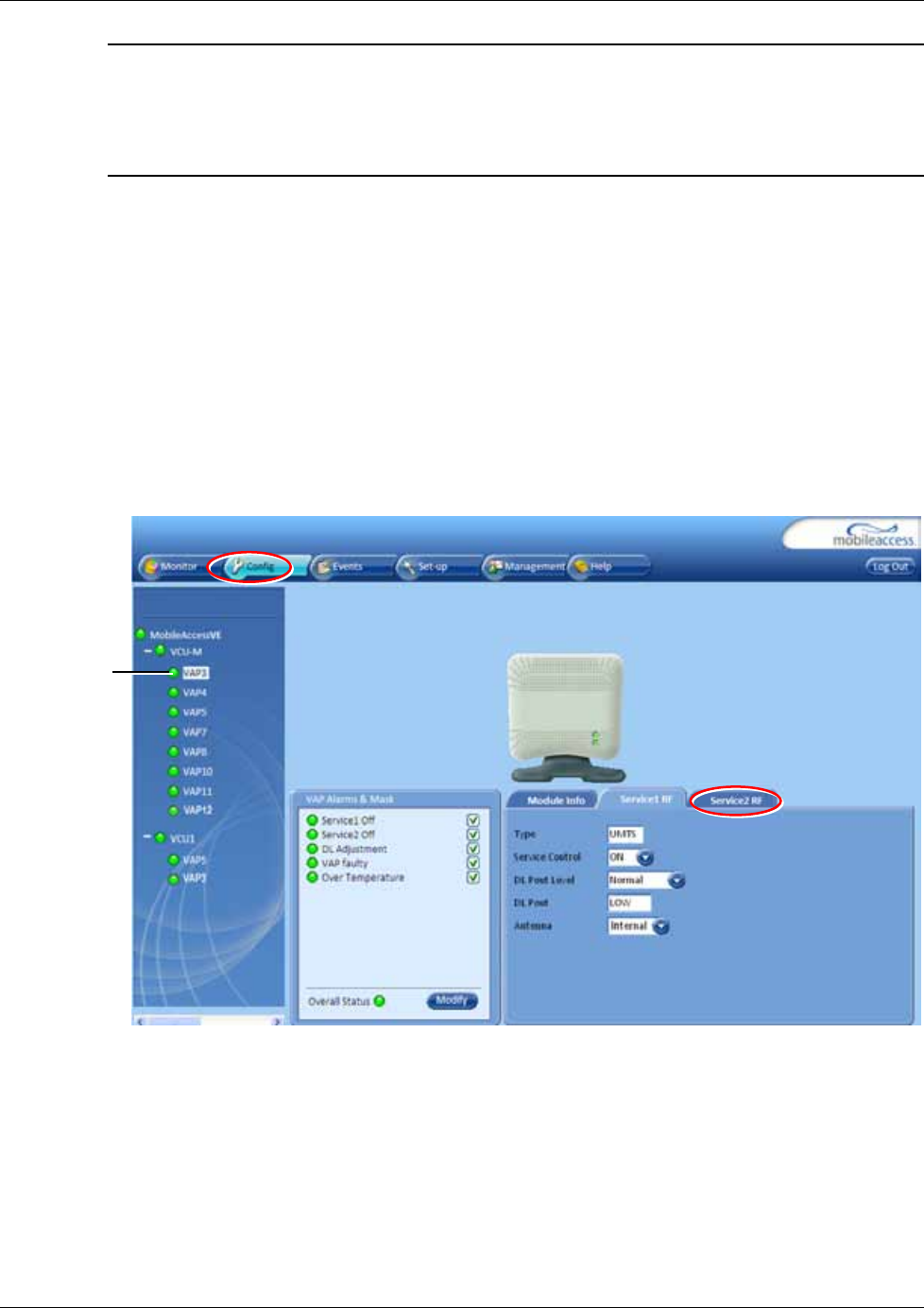
VAP Monitoring and Configuration
Dual-Band MobileAccessVE Instant Coverage Solution User Manual 62
Note: DL adjustment alarm is raised when a VAP is connected over a cable exceeding system
cable length limitation. In such cases, the system continues to provide the wireless services, but
you should check the coverage of the VAP (as output power may be degraded due to excess
cable loss) and check the Ethernet connection (as Ethernet standard maximum cable length has
probably been exceeded).
8.3 VAP RF Parameters
The Service1 and Service2 tabs provide the configurable RF parameters corresponding to the
VAP element selected in the network topology tree. Up to two service RF tabs are displayed, one
for each service. The displayed RF parameters are similar for both service tabs.
To View the VAP RF Parameters
Click the Config tab from the main menu bar and then select the VAP from the network
topology and click the
Service RF
tab. The parameters displayed in Service RF tabs correspond to
the selected element.
Selected VAP

VAP Monitoring and Configuration
Dual-Band MobileAccessVE Instant Coverage Solution User Manual 63
The following table provides a description of the RF parameters displayed in the Service RF tabs.
Parameter Description
Type Set according to unit type (e.g. EGSM /UMTS)
Service Control Used to Disable (Off) or Enable (On) the service for the specific VAP
DL Pout Level Normal – Pout from the VAP at normal level (according to the service)
Low – Pout from VAP is attenuated by 5 dB
DL Pout
Presents the measured output power
Antenna Select External only if an external antenna is connected to this VAP.
Otherwise, the option should be set to Internal (default)
Note: VAP RF settings (Service Control, DL Pout Level, Antenna) are saved in the VCU associated
to the port to which the VAP is connected, such that in case you replace a VAP all parameters
are automatically set to the new VAP. In case you do not want to keep the configuration of the
replaced VAP, remove it from the topology baseline before connecting the new VAP.
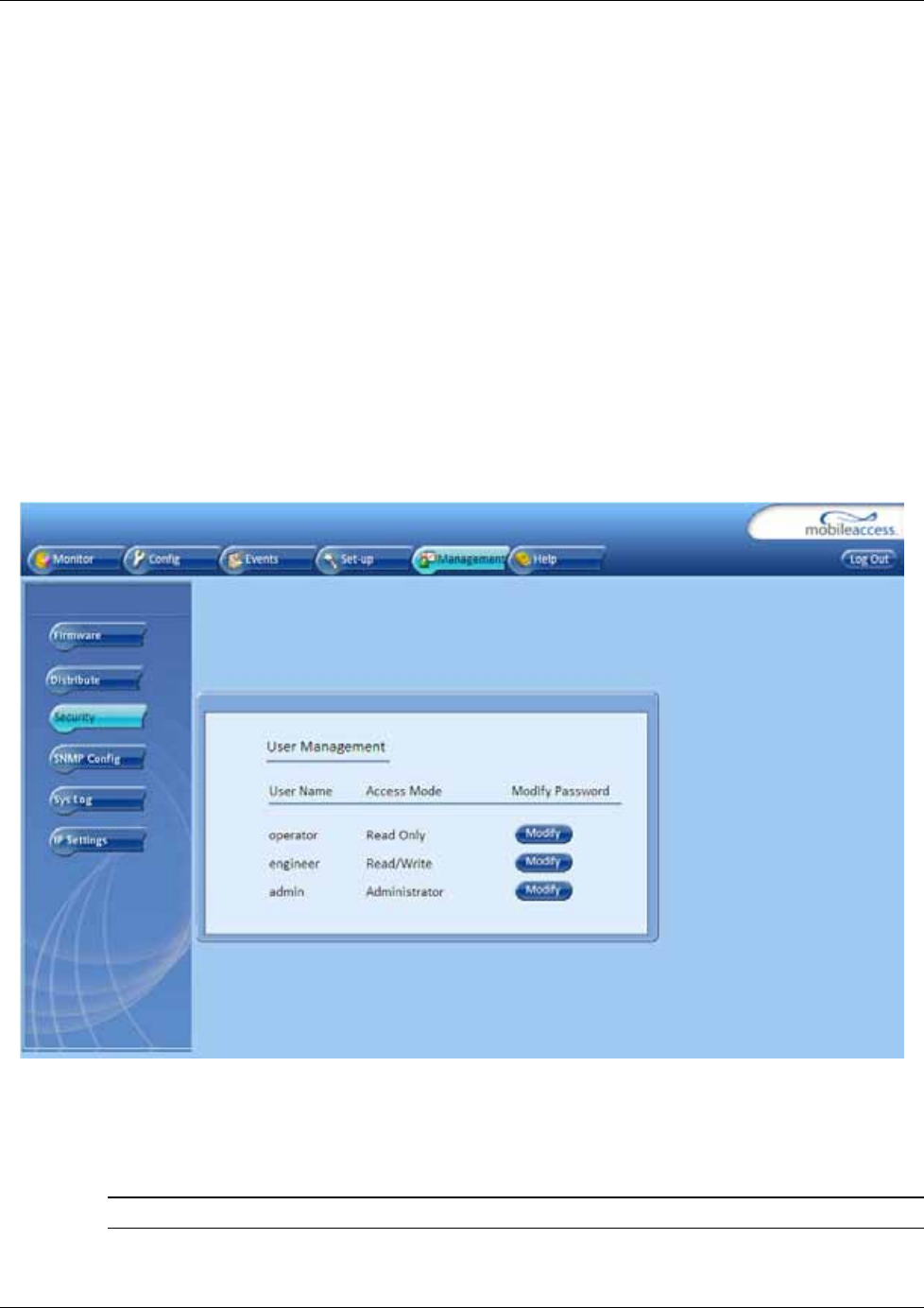
Administrative Operations
Dual-Band MobileAccessVE Instant Coverage Solution User Manual 64
9 Administrative Operations
This chapter describes the following Administrative operations:
· Changing a password
· IP configuration parameters
· SNMP Configuration parameters
· Unit software upgrade and software management procedures
9.1 Changing Password
The Management - Security tab provides password change options.
To Set the Application Password or Change an Existing Password
1. Select the Security option of the Management tab at the top of the window.
2. Click the Modify button beside the User Name whose password is being modified.
3. Enter the New Password and re-enter in the Confirm New Password field.
4. Click OK.
Note: Passwords can only be changed when connected as an administrator.
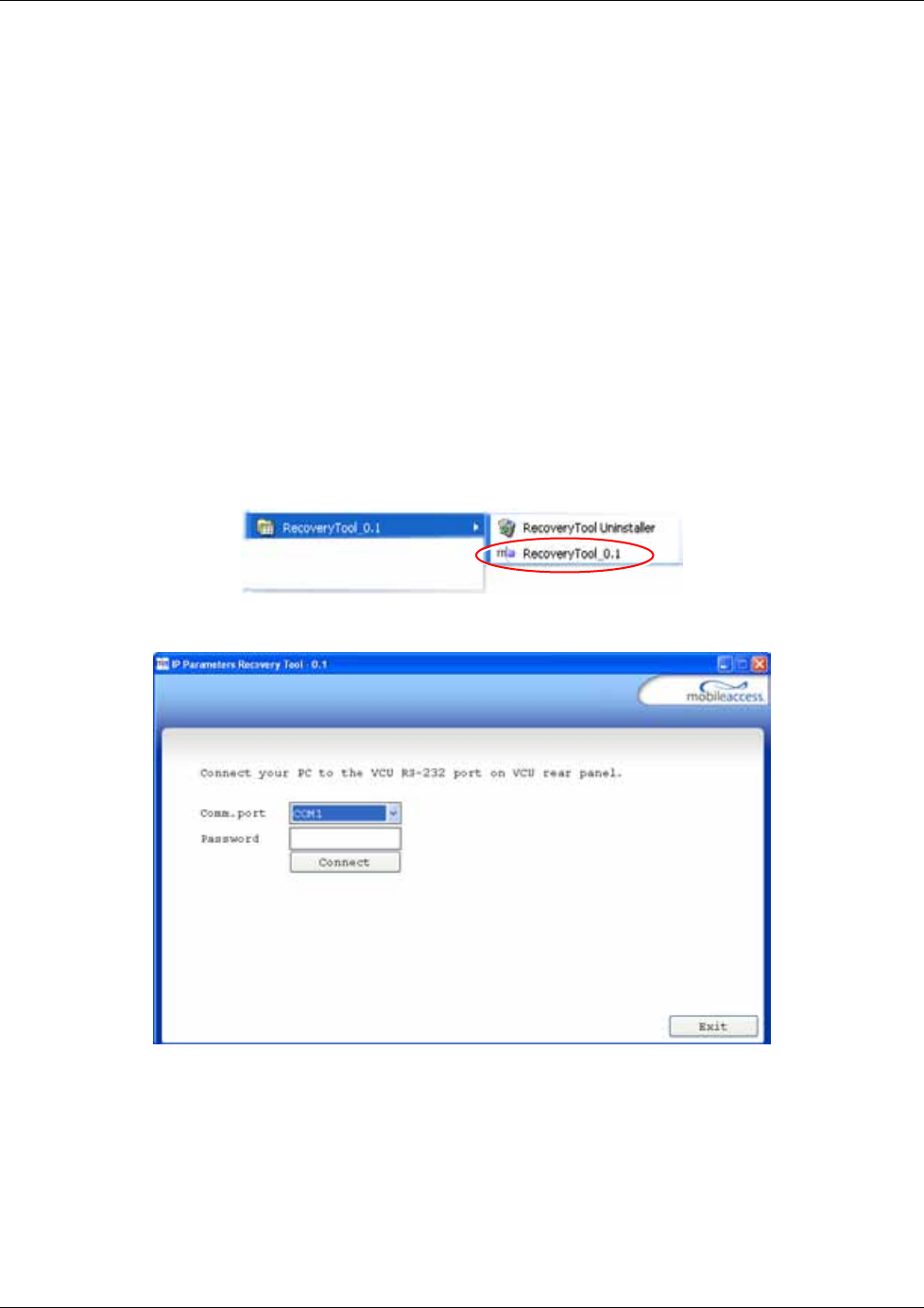
Administrative Operations
Dual-Band MobileAccessVE Instant Coverage Solution User Manual 65
9.2 Retrieving VCU IP Address
The IP Recovery Tool enables viewing and/or changing the VCU IP address.
To Install IP Recovery Tool
1. Install the IP Recovery Tool application, which is provided by MobileAccess on the Setup CD,
on the computer to which the VCU is to be connected.
2. Double-click on the Recovery Tool Setup and follow the prompts – standard installation
procedure.
To Retrieve the VCU IP Address
1. Connect the computer, on which the Recovery Tool is installed, to the VCU RS-232 Console
port located on the rear panel (See section 1.3.1.2).
2. Run the IP Recovery Tool application from the computer Start menu.
The Connection dialog appears.
3. Select the Comm. Port corresponding to the connection on the computer.
4. Enter the password Eng and click Connect.
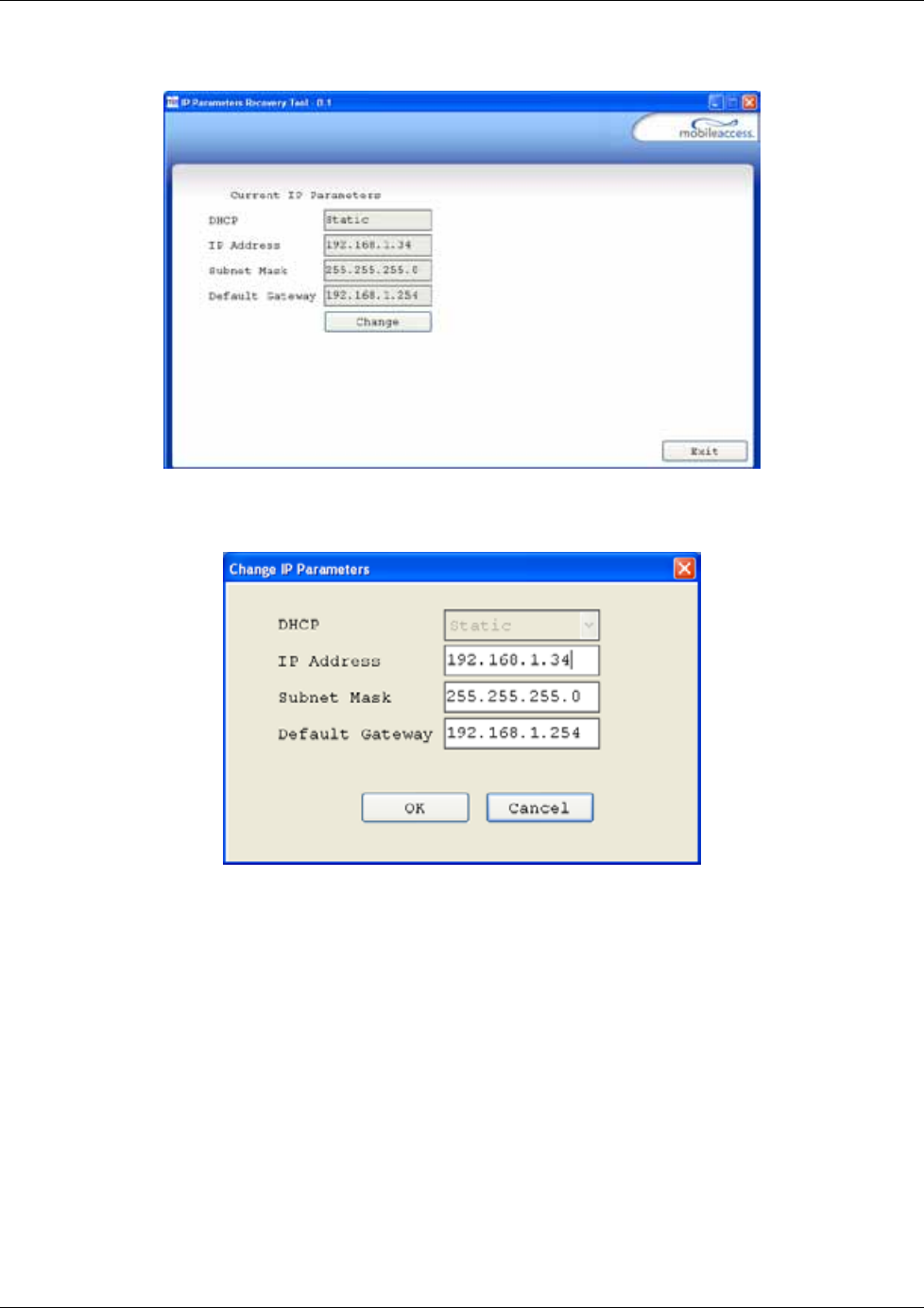
Administrative Operations
Dual-Band MobileAccessVE Instant Coverage Solution User Manual 66
The current IP parameters dialog appears showing the VCI IP address.
5. To modify the current IP Parameters: click Change. The Change IP Parameters dialog
appears:
Enter the new parameter value and click OK and Exit.
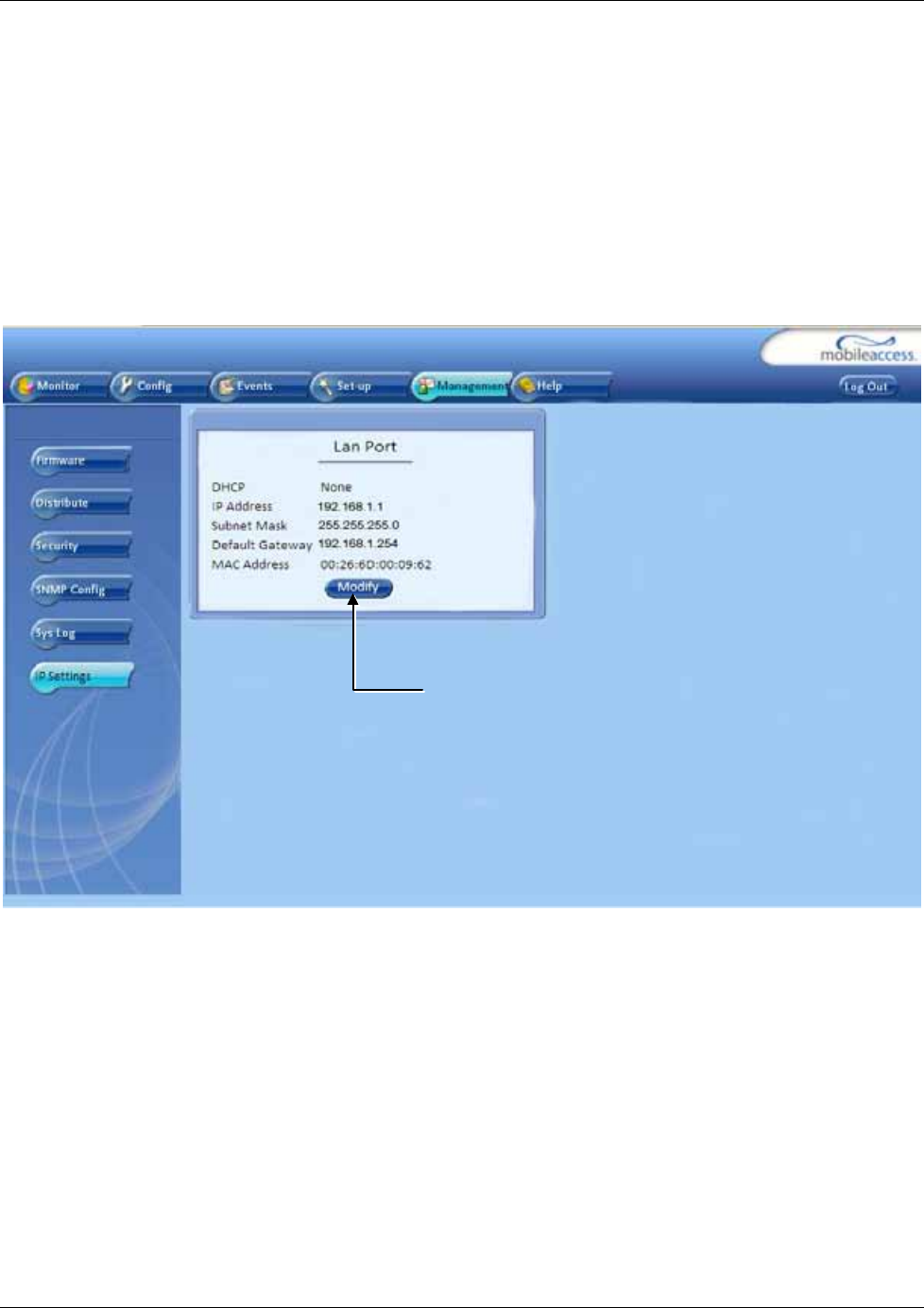
Administrative Operations
Dual-Band MobileAccessVE Instant Coverage Solution User Manual 67
9.3 IP Settings
The IP Settings tab is used for viewing and modifying the network parameters. The default
parameter settings are as follows:
· IP Address: 192.168.1.1
· Subnet Mask: 255.255.255.0
· Default Gateway: 192.168.1.254
Click Modify button
to change settings
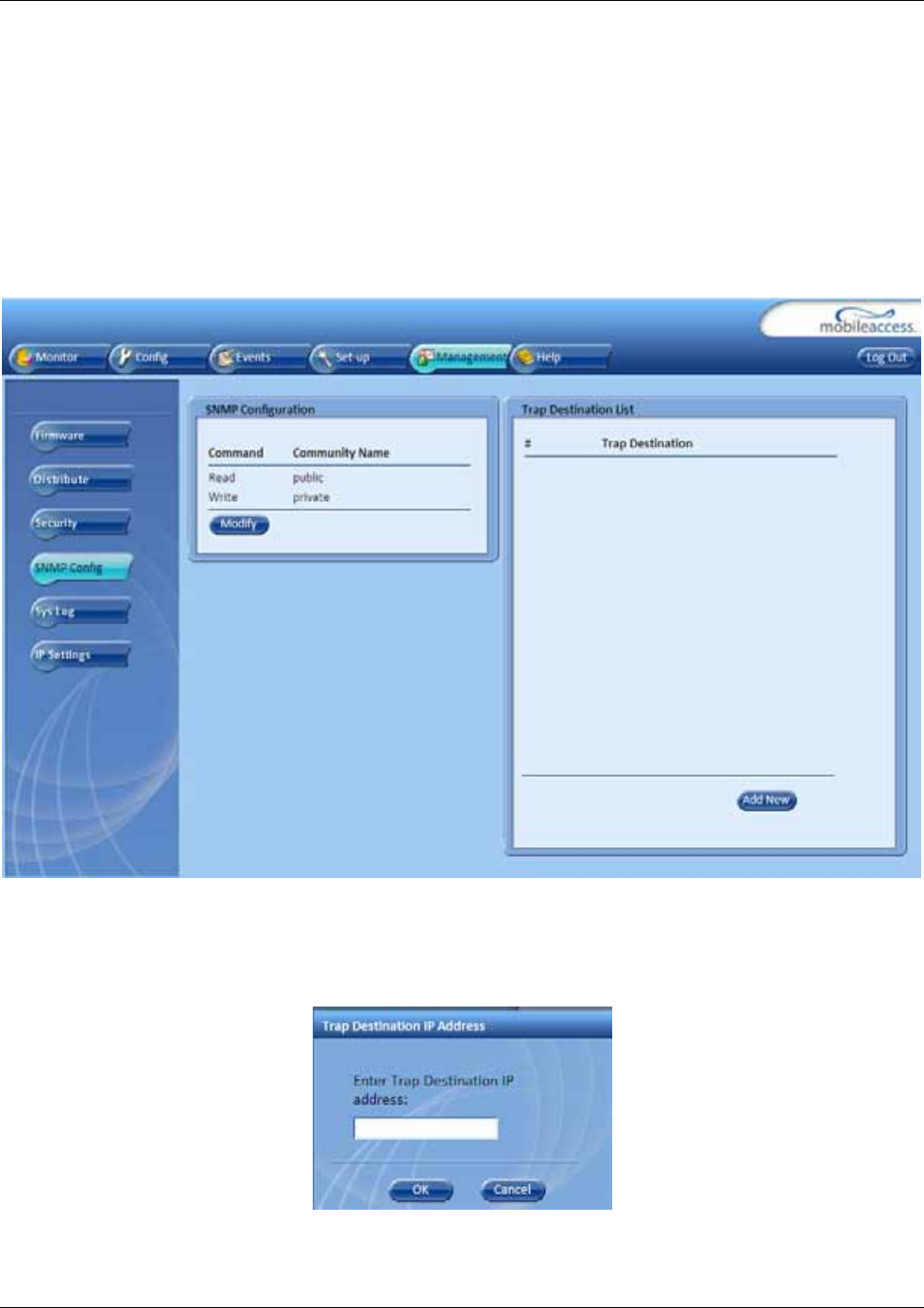
Administrative Operations
Dual-Band MobileAccessVE Instant Coverage Solution User Manual 68
9.4 SNMP Configuration Parameters
The SNMP Config tab is used for defining the SNMP communities in which the devices and
management station belongs and to where the traps are sent. The SNMP default communities
are:
· Read - public
· Write - private
· The Community Names can be modified by clicking the Modify button in the SNMP
Configuration display area.
· Additional Trap Destinations can be added by clicking the Add New button in the Trap
Destination List display area:

Administrative Operations
Dual-Band MobileAccessVE Instant Coverage Solution User Manual 69
9.5 Upgrading (or Downgrading) VCU and VAP Software
Note: Before you start, verify that the VCU and VAPs upgrade files are located in an accessible
location (i.e. on your computer).
The software for each VCU and its hosted VAPs can be upgraded through access to the VCU,
where the VAPs must be upgraded first and only then the VCU.
Note: In installations with Slave VCUs, a session should be opened to the IP address of the Slave
VCU in order to upgrade the SW of the Slave VCU and associated VAPs.
Two types of files are stored on the VCU and on individual VAPs: Active software on which the
unit operates, and Standby software. The Active and Standby software can be swapped on each
individual unit.
In addition, the VCU holds two software images for VAPs to be used in download process to
VAPs.
The upgrade procedure consists of the following main phases:
1. Uploading the new VCU and VAP software to the host VCU.
2. Setting the new software as the Active software.
3. Downloading the new software to selected VAPs and activating it as the Active software on
those VAPs.
4. Activating the new VCU software on the VCU.
The procedure is performed via two screens:
· Distribute Screen – Used to download the VAP software version to selected VAPs.
· Firmware Screen – Used to manage the software files stored on the VCU.
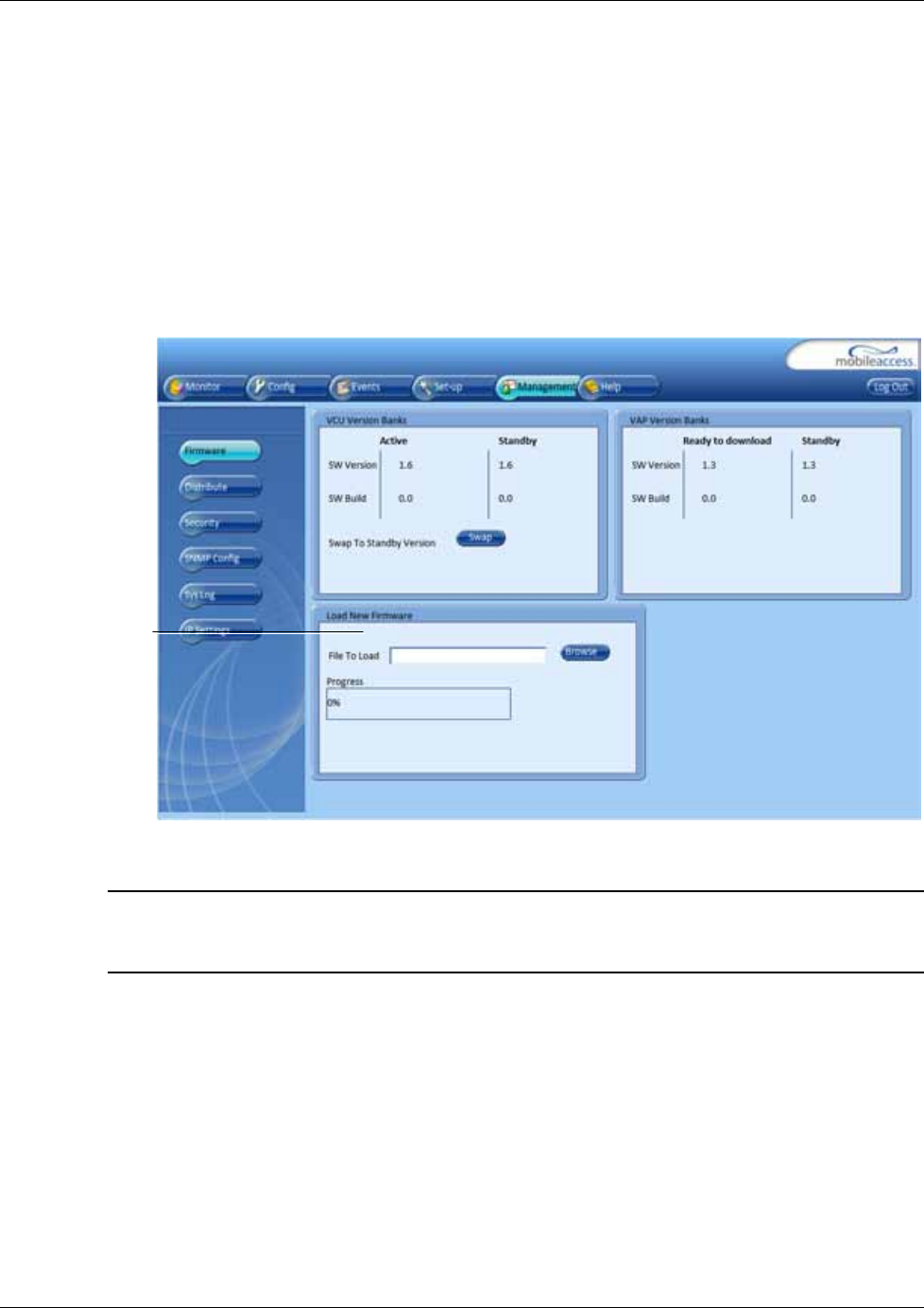
Administrative Operations
Dual-Band MobileAccessVE Instant Coverage Solution User Manual 70
9.5.1 Upgrading the VAP SW
To Upgrade the VAPs SW Version:
1. Upload the VAP upgrade files from your storage location to the VCU as follows:
· Click the Management menu tab and then select the Firmware sub-menu option
located on the left side.
· In the Load New Firmware display area, click the Browse button.
· Browse for the file to be loaded from your computer location. The Download button
appears and the progress bar will show the download status.
· After the download is complete, the downloaded SW version will appear in the Standby
Bank column of the VAP display area.
Notes:
1. Locate the Firmware files on your local hard-drive prior to the download process.
2. During the download process DO NOT disconnect the Web GUI connection to the VCU.
2. To distribute the new software to selected VAPs:
· Select the Distribute sub-menu option found on the left side.
Load New
Firmware
Display Area
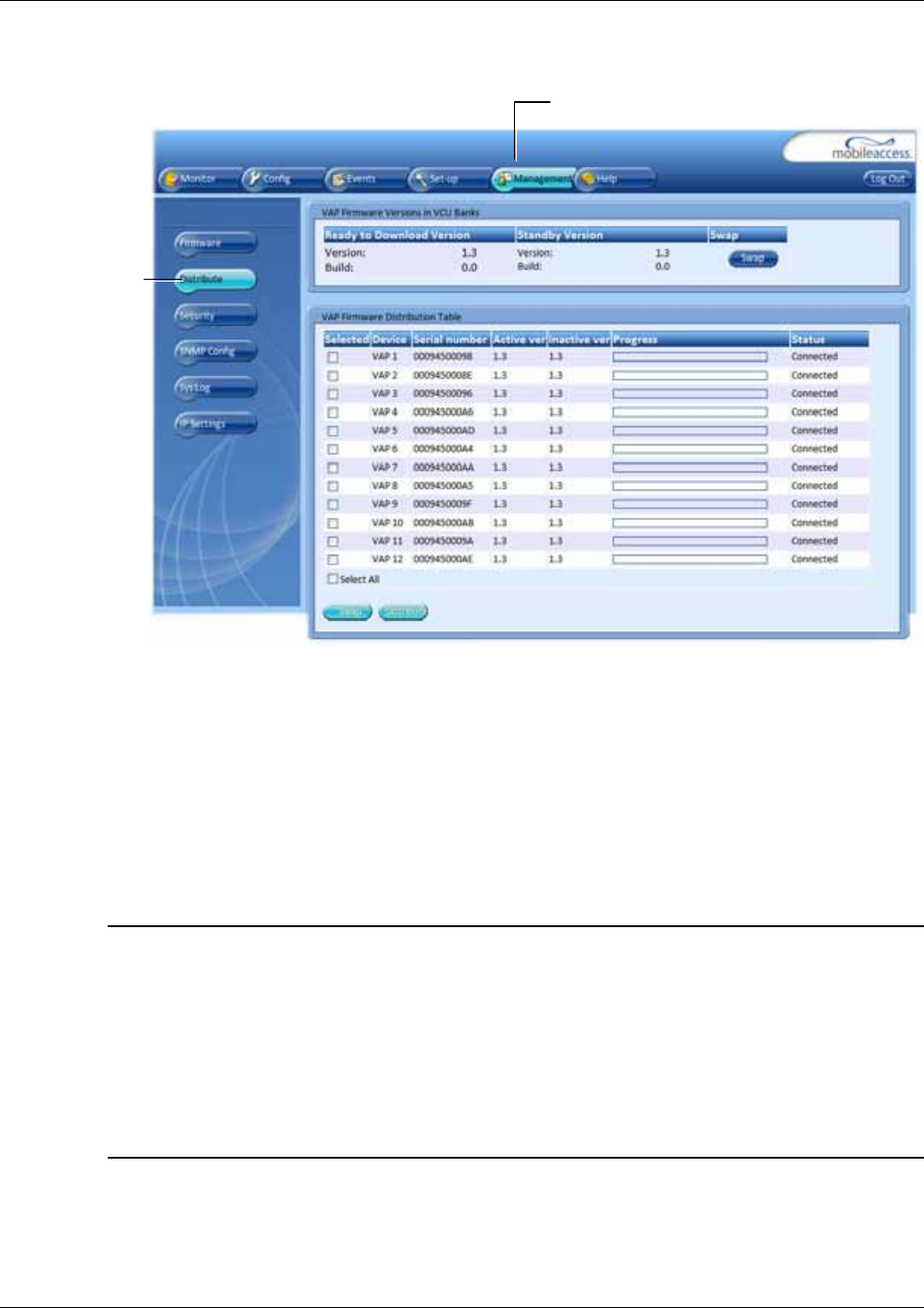
Administrative Operations
Dual-Band MobileAccessVE Instant Coverage Solution User Manual 71
3. Download the new version to the selected VAPs
(Note: The downloaded version is stored as
Inactive in the VAPs until a Swap procedure is performed.)
· In the VAP Distribute Table display area, checkmark the VAPs to be upgraded. The
Active and Inactive SW versions for each VAP are listed in the relevant columns.
· Click the Distribute button to download the new software to the selected VAPs. The
software is stored as the Inactive version in the VAPs.
· Set the new software as the Active version in the selected VAPs by clicking the Swap
button.
· The VAP upgrade procedure is complete.
Notes:
1. As during the distribution process service may be interrupted, it is advised to perform the SW
download and distribution in a maintenance window scheduled at off-peak hours (e.g. nights
and/or weekends).
2. During the distribution process DO NOT perform configuration changes, connect or disconnect
VAPs, and/or disconnect the web GUI.
3. After the distribution process is complete and swapping between VAP SW images, the VCU will
restart automatically. After restart, the VAP firmware distribution table will be empty. Within
several seconds it will re-populate as the VCU re-discovers connected VAPs.
Management
Tab
Distribute
Sub-tab
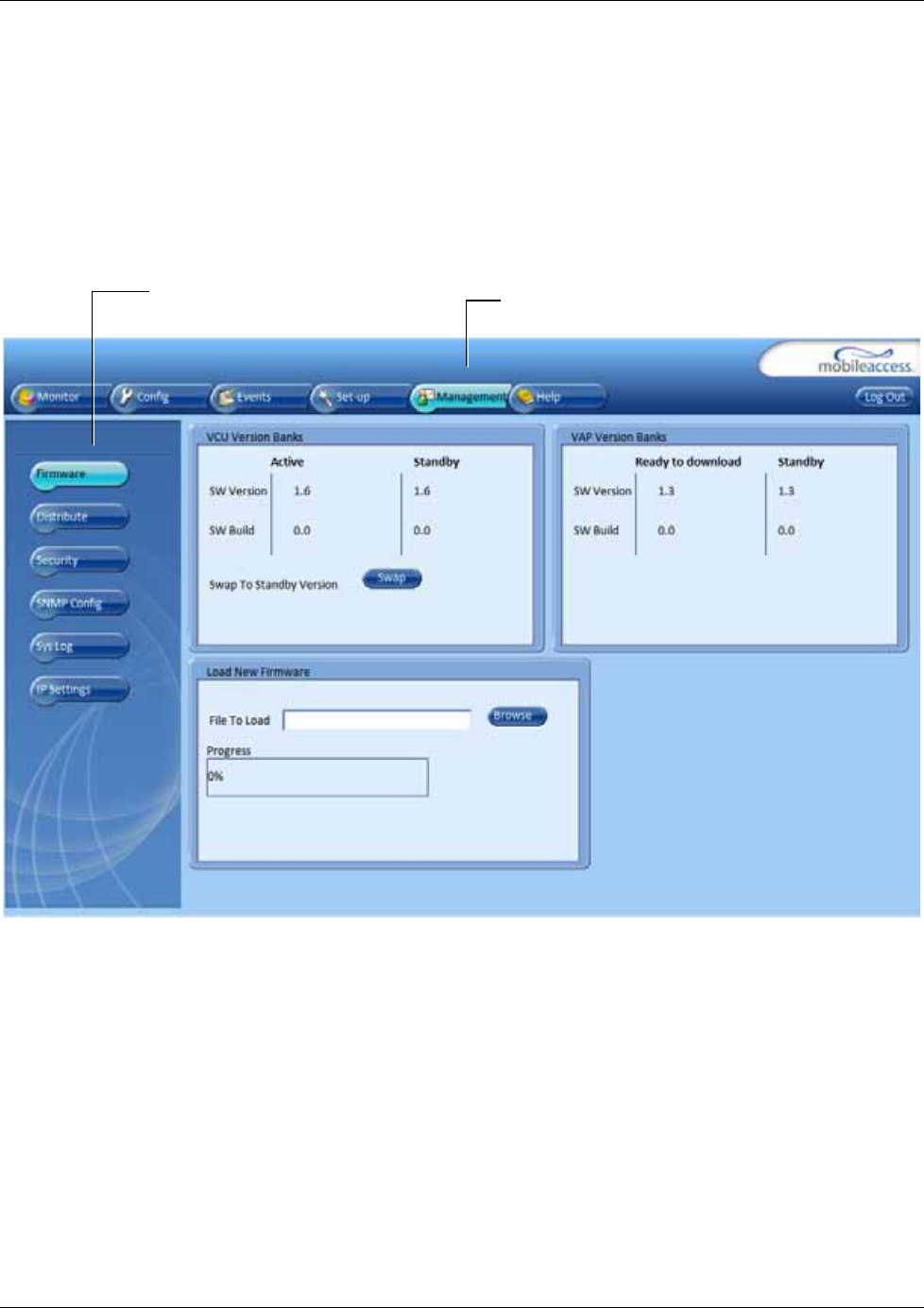
Administrative Operations
Dual-Band MobileAccessVE Instant Coverage Solution User Manual 72
9.5.2 Upgrading the VCU SW
To Upgrade the VCU SW Version:
1. Upload the VCU upgrade files from your storage location to the VCU as follows:
· Click the Management menu tab and then select the Firmware sub-menu option
found on the left side.
· In the Load New Firmware display area, click the Browse button.
· Select the file to be loaded from your computer location. The Download button appears
and the progress bar will show the download status.
· After the download is complete the downloaded SW version will appear in the Standby
Bank column of the VCU display area.
2. Define the downloaded version as the Active version (to be used for upgrade) as follows:
· In the VCU display area, click Swap. The downloaded version appears in the Active
Bank column and the Controller is automatically restarted.
· The VCU Upgrade procedure is complete.
Management Tab
Firmware Sub-tab
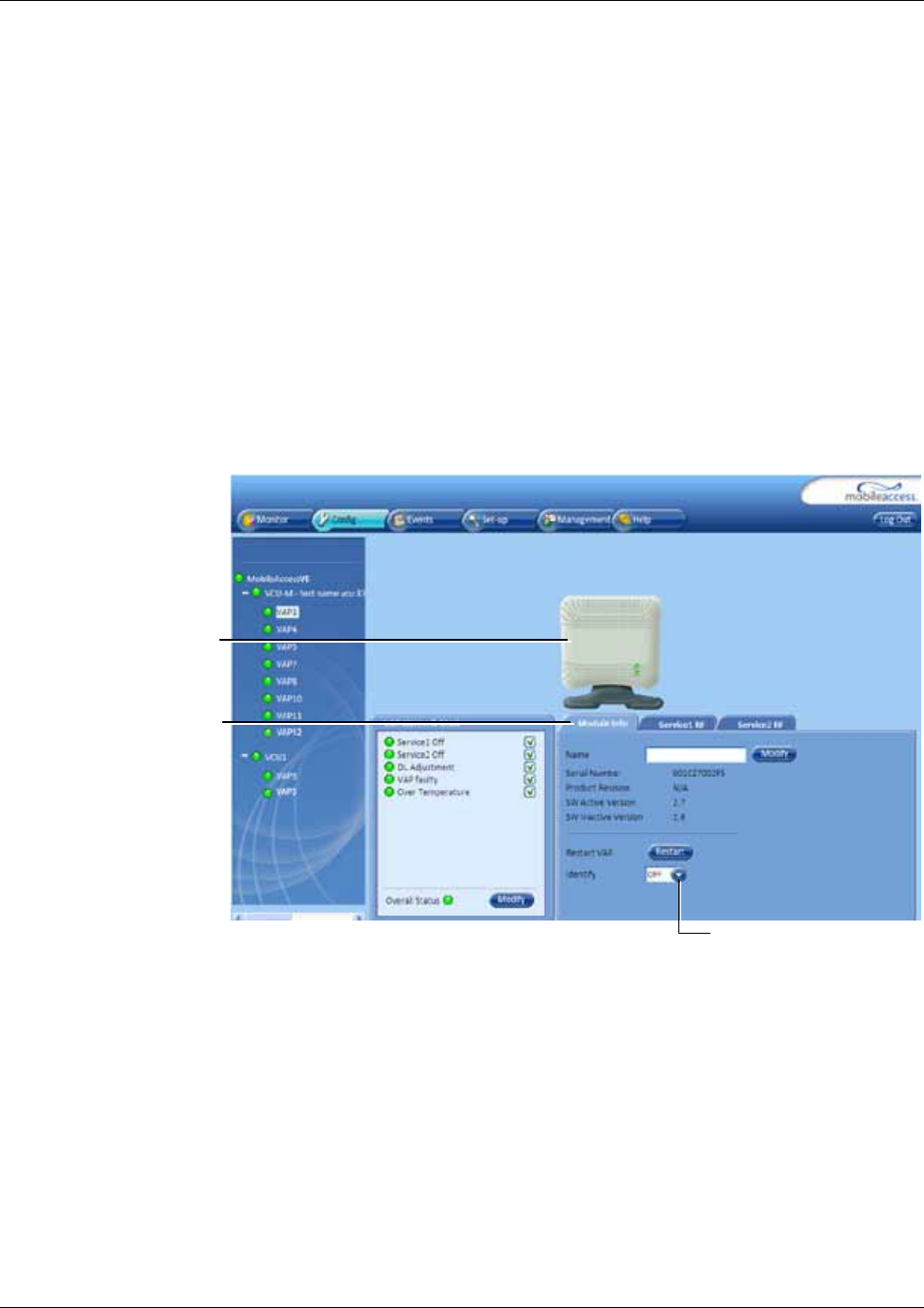
Troubleshooting
Dual-Band MobileAccessVE Instant Coverage Solution User Manual 73
10 Troubleshooting
10.1 Finding a Specific VAP in the Building
It is recommended to assign each VAP an identifiable name corresponding to its physical
location, as explained in section 5.4. If a name was not configured, or for some other reason a
specific VAP cannot be physically located, identify the VAP according to the instructions in the
following example.
To Locate a VAP
1. Select the Config tab from the main menu bar and then select the VAP to be located from
the topology tree.
2. Click the Module Info sub-tab.
Selected VAP
Identify On/Off
Module Info

Troubleshooting
Dual-Band MobileAccessVE Instant Coverage Solution User Manual 74
3. Set Identify to ON. The Activity LED (Blue) on the corresponding Access Pod will start
blinking fast. (You will need to physically locate the VAP to see the blinking LED).
4. Locate the Access Pod.
5. It is advisable to assign it an identifiable name via the Access Pod Module Info tab, as
described in section 5.4 (e.g. floor 3, room 2) and set the Identify field to Off again.
Blue LED (Activity)
Green LED (PWR)
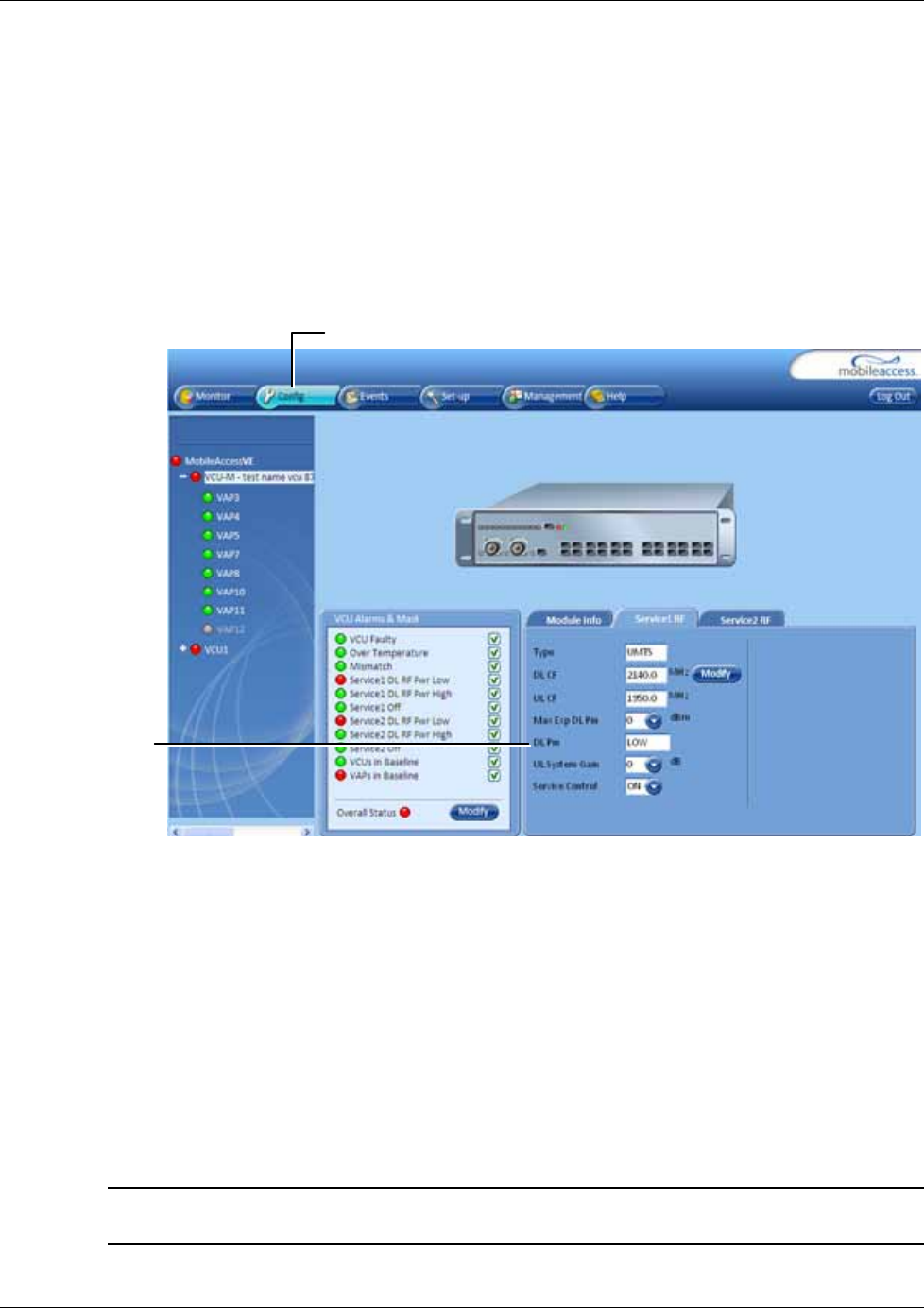
Troubleshooting
Dual-Band MobileAccessVE Instant Coverage Solution User Manual 75
10.2 Wireless Service is Not Available
1. Verify that the Master VCU is connected to the BTS, powered up, and configured.
2. Verify that the Max Expected Power setting is correct by either:
· Viewing the actual VCU Power Measurement (DL Pin) in the VCU Service RF tab (See
below).
· Measuring the actual BTS output using a Spectrum Analyzer.
3. Verify correct settings of Frequencies and UL Gain (See DL/UL CF and UL System Gain
parameters in Service RF sub-tab displayed above).
4. Verify that the RF cables are properly connected to the VCU.
5. View the VCU Alarms (above image) and verify that the VCU is working properly.
10.3 PoE is Not Working
Verify that the PoE used is “alternative a”. The MobileAccessVE system currently only supports
this alternative. Verify that all pairs are wired in the patch panels and jumper cords.
Note: Future enhancements will support “alternative b”. Consult MobileAccess if you currently
require support for “alternative b.”
Config Tab
DL Pin
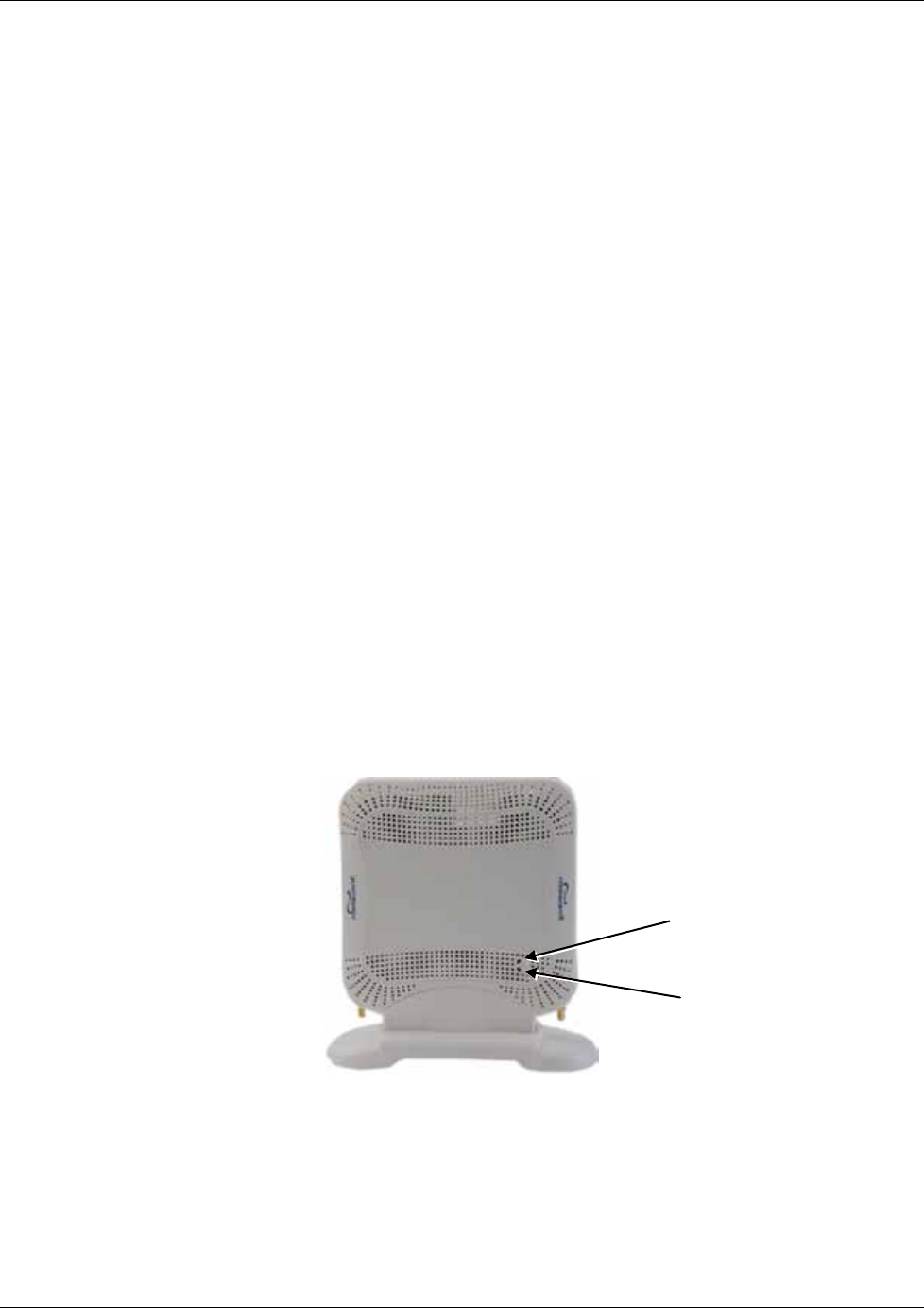
Troubleshooting
Dual-Band MobileAccessVE Instant Coverage Solution User Manual 76
10.4 Ethernet Service is Degraded
Ethernet standards specify that 100m (300ft) is the maximum distance between an Ethernet
switch and appliance (computer, WLAN AP, etc). This is relevant when MobileAccessVE shares
the IT LAN. The distance includes all patch cords (from switch to VCU, from VCU to patch panel,
from RJ-45 outlet to VAP, and from VAP to appliance).
1. Review the IT documentation, which may be available from your IT department, to
determine cable types and lengths.
2. Check the lengths of the patch cords being used and verify the end-to-end distance does not
exceed 100m (300ft).
3. A Fluke cable tester can be used to measure cable length.
10.5 No Service from Connected Access Pod
This requires physically accessing the Access Pod to check the LEDs, and accessing the Access
Pod through the Web GUI to verify the Access Pod configuration.
1. Physically view the Access Pod and confirm that both LEDs on the Access Pod are lit:
· Power LED (Green) is OFF – Either no connectivity to the VCU or the VAP is faulty. Try
replacing the VAP. Try connecting the VAP directly to the VCU if the Power LED is lit
check the cable and the patch cords.
· Activity LED is constantly blinking – The Access Pod cannot initialize due to exceeded
cable length. Try using the closest free RJ-45 jack fed with a different cable.
2. Check other Access Pods connected to the same VCU.
3. Verify that the VAP configuration as follows:
· Connect to the VCU using the MobileAccessVE Web GUI application (See section 6.1)
and select the VAP from the topology tree.
Blue LED (Activity)
Green LED (PWR)
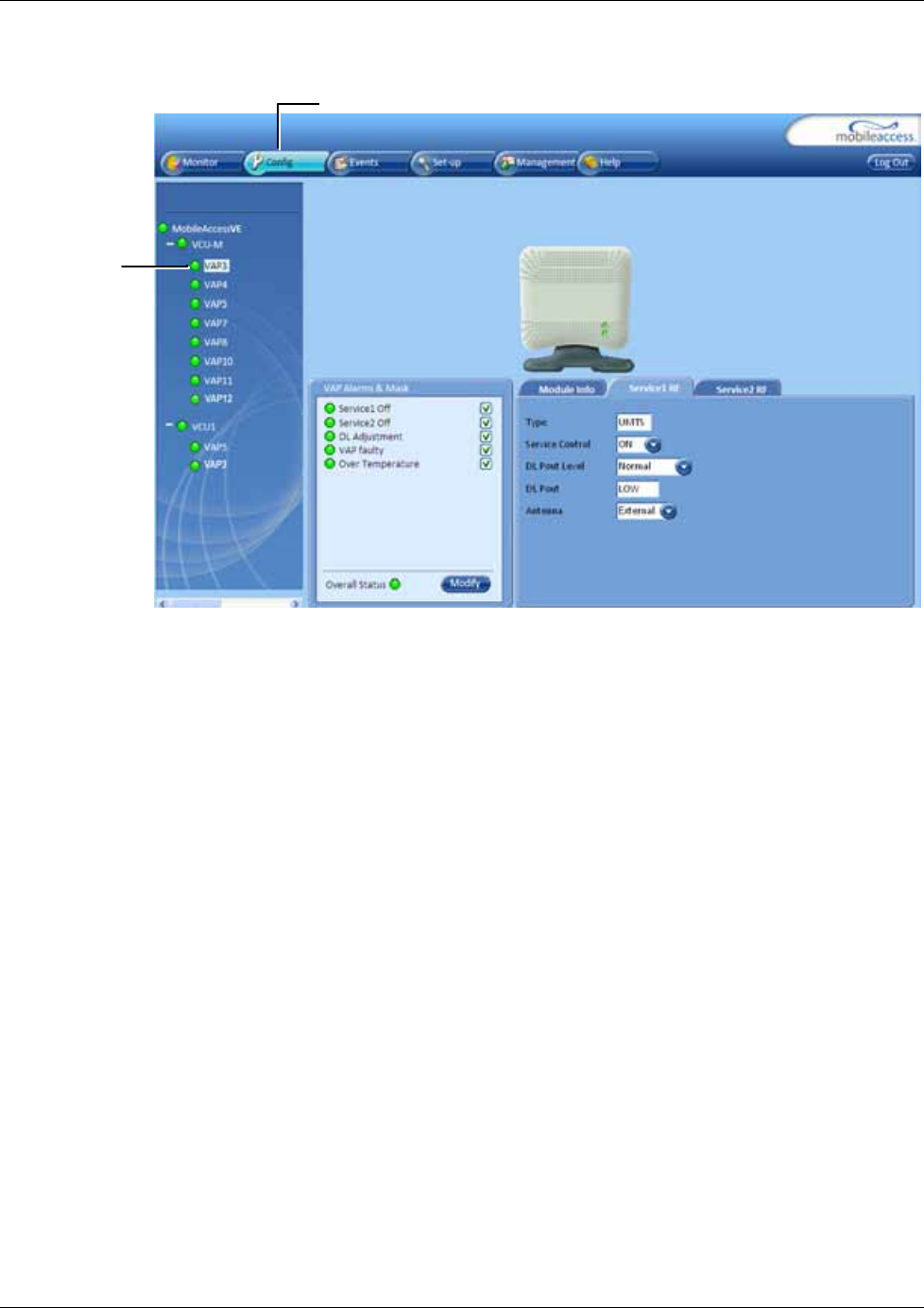
Troubleshooting
Dual-Band MobileAccessVE Instant Coverage Solution User Manual 77
· In the Config tab, click on the relevant Service RF sub-tab and verify that the Service
Control parameter is set to On.
· Confirm that the VCU port is functioning (VAP status LED associated with this Pod is
green).
· In case external antennas are connected – verify the VAP was configured to use the
external antennas (See Antenna parameter in VAP Service RF sub-tab, shown above).
Selected VAP
Config Tab
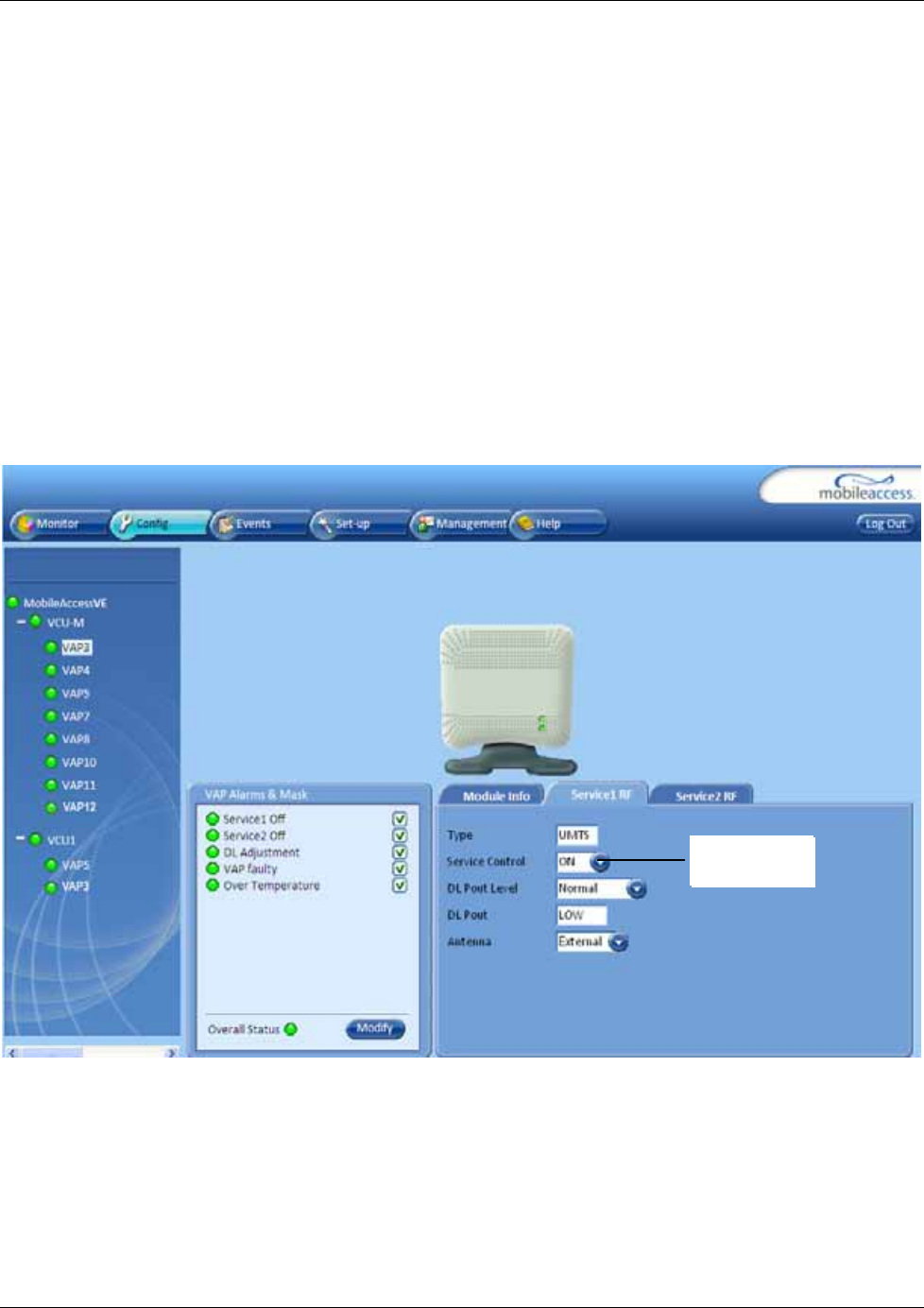
Troubleshooting
Dual-Band MobileAccessVE Instant Coverage Solution User Manual 78
10.6 VCU Cannot be Monitored via SNMP
VE traps are not received by the external Fault Monitoring system.
1. Verify that the VCU is powered ON.
2. Verify that the SNMP traps destination address is configured correctly.
3. Verify the IP connectivity to the Fault Monitoring server using “ping.”
4. Verify that SNMP port is not blocked or fire-walled in the IP network.
5. Initiate an Alarm and confirm the trap is received by external Fault Monitoring server. For
example:
· Access the VAP Service RF sub-tab (See section 8.3).
· Verify that the alarm is unmasked.
· Set the Service Control parameter to Off.
· Confirm the trap is received by external Fault Monitoring server.
Service
Control

Dual-Band MobileAccessVE Instant Coverage Solution User Manual 79
Appendix A - Traps
This section lists the MobileAccessVE Dual-Band Controller and Access Pod Traps.
VE Control Unit (VCU) Traps
Trap Name Trap Description
vcuChannel_1_DLPowerLow (Major) Alert for low RF in VCU for Service 1: 15dB less than
max expected power
vcuChannel_1_DLPowerHigh (Minor) Alert for High RF in VCU for Service 1: 3dB more than
max expected power
vcuChannel_1_ServiceOff (Major) User set Service 1 to off
vcuChannel_2_DLPowerLow (Major) Alert for low RF in VCU for Service 2: 15dB less than
max expected power
vcuChannel_2_DLPowerHigh (Minor) Alert for High RF in VCU for Service 2: 3dB more than
max expected power
vcuChannel_2_ServiceOff (Major) User set Service 2 to off
vcuFault (Major) HW failure in VCU
vcuOverTemperature (Minor) VCU temperature is too high
vcuMismatchType (Minor) When VCU services types is different than VAP services
types
vcuAdjustment (Major) When adjustment (for Slave VCU) has failed (cable too
long)
VE Access Pod (VAP) Traps
Trap Name Trap Description
vapAdjustment (Major) Cable is too long (over 100m/300ft)
vapChannel_1_ServiceOff (Minor) User set service 1 to Off
vapChannel_2_ServiceOff (Minor) User set service 2 to Off
vapFaulty (Major) The Access Pod is faulty
vapOverTemperature (Minor) VAP temperature is too high

Appendix B – MobileAccess VE Dual Band MIB Tree Structure (Version 1.8)
Dual-Band MobileAccessVE Instant Coverage Solution User Manual 80
Appendix B – MobileAccess VE Dual Band
MIB Tree Structure (Version 1.8)
The following MIB is used for managing the MobileAccess VE VCU and VAPs across the network
infrastructure. This MIB Structure and OIDs are specifically related to MIB Release 1.8 with the expectation
that New OIDs will be added with the release of future Firmware Versions.
MIB Tree Structure is on the following pages.
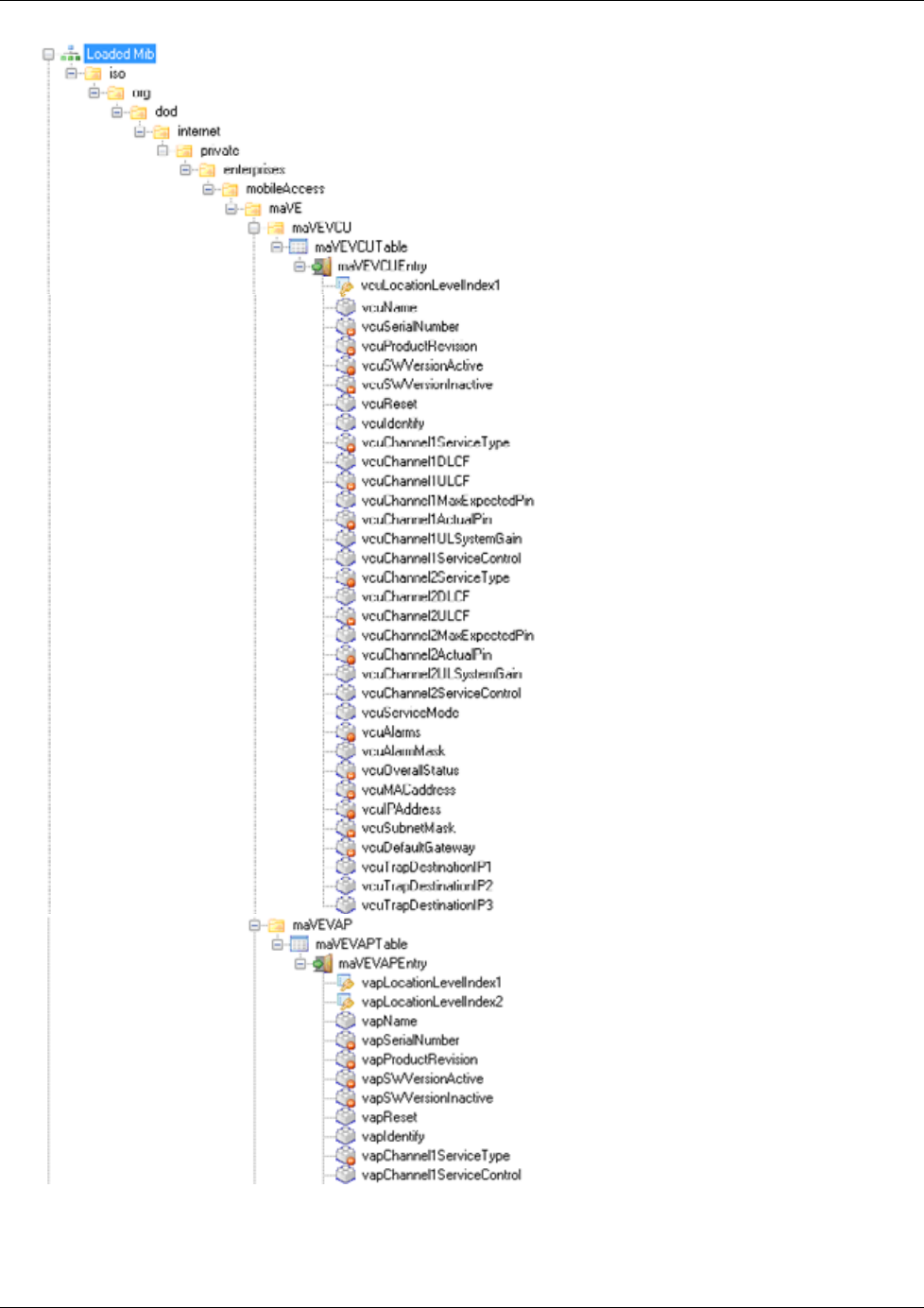
Appendix B – MobileAccess VE Dual Band MIB Tree Structure (Version 1.8)
Dual-Band MobileAccessVE Instant Coverage Solution User Manual 81
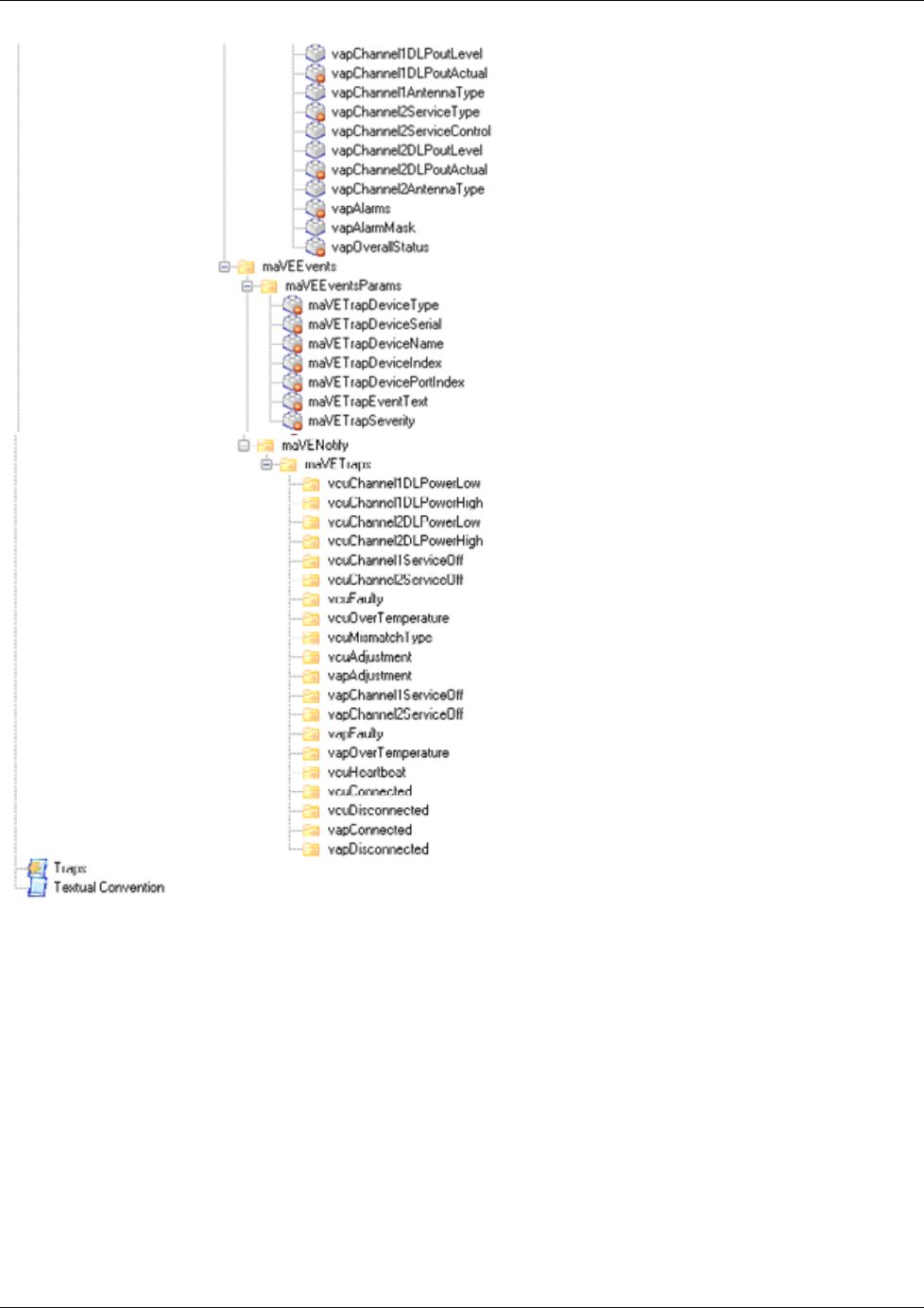
Appendix B – MobileAccess VE Dual Band MIB Tree Structure (Version 1.8)
Dual-Band MobileAccessVE Instant Coverage Solution User Manual 82

Appendix B – MobileAccess VE Dual Band MIB Tree Structure (Version 1.8)
Dual-Band MobileAccessVE Instant Coverage Solution User Manual 83
MobileAccess Version 1.8 MIBs/OID Descriptions
Module Node Name OID String Description
MaVE-
MIB enterprises .1.3.6.1.4.1 Enterprise
MaVE-
MIB mobileAccess .1.3.6.1.4.1.15921 MobileAccess
MaVE-
MIB maVE .1.3.6.1.4.1.15921.11 MobileAccess VE
MaVE-
MIB maVEVCU .1.3.6.1.4.1.15921.11.1 MobileAccess VE VCU
MaVE-
MIB maVEVCUTable .1.3.6.1.4.1.15921.11.1.1 VCU Table
MaVE-
MIB maVEVCUEntry .1.3.6.1.4.1.15921.11.1.1.1 VCU Table Entries
MaVE-
MIB vcuLocationLevelIndex1 .1.3.6.1.4.1.15921.11.1.1.1.1 1 for Master VCU and 2 to 13 are the Slave
VCUs
MaVE-
MIB vcuName .1.3.6.1.4.1.15921.11.1.1.1.2 MA VCU NAME
MaVE-
MIB vcuSerialNumber .1.3.6.1.4.1.15921.11.1.1.1.3 MA VCU Serial Number
MaVE-
MIB vcuProductRevision .1.3.6.1.4.1.15921.11.1.1.1.4 MA VCU Product revision
MaVE-
MIB vcuSWVersionActive .1.3.6.1.4.1.15921.11.1.1.1.5 MA VCU Active Software Version
MaVE-
MIB vcuSWVersionInactive .1.3.6.1.4.1.15921.11.1.1.1.6 MA VCU Inactive Software Version
MaVE-
MIB vcuReset .1.3.6.1.4.1.15921.11.1.1.1.7 MA VCU RESET
MaVE-
MIB vcuIdentify .1.3.6.1.4.1.15921.11.1.1.1.8 MA VCU Indetify
MaVE-
MIB vcuChannel1ServiceType .1.3.6.1.4.1.15921.11.1.1.1.9 MA VCU Service Type
MaVE-
MIB vcuChannel1DLCF .1.3.6.1.4.1.15921.11.1.1.1.10 MA VCU First channel DL CF in 100Khz
MaVE-
MIB vcuChannel1ULCF .1.3.6.1.4.1.15921.11.1.1.1.11 MA VCU First channel UL CF in 100Khz
MaVE-
MIB vcuChannel1MaxExpectedPin .1.3.6.1.4.1.15921.11.1.1.1.12
MA VCU First channel Max Expected Input
Power - in dBm ;when
vcuChannel1ServiceType >50(In
WiMAX/PHS)the value is (dBm value + 100))

Appendix B – MobileAccess VE Dual Band MIB Tree Structure (Version 1.8)
Dual-Band MobileAccessVE Instant Coverage Solution User Manual 84
Module Node Name OID String Description
MaVE-
MIB vcuChannel1ActualPin .1.3.6.1.4.1.15921.11.1.1.1.13
MA VCU First channel Actual Input Power In
- in 0.1 dBm means: (when
vcuChannel1ServiceType <50 the value is
(dBm value *10) ; when
vcuChannel1ServiceType >50(In
WiMAX/PHS) the value is (dBm value +
100)*10
MaVE-
MIB vcuChannel1ULSystemGain .1.3.6.1.4.1.15921.11.1.1.1.14 MA VCU First channel UL System Gain
MaVE-
MIB vcuChannel1ServiceControl .1.3.6.1.4.1.15921.11.1.1.1.15 MA VCU First channel Service control (N/A in
MIMO/SISO services)
MaVE-
MIB vcuChannel2ServiceType .1.3.6.1.4.1.15921.11.1.1.1.16 MA VCU Service Type
MaVE-
MIB vcuChannel2DLCF .1.3.6.1.4.1.15921.11.1.1.1.17 MA VCU Second channel DL CF in 100Khz (in
MIMO refer to relevant leaf at channel 1)
MaVE-
MIB vcuChannel2ULCF .1.3.6.1.4.1.15921.11.1.1.1.18 MA VCU Second channel UL CF in 100Khz (in
MIMO refer to relevant leaf at channel 1)
MaVE-
MIB vcuChannel2MaxExpectedPin .1.3.6.1.4.1.15921.11.1.1.1.19 MA VCU Second channel Max Expected
Input Power - in dBm (in MIMO refer to
relevant leaf at channel 1)
MaVE-
MIB vcuChannel2ActualPin .1.3.6.1.4.1.15921.11.1.1.1.20
MA VCU Second channel Actual Input Power
- in 0.1 dBm means: (when
vcuChannel2ServiceType <50 the value is
(dBm value *10) ; when
vcuChannel2ServiceType >50 the value is
(dBm value + 100)*10
MaVE-
MIB vcuChannel2ULSystemGain .1.3.6.1.4.1.15921.11.1.1.1.21 MA VCU Second channel UL System Gain (in
MIMO refer to relevant leaf at channel 1)
MaVE-
MIB vcuChannel2ServiceControl .1.3.6.1.4.1.15921.11.1.1.1.22 MA VCU Second channel Service control
(N/A in MIMO/SISO services)
MaVE-
MIB vcuServiceMode .1.3.6.1.4.1.15921.11.1.1.1.23 MA VCU Service mode ; set is relevant for
values of MIMO/SISO/OFF
MaVE-
MIB vcuAlarms .1.3.6.1.4.1.15921.11.1.1.1.24
MA VCU Alarms; Bits are as follow:
vcuChannel1ServiceType <50: 1 - VCU
Faulty; 2 - Over Temperature; 4 - Type
Mismatch; 8 - Channel1 RF DL low; 16 -
Channel1 RF DL High; 32 - Channel1 RF Off;
64 - Channel2 RF DL low; 128 - Channel2 RF
DL High; 256 - Channel2 Off ;
vcuChannel1ServiceType >50: 1 - VCU
Faulty; 2 - Over Temperature; 4 - Type
Mismatch; 8 - service Off; 16 - Channel1 RF
DL low; 32 - Channel1 RF DL High; ; 64 -
Channel2 RF DL low; 128 - Channel2 RF DL
High; 256 - Channel2 Off

Appendix B – MobileAccess VE Dual Band MIB Tree Structure (Version 1.8)
Dual-Band MobileAccessVE Instant Coverage Solution User Manual 85
Module Node Name OID String Description
MaVE-
MIB vcuAlarmMask .1.3.6.1.4.1.15921.11.1.1.1.25 MA VCU Alarm Mask; Bits refer to alarms
bits described above
MaVE-
MIB vcuOverallStatus .1.3.6.1.4.1.15921.11.1.1.1.26 MA VCU Overall Status
MaVE-
MIB vcuMACaddress .1.3.6.1.4.1.15921.11.1.1.1.27 MA VCU MAC Address
MaVE-
MIB vcuIPAddress .1.3.6.1.4.1.15921.11.1.1.1.28 MA VCU IP Address
MaVE-
MIB vcuSubnetMask .1.3.6.1.4.1.15921.11.1.1.1.29 MA VCU Subnet Mask
MaVE-
MIB vcuDefaultGateway .1.3.6.1.4.1.15921.11.1.1.1.30 MA VCU Default Gateway
MaVE-
MIB vcuTrapDestinationIP1 .1.3.6.1.4.1.15921.11.1.1.1.31 MA VCU Trap Destination Ip address 1
MaVE-
MIB vcuTrapDestinationIP2 .1.3.6.1.4.1.15921.11.1.1.1.32 MA VCU Trap Destination Ip address 2
MaVE-
MIB vcuTrapDestinationIP3 .1.3.6.1.4.1.15921.11.1.1.1.33 MA VCU Trap Destination Ip address 3
MaVE-
MIB maVEVAP .1.3.6.1.4.1.15921.11.2 MobileAccess VE VAP
MaVE-
MIB maVEVAPTable .1.3.6.1.4.1.15921.11.2.1 VAP Table
MaVE-
MIB maVEVAPEntry .1.3.6.1.4.1.15921.11.2.1.1 VAP Table Entries
MaVE-
MIB vapLocationLevelIndex1 .1.3.6.1.4.1.15921.11.2.1.1.1 1 to 12 the VAP port itself (single tier), or 2
to 13 for the Slave VCU port index
MaVE-
MIB vapLocationLevelIndex2 .1.3.6.1.4.1.15921.11.2.1.1.2 1 to 12 - for the VAP port index
MaVE-
MIB vapName .1.3.6.1.4.1.15921.11.2.1.1.3 MA VAP NAME
MaVE-
MIB vapSerialNumber .1.3.6.1.4.1.15921.11.2.1.1.4 MA VAP Serial Number
MaVE-
MIB vapProductRevision .1.3.6.1.4.1.15921.11.2.1.1.5 MA VAP Product revision
MaVE-
MIB vapSWVersionActive .1.3.6.1.4.1.15921.11.2.1.1.6 MA VAP Active Software Version
MaVE-
MIB vapSWVersionInactive .1.3.6.1.4.1.15921.11.2.1.1.7 MA VAP Inactive Software Version
MaVE-
MIB vapReset .1.3.6.1.4.1.15921.11.2.1.1.8 MA VAP RESET

Appendix B – MobileAccess VE Dual Band MIB Tree Structure (Version 1.8)
Dual-Band MobileAccessVE Instant Coverage Solution User Manual 86
Module Node Name OID String Description
MaVE-
MIB vapIdentify .1.3.6.1.4.1.15921.11.2.1.1.9 MA VAP Indetify
MaVE-
MIB vapChannel1ServiceType .1.3.6.1.4.1.15921.11.2.1.1.10 MA VAP Service Type
MaVE-
MIB vapChannel1ServiceControl .1.3.6.1.4.1.15921.11.2.1.1.11 MA VAP First channel Service control (N/A in
WiMAX)
MaVE-
MIB vapChannel1DLPoutLevel .1.3.6.1.4.1.15921.11.2.1.1.12 MA VAP first channel DL output attenuation
Level
MaVE-
MIB vapChannel1DLPoutActual .1.3.6.1.4.1.15921.11.2.1.1.13
MA VAP First channel DL Actual Output
Power - in 0.1 dBm means: (when
vapChannel1ServiceType <50 the value is
(dBm value *10) ; when
vapChannel1ServiceType >50 the value is
(dBm value + 100)*10
MaVE-
MIB vapChannel1AntennaType .1.3.6.1.4.1.15921.11.2.1.1.14 MA VAP First channel Antenna Type internal
- external
MaVE-
MIB vapChannel2ServiceType .1.3.6.1.4.1.15921.11.2.1.1.15 MA VAP Service Type
MaVE-
MIB vapChannel2ServiceControl .1.3.6.1.4.1.15921.11.2.1.1.16 MA VAP Second Band Service control(N/A in
MIMO/SISO)
MaVE-
MIB vapChannel2DLPoutLevel .1.3.6.1.4.1.15921.11.2.1.1.17 MA VAP Second channel DL output
attenuation Level
MaVE-
MIB vapChannel2DLPoutActual .1.3.6.1.4.1.15921.11.2.1.1.18
MA VAP Second channel DL Actual Output
Power - in 0.1 dBm means: (when
vapChannel2ServiceType <50 the value is
(dBm value *10) ; when
vapChannel2ServiceType>50 the value is
(dBm value + 100)*10
MaVE-
MIB vapChannel2AntennaType .1.3.6.1.4.1.15921.11.2.1.1.19 MA VAP Second channel Antenna Type
internal - external
MaVE-
MIB vapAlarms .1.3.6.1.4.1.15921.11.2.1.1.20
MA VAP Alarms; Bits are as follow: For non
SISO/MIMO services: 1 - Channel1 Off ; 2 -
Channel2 Off ; 4- DL Adjustment ; 8 - VAP
Faulty ; 16 - Over Temperature when
SISO/MIMO services: 1 - DL Adjustment ; 2
- Over Temperature; 4 - VAP Faulty
MaVE-
MIB vapAlarmMask .1.3.6.1.4.1.15921.11.2.1.1.21 MA VAP Alarm Mask
MaVE-
MIB vapOverallStatus .1.3.6.1.4.1.15921.11.2.1.1.22 MA VAP Overall Status
MaVE-
MIB maVEEvents .1.3.6.1.4.1.15921.11.9 MobileAccess VE Events

Appendix B – MobileAccess VE Dual Band MIB Tree Structure (Version 1.8)
Dual-Band MobileAccessVE Instant Coverage Solution User Manual 87
Module Node Name OID String Description
MaVE-
MIB maVEEventsParams .1.3.6.1.4.1.15921.11.9.1 MobileAccess VE Events Parameters
MaVE-
MIB maVETrapDeviceType .1.3.6.1.4.1.15921.11.9.1.1 Device Type
MaVE-
MIB maVETrapDeviceSerial .1.3.6.1.4.1.15921.11.9.1.2 Serial Number
MaVE-
MIB maVETrapDeviceName .1.3.6.1.4.1.15921.11.9.1.3 Name of the Trap
MaVE-
MIB maVETrapDeviceIndex .1.3.6.1.4.1.15921.11.9.1.4 Master VCU port
MaVE-
MIB maVETrapDevicePortIndex .1.3.6.1.4.1.15921.11.9.1.5 the unit itself or Slave VCU port
MaVE-
MIB maVETrapEventText .1.3.6.1.4.1.15921.11.9.1.6 Event description
MaVE-
MIB maVETrapSeverity .1.3.6.1.4.1.15921.11.9.1.7 Trap Severity
MaVE-
MIB maVENotify .1.3.6.1.4.1.15921.11.9.2 MobileAccess VE Notify
MaVE-
MIB maVETraps .1.3.6.1.4.1.15921.11.9.2.0 MobileAccess VE Traps
MaVE-
MIB vcuChannel1DLPowerLow .1.3.6.1.4.1.15921.11.9.2.0.1 The input RF power is 15 dB lower than max
expected power (or no signal)
MaVE-
MIB vcuChannel1DLPowerHigh .1.3.6.1.4.1.15921.11.9.2.0.2 when input RF power is above the defined
max expected power
MaVE-
MIB vcuChannel2DLPowerLow .1.3.6.1.4.1.15921.11.9.2.0.3 when input RF power is 15 dB lower than
max expected power (or no signal)
MaVE-
MIB vcuChannel2DLPowerHigh .1.3.6.1.4.1.15921.11.9.2.0.4 when input RF power is above the defined
max expected power
MaVE-
MIB vcuChannel1ServiceOff .1.3.6.1.4.1.15921.11.9.2.0.5 when service is off
MaVE-
MIB vcuChannel2ServiceOff .1.3.6.1.4.1.15921.11.9.2.0.6 when service is off
MaVE-
MIB vcuFaulty .1.3.6.1.4.1.15921.11.9.2.0.7 when VCU HW is faulty
MaVE-
MIB vcuOverTemperature .1.3.6.1.4.1.15921.11.9.2.0.8 when VCU temperature is above threshold
MaVE-
MIB vcuMismatchType .1.3.6.1.4.1.15921.11.9.2.0.9 When VCU services types is different than
VAP services types
MaVE-
MIB vcuAdjustment .1.3.6.1.4.1.15921.11.9.2.0.10 when VCU adjustment has failed (or cable
too long)

Appendix B – MobileAccess VE Dual Band MIB Tree Structure (Version 1.8)
Dual-Band MobileAccessVE Instant Coverage Solution User Manual 88
Module Node Name OID String Description
MaVE-
MIB vapAdjustment .1.3.6.1.4.1.15921.11.9.2.0.11 when VAP adjustment has failed (or cable
too long)
MaVE-
MIB vapChannel1ServiceOff .1.3.6.1.4.1.15921.11.9.2.0.12 when VAP service is off
MaVE-
MIB vapChannel2ServiceOff .1.3.6.1.4.1.15921.11.9.2.0.13 when VAP service is off
MaVE-
MIB vapFaulty .1.3.6.1.4.1.15921.11.9.2.0.14 when VAP HW is faulty
MaVE-
MIB vapOverTemperature .1.3.6.1.4.1.15921.11.9.2.0.15 when VAP temperature is above threshold
MaVE-
MIB vcuHeartbeat .1.3.6.1.4.1.15921.11.9.2.0.16 system keep alive notification
MaVE-
MIB vcuConnected .1.3.6.1.4.1.15921.11.9.2.0.17 VCU connected
MaVE-
MIB vcuDisconnected .1.3.6.1.4.1.15921.11.9.2.0.18 VCU disconnected
MaVE-
MIB vapConnected .1.3.6.1.4.1.15921.11.9.2.0.19 VAP connected
MaVE-
MIB vapDisconnected .1.3.6.1.4.1.15921.11.9.2.0.20 VAP disconnected
